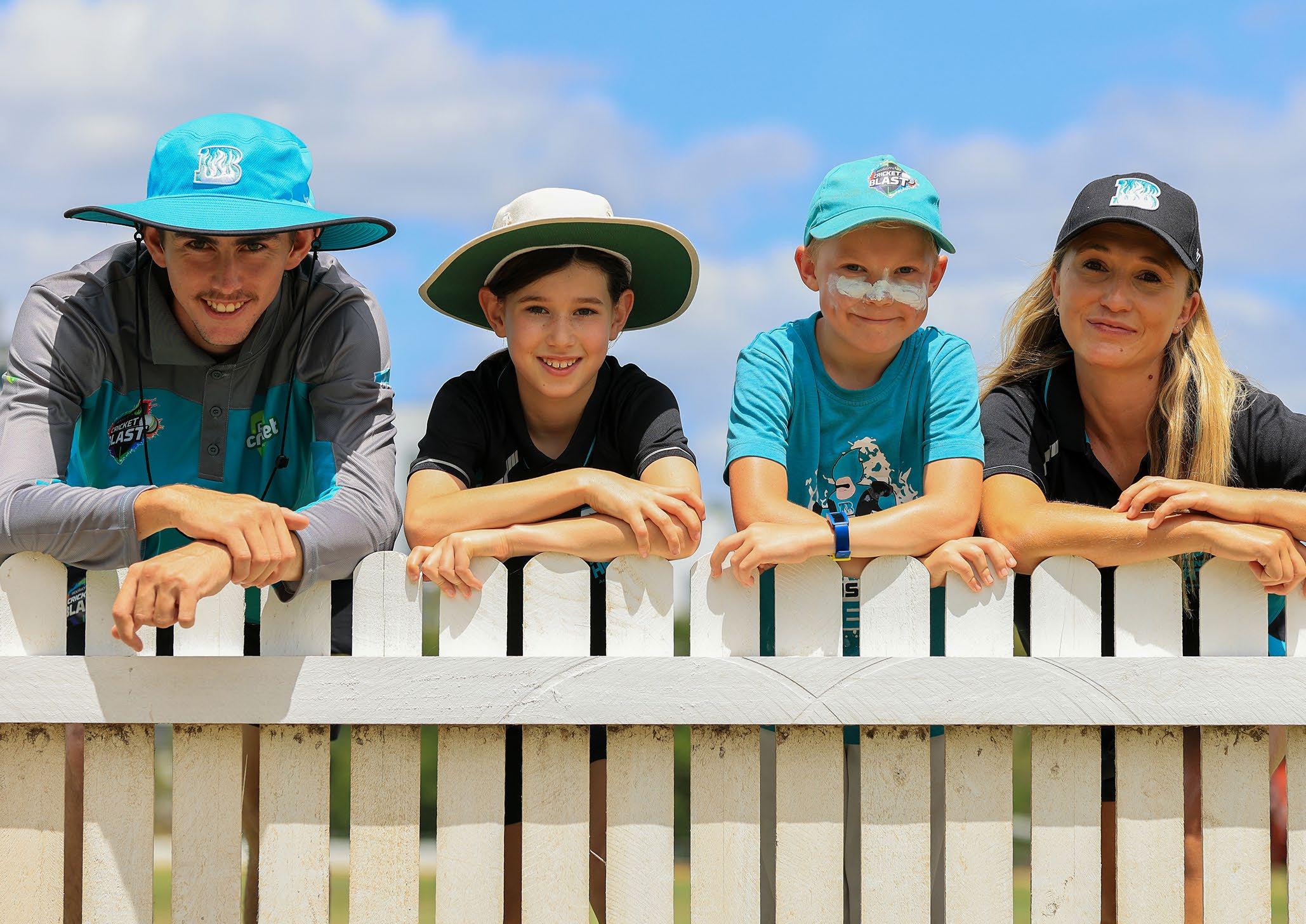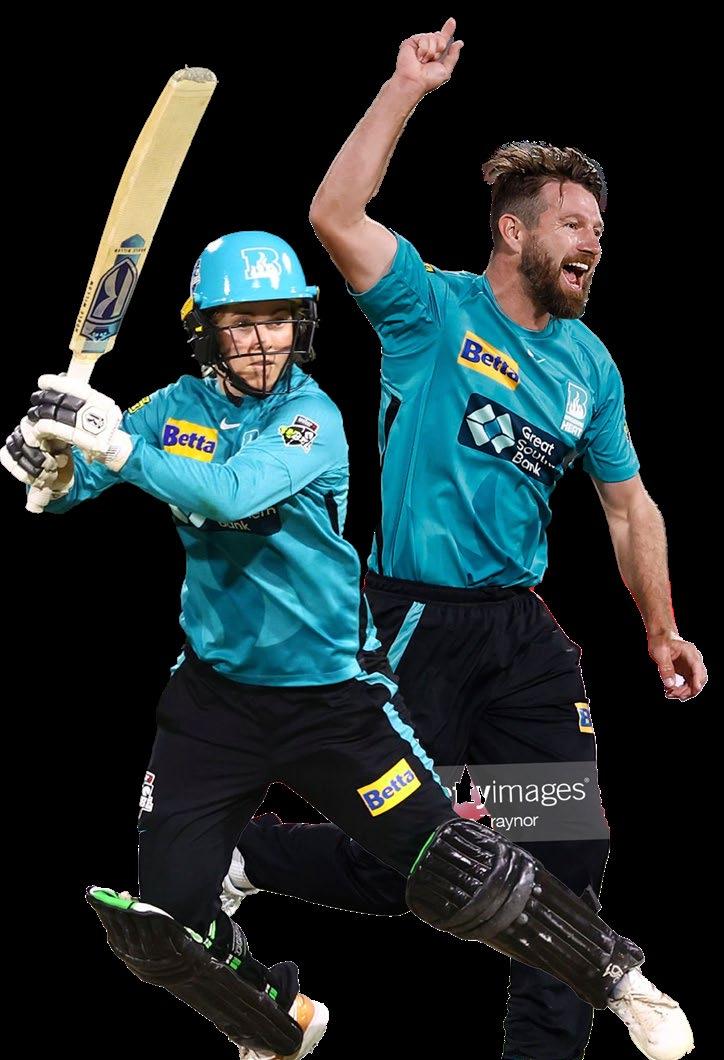
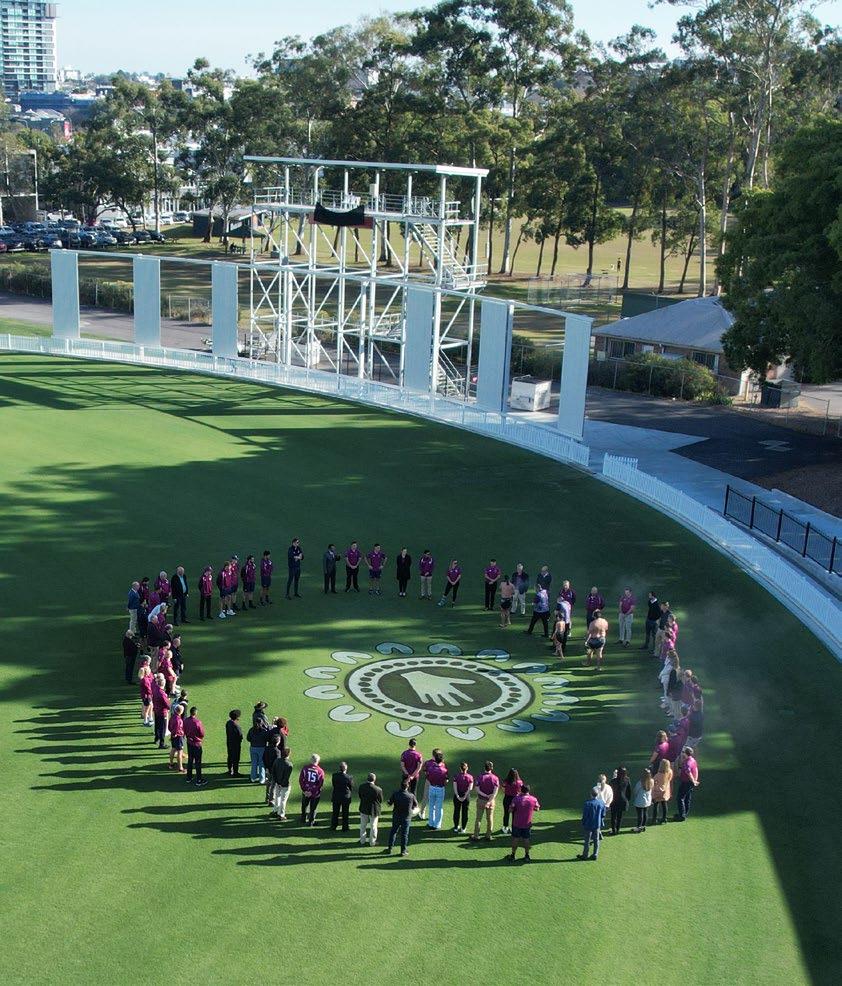





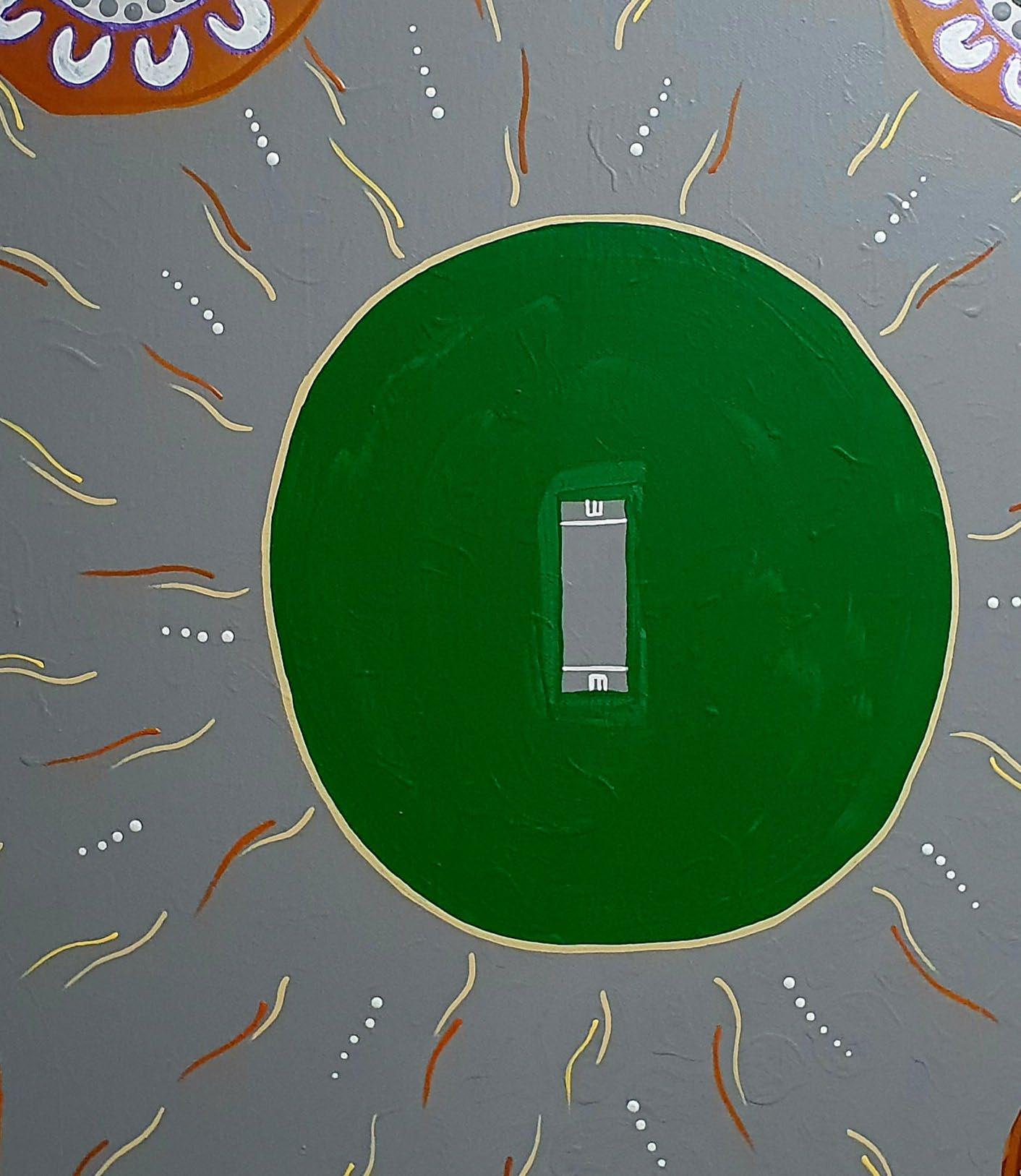
Queensland Cricket acknowledges and pays respects to the Traditional Custodians of the land and waters encompassing the country where we are privileged to live, work, and play the great game of cricket on the land now known as Queensland.
We recognise and celebrate the spiritual and ongoing connection of the Traditional Owners to culture and Country and acknowledge all Elders past, present and emerging.

We commit ourselves to the ongoing journey of reconciliation, so that together we may bring about equity and equality, fostered by strong and trusting relationships.
We shall cherish shared wisdom and grow with guidance as we walk together towards a reconciled country.
As I complete my final report in this role, it gives me much pleasure to reflect on the concerted passion and commitment that Queensland Cricket and its community has displayed.
It has been a privilege and an honour to have served as Chair of Queensland Cricket since taking over from Sal Vasta in 2019.
During my tenure, we have been confronted by challenges both old and new. These have included widespread changes to day-today life forced by the global pandemic, the devastation that flooding caused throughout the State at various times, difficult financial conditions, and the flow-on impacts to our sport.
The impact of COVID-19 during this period created major upheaval in the way that cricket is administered, played, and ultimately experienced.
Cricket continues to recover, with some areas of the game returning to, and exceeding preCOVID benchmarks. Others have been slower, with the fallout from stalled participation during the periods of social restriction meaning that aspects of junior participation have suffered from a ‘lost’ age bracket.
The realignment of Australian Cricket’s financial resources during COVID meant that it has been a slow return to what States and Territories advocate as the ideal funding model. However, it was pleasing to note the decision by the Board of Cricket Australia to endorse the restoration of funding for the 2022-23 season to 100 percent for States and Territories.
Also pleasing for cricket’s overall health was the successful completion of the latest Memorandum of Understanding between Cricket Australia and the Australian Cricketers’ Association. The resulting uplift in player salaries for male and female players, and greater investment in infrastructure and other crucial aspects of the game at the grassroots, have provided us with a stable base to develop and grow.
The 2022-2025 Queensland Cricket Strategic Plan was officially introduced during the reporting period and is shaping our operational priorities and budgeting.
The Plan has been developed around a new organisational purpose: to promote and grow cricket ensuring all Queenslanders can play, participate, and enjoy the game.
Our vision – To be Queensland’s leading sport – remains the same.
The latest strategic plan aligns with Cricket Australia and is built around five pillars that have been identified as keys to cricket’s
growth in Queensland. These pillars are:
· Grow Participation
· Better Teams, Players and Coaches
· Entertainment
· Organisational Capability
· Infrastructure and Facilities
The decisive work of CEO Terry Svenson and his executive leadership team has got the Strategic Plan away to a strong start and the Board is confident that the outcomes that will emerge from this will further position Queensland Cricket as a market-leader.
We have been privileged to witness a series of events during the past 12 months that both recognise and congratulate past high achievers and strengthen the ties to our history as we close in upon 150 years of cricket in Queensland.
The start of the 2022-23 season featured the return of the redeveloped Allan Border Field precinct to operational status following its official re-opening earlier in 2022. The $19 million project was supported by the Australian and Queensland Governments, Brisbane City Council, Cricket Australia and Queensland Cricket.
Since the reopening, there has been a series of naming ceremonies for various parts of the facility including Champions Corner (recognising the State’s victorious women’s teams), the Judy Harris Scoreboard, the Graham Dixon Gates, Melissa Bulow Terraces, the Katherine Raymont End, and the Eddie Gilbert End.
In a similar vein, as part of the on-going recognition and acknowledgement of individuals who have made lasting changes to Queensland Cricket, several awards that characterise on and off field excellence were presented at this year’s QC Awards Dinner. Awards were named in acknowledgement of former Australian and Queensland players Jimmy Maher, Jodie Purves, Kirsten Pike, and the late Andrew Symonds.
The Queensland Bulls Player’s Player now receives the Andrew Symonds Medal, an award voted on by Bulls squad members for the player who best represents the team’s values of teamwork, honesty, and mateship.
The Jodie Purves Trophy is a new award that has been created to recognise the best Queensland female performer across all formats to run alongside the Ian Healy Trophy
CHRIS SIMPSONas the best male player for the Queensland Bulls.

The Jodie Purves Trophy will see player-voted points gained across Queensland Fire and Brisbane Heat performances in the WNCL and WBBL, culminating in an overall Player of the Year to complement the Queensland Fire Player of the Year and Player’s Player Awards.

The significant contribution of former Queensland and Australian players Kirsten Pike and Jimmy Maher to charities and community cricket has been recognised with the establishment of the Pike –Maher Community Medal.

The award recognises the Queensland male or female cricketer who played a major role in creating a positive difference in Queensland’s communities through charitable and community contributions.
The winners of these and other major awards from the 2022-23 season are acknowledged elsewhere in this report, but on a personal level, the conferral of these honours was a highlight for myself and fellow directors.
Warmest congratulations are extended to players who achieved major individual career milestones during the year. Laura Harris became the latest 100-gamer for the Brisbane Heat, bringing up her milestone in style during the Weber Women’s Big Bash League. Likewise Jimmy Peirson reached 100 BBL games for the Heat during the summer, with both players achievements celebrated at match.
Joe Burns joined elite company when he completed 100 first class games for Queensland, the 16th Queenslander to achieve such impressive longevity in the sport.
It was also a joy to present our latest Life Member with his badge at the most recent Annual General Meeting. Michael Kasprowicz typifies what Life Membership
is designed to celebrate, having devoted much of his life to advancing the game, as a player, past player, coach, commentator, volunteer and administrator.
An important evolution in the life of Queensland Cricket took place at a Special Meeting of Members that followed the AGM on 13 September 2022.
A new QCA Constitution was approved at this time, another significant step in the on-going growth and development of Queensland Cricket.
Based on the recommendations of the Constitution Working Group, it was modernised to reflect the requirements of the Corporation Act 2001, reviewed and updated the QCA Objects and allowed for the provision of an additional Appointed Director to allow for the provision of skills, experience and diversity required for the Board in the lead up to the 2032 Olympics to be held in Brisbane.
My deepest thanks go to the Working Group headed by Deputy Chair Kirsten Pike, Director John Salter, FGAR Committee Member John Keating and CQCI president Greg Michel with support from John Mullins of QC’s Legal Adviser Mullins Lawyers.
As a result of the return to almost normal operation, the Premier Grade Clubs made representation to the Board for consideration of a new funding agreement to support the additional costs and services required to operate and deliver the key pathway competition over the next five years.
The Board recognised the importance of this issue and resolved it be considered in FY24.
The Board held six meetings during the year and given the reduced COVID restrictions all meetings were held in person, with an option for electronic attendance offered.
At the September 2022 AGM, the Chair recognised and thanked Director Tom Frankling for his significant contribution to Queensland Cricket following almost 11 years of service to the organisation, after he elected not to seek an additional term.
Deputy Chair Kirsten Pike was reappointed as a Director for a further three-year term and the Board welcomed a newly appointed Director in Townsville-based Darren Frakes. Darren is a former Queensland Country captain and current Treasurer of Queensland Country Cricket. He is an Owner Manager of a Bank of Queensland branch in his home city.
In December the Nomination Committee recommended to the QC Board the reappointment of appointed Director Juanita Maiden for her second term as appointed Director.
The 2023 QCA AGM will see new Directors appointed after Barry Jansen and Juanita Maiden stood down from the Board during the year. We thank both Juanita and Barry for their respective contributions to the Board and to Queensland Cricket.
During the year, the Board was pleased to have regular interactions with Brisbane-based Cricket Australia Director Greg Rowell. We thank him sincerely for his guidance and


advice, and his on-going commitment to Australian Cricket.
There were many weighty and challenging matters considered by Directors during the year.
These included ongoing discussions on the National Redress Scheme across Australian Cricket; the roll out of the Board endorsed Australian Cricket Child Protection Policy, planning for an updated Affiliate funding and governance structure, investment decisions with regard the progress of the QC Future Fund through our managers Morgan Stanley, and the progress of the renovated AB Field and the curatorial services supporting the new infrastructure.
In closing, wish to again thank all of colleagues, past and present, who have had the opportunity to serve with on the Board. Your support, insights and camaraderie have made it an enjoyable four years, and a period that I will look back on with great satisfaction at the tasks and challenges we have met and successfully overcome.
There was a distinct sense of progress throughout Queensland Cricket in 2022-23, with high points, improvements, and a shared sense of resolve evident in many of our achievements.
The commitment to realising key actions from the first year of our current Strategic Plan was successfully met due to a concerted effort from the entire organisation. The positive outcomes to emanate from this approach have provided Queensland Cricket with a sound base from which to meet future challenges and opportunities.
Highlights have come in the participation space and elite cricket performances, while infrastructure spending and investment Statewide was again noteworthy.
Queensland Cricket finished 2022-23 on a sound financial footing and was able to prudently fund our cricket aspirations and deliver on our commitments to the game at the grassroots level.
The looming presence of the 2032 Olympics and Paralympics in Brisbane will be front of mind for the foreseeable future, with displacement concerns and question marks around the eventual future of the Gabba and Allan Border Field uppermost in our thinking. The Chair and I briefed cricket stakeholders in August 2023 and a copy of that communique is presented elsewhere in this document.
The delivery and launch of Queensland Cricket’s first Reconciliation Action Plan was warmly received in 2022-23.

As outlined elsewhere in this report, the Innovate RAP was the culmination of more
than 12 months collaboration between First Nations representatives and the QC Board and staff.
The hard work and input from our First Nations Cricket Advisory Committee, especially Co-Chair Jason Smith, and Queensland Cricket’s First Nations Project Officer Kieran Gibbs was acknowledged at the launch event at Allan Border Field which also featured the naming of the Eddie Gilbert End of the venue.
Queensland Cricket was able to again return a modest surplus for the year. It achieved a surplus of $863,000 in FY23, which includes a $246,000 increase within the QC Future Fund. This means that there is an operating surplus of $617,000 available to reinvest in the game.
The Directors considered several recommendations and chose a reinvestment of $500,000 into the Future Fund and take-up of the $117,000 in regular operations.
The surplus of was driven in part by a return to full 100% funding from Cricket Australia which was finalised just as the season got underway. Discussions are continuing between Cricket Australia and the States and Territories on future funding agreements.
The Queensland Cricket Future Fund completed its second year, though the fund was not immune to market challenges. We will continue to make selective investments to build further financial sustainability.
The QC Foundation continues to generate and distribute important funding across its established pillars of operation. The
Summer of Cricket luncheon, the successful launch of the Buy-A Picket campaign and auction of signed Indigenous playing shirts by the WBBL and BBL Heat players helped raise significant sums, with the Foundation supporting an array of meaningful cricket and community campaigns.
The Brisbane Heat club assisted with raising more than $50,000 across the WBBL and BBL seasons for charities, cricket clubs, and the Foundation.
The Brisbane Heat produced a memorable summer in the Weber Women’s Big Bash League and KFC Big Bash League as they delivered on our purpose to Bring Families Together and Entertain and Inspire our fans.
Across the WBBL and BBL, they played in more home cities and venues across Queensland than ever before, with games held in Brisbane, Gold Coast, Mackay, Cairns, providing more fans with the opportunity to see their heroes play live. This again delivered on Queensland Cricket’s oft-stated commitment to take elite cricket to the regions.
The return to regular scheduling after two challenging and disrupted summers saw the Heat host its biggest crowds at the Gabba and Metricon Stadium since our pre-Covid seasons, while we welcomed a sold-out crowd to Allan Border Field for the WBBL, and a close to near capacity crowd to Cazalys Stadium in Cairns for the club’s first home BBL game outside of South-East Queensland.
With new initiatives such as International Player Draft helping to recharge the BBL, broadcast numbers also received a timely
boost. The KFC BBL Final between eventual champions Perth and Brisbane was the most-watched game of the season and most-watched BBL game since the BBL|10 Final.
It was the most-viewed BBL game ever on FOX and attracted a national TV average of nearly 1.4 million viewers across FOX, Channel Seven and streaming.
The BBL retained its mantle as the mostwatched domestic competition in Australian sport on a per-game basis, while the WBBL remains the fourth-watched behind the BBL, AFL and NRL (minimum of 20 games).
A highlight of the BBL season was the launch of the New Year’s Bash, a marquee game held by the Heat to kick off the new year on January 1, with music acts including Peking Duk, Ball Park Music, plus KLP and Stace Cadet brining entertainment and energy to the Heat’s biggest crowd of the summer.
The steadfast efforts of volunteers again underpinned cricket’s steady recovery from the COVID years, with Queensland making positive progress across its grassroots.
The 2022-23 period saw a positive bounce back, with strong year on year growth in Woolworths Cricket Blast. Entry level participation grew by 7.74%, with girls’ participation growing by 19% supported by an $80,000 funding grant from Cricket Australia through the Growing Cricket for Girls Fund.
The Queensland Government and Cricket Australia were valued partners of Queensland Cricket in helping drive participation in regions where affordability
is considered a barrier. Funding grants were received from the State Government and CA to subsidise programs in Logan, Ipswich, and parts of Central Queensland
A Woolworths Cricket Blast reform is a strategic priority for Australian Cricket in 2023-24, with areas such as general brand awareness, program structure, school participation, and general promotions considered key in driving Cricket Blast and junior cricket growth.
Ensuring cricket is a sport all Queenslanders can play and enjoy was a priority for Queensland Cricket. In 2022-23, QC implemented programs and strategies aimed at increasing participation and growing engagement for women and girls, First Nations, all-abilities, and multi-cultural Queenslanders.
Indigenous participation grew by 37% in 2022-23, largely contributed to by Cricket Australia’s Woolworths Cricket Fund that allowed QC Community Cricket staff to deliver junior programs through several Indigenous communities and schools.
Queensland Cricket celebrated the performances of its volunteers acknowledged at the Cricket Australian Awards
There were six individual or clubs/ associations who received national recognition and their efforts, as well as other Queensland high-achieving volunteers, are outlined in depth in the Community Cricket section of this report.
The 2022-23 Australian Cricket Infrastructure Fund saw $1,120,257 committed towards 80 projects with
approximately 50 percent allocated to regional areas. The ACIF backing contributed towards $8,102,878 worth of projects.
There was a large focus on improving amenities, practice nets and hard wickets to help sustain anticipated participation growth over the next two to five years.
Among the successful ACIF candidates were the Paroo Shire Council in Cunnamulla that applied for funding for a new outdoor cricket practice facility, lighting of Rockhampton Brothers training facilities, a new synthetic pitch for Gladstone Cricket Association, renewed training facilities for Maryborough District Cricket Association and upgrades to Sandgate-Redcliffe’s training complex at Deagon, including lighting.
Queensland Cricket, with the support of Cricket Australia, has also revealed a new funding initiative for 2022-23.
The Cricket in Schools - Infrastructure Improvement Program, as part of the ACIF, is a school specific funding round that aims to grow community cricket through the development of more cricket facilities for schools and cricket club use.
The $165,000 commitment to minor infrastructure grants, enables schools to receive funding up to $10,000 or 50% of the total project cost under $20,000.
There were 19 schools successful in the 2022-23 round, with 12 located outside of the South East corner.
This initiative forms part of the new Queensland Cricket Schools Strategy which includes participation initiatives, purchasing cricket equipment for schools, umpiring
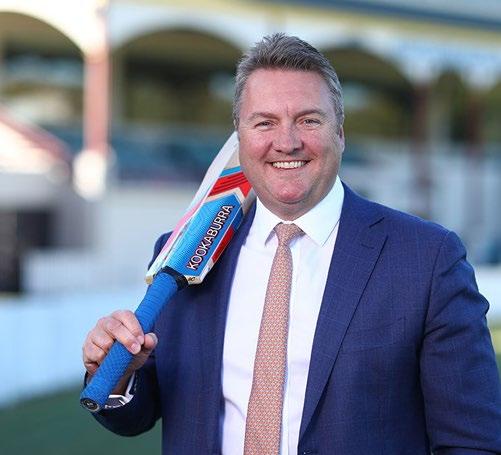
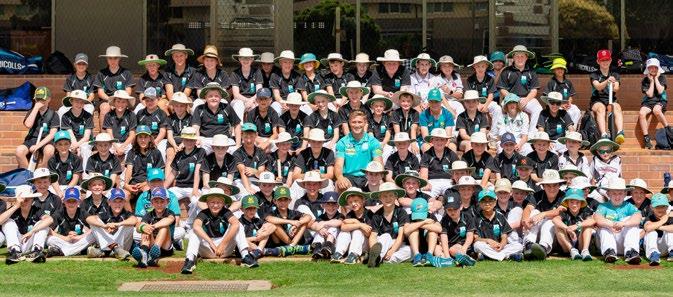
courses and infrastructure support. Other notable infrastructure elements included:
•$250,000 was secured via Cricket Australia’s Natural Disaster & Flood Recovery Fund to Clubs flood affected in 2022.
• The Queensland State Government Minor Infrastructure Round saw over $800,000 awarded to community cricket Clubs.
• More than 80% of accessible cricket facilities across Queensland have now been audited by our team as part of our State Facility Audit, the first since 2016.
Queensland teams produced a string of impressive performances around the country in the 2022-23 season.
The WBBL Brisbane Heat captured new fans and rewarded their existing supporters with another consistent season. With early season games in Mackay proving popular again, the Heat also made a triumphant return to Allan Border Field to sell out their opening game at what is their spiritual home in Queensland.
The Heat celebrated 100 games for Laura Harris, who made the most of the occasion to hit the second fastest 50 of all time in the WBBL as she swept Brisbane to a win over Hobart. Georgia Redmayne, captain Jess Jonassen, NZ star Amelia Kerr and pace bowler Nicola Hancock were all named in the official WBBL|08 team of the tournament.
Brisbane made the Finals for the fifth year in a row, ultimately losing in the final over of the preliminary final to Adelaide Strikers, who went on to defeat the Sydney Sixers in the Final.
In the BBL, a new-look Heat line-up started its season with an historic opening game at Cazalys Stadium in Cairns, the first time a Heat BBL match has been played away from either Brisbane or the Gold Coast in Queensland.


It was the start of a roller-coaster season for the Heat, which underwent several line-up changes, before commencing an incredible run of victories in the back end of the tournament which saw captain Jimmy Peirson register his 100th game for the club.
Brisbane won a remarkable seven out of its last eight games, including three suddendeath Finals, to qualify for the Decider at Perth’s Optus Stadium.
The Heat lost a thrilling final to the Scorchers in the last over before nearly 54,000 fans, but the team’s charge through the final series produced outstanding broadcast and streaming numbers as viewers backed their never-say-die approach.
Along the way, there were a host of achievements, on and off the field.
The Heat produced their highest team score, 5-224 against the Sixers, while Michael Neser was the second leading wicket-taker in the BBL, first season player Josh Brown hit the second most sixes (20) in the competition and there were two century partnerships (Jimmy Peirson and former Gold Coaster turn English star Sam Hain, and Usman Khawaja with Marnus Labuschagne).
The Queensland Fire and Queensland Bulls missed out on Finals spots in the Women’s National Cricket League and Marsh One Day Cup, with both teams firmly in contention coming into the final rounds.

The Bulls finished fourth in the One Day Cup, capped off by a thrilling win over NSW at the Gabba with a line-up featuring four debutants, while the Fire took out third spot after losing its final round series to South Australia which finished second to eventual champions Tasmania.
During the summer, Fire batter Laura Harris set a record for the fastest century in the WNCL, hammering 100 off just 50 balls against the ACT Meteors.
Queensland finished a clear third in the Marsh Sheffield Shield and will note the four draws that ultimately consigned them to miss the Final after being in contention coming into the last round against Tasmania. One of those draws came with the Bulls charging to victory against NSW in Sydney before bad light ended play.
The Bulls had two outright wins at Allan Border Field – over Tasmania and Victoria – and two victories at the Gabba against NSW and South Australia.
Batsman Joe Burns became the 16th male player to achieve 100 first class matches for Queensland during the season and his feat suitably celebrated at the QC Awards Gala at the end of the season.
Representative honours were conferred on several Queensland players during the summer. In the Test arena, Queensland was well represented in the Australian Test team with Marnus Labuschagne, Usman Khawaja, Mitchell Swepson, Matthew Renshaw, and Matthew Kuhnemann selected in the squad to tour India.
Matthew Renshaw earned selection in the Test XI while Matthew Kuhnemann made his Test and ODI debut. Kane Richardson also represented Australia during that period.
Jimmy Peirson, Matthew Renshaw, Mitch Swepson, Xavier Bartlett and Brisbane
Heat players Spencer Johnson and Nathan McSweeney were also chosen to tour New Zealand in April to play New Zealand ‘A’ in a pair of first-class games.
WBBL Heat and Fire captain Jess Jonassen and Grace Harris were both important contributors in the Australian Women’s T20 World Cup winning team and the successful Ashes campaign during 2023. Both players, as well as Laura Harris played in the inaugural Women’s Premier League in India as well.
Queensland completed a strong season in Youth cricket, with the Under-17 boys team collecting the national title with victory in Hobart in January and the Under-19 Qld Metro side finishing second after losing the Final to NSW in Adelaide in December. At the same tournament, Queensland Country Under-19 finished seventh, with an improved showing to win three games in just its second appearance at the national titles.
Several Queensland players also featured in the Australian Under-19 squad that played a series against their English counterparts in Brisbane, with Hugh Weibgen, Callum Vidler, Lachy Aitken, and Tom Balkin all contributing solid performances.
Queensland was unable to win back-toback Betty Butcher Shields at the National Under-19 women’s titles in Perth but gave a competitive account of itself with a squad
that will have the bulk of its players eligible again next season.
Bundaberg’s Lucy Hamilton and Townsville product Sianna Ginger were selected for the inaugural ICC Women’s Under-19 World Cup in South Africa in January where Australia made the semi-finals.
Finally, the return of the National Indigenous Cricket Championships in Alice Springs in February after a two-year absence due to the pandemic produced an historic first title for Queensland.
The Queensland Women’s Aboriginal and Torres Strait Islander squad went through the titles unbeaten, with captain Chris Coulson finishing as the leading wicket-taker and Mackay’s Tracee Williamson the player of the final.
The men’s Aboriginal and Torres Strait Islander squad had injury and illness concerns around the tournament but finished fifth with some good wins amongst their campaign. As outlined elsewhere in the report, there was a strong Queensland contingent in the National Indigenous squads that toured Vanuatu in April.
Queensland Cricket remains extremely grateful for the support we receive from our commercial partners.
In 2022-23, we welcomed some new sponsors into the Queensland Cricket family including Primo and Containers for Change.
Our partners play a critical role in assisting the Heat live our purpose to Bring Families Together and Entertain and Inspire. Some of the highlights of the summer came through our game-day initiatives that were supported by our sponsors, including the Great Southern Bank House Party, Betta Boom Box, Betta Ball Blast and the Drinking Never Drive Innings Break spectacular, developed in partnership with the Department of Transport and Main Roads. We express our thanks to Principal Partner Great Southern Bank, Major Partner Betta Home Living, and official sponsors National Storage, the Department of Transport and Main Roads, Toyota, Primo, Cross River Rail, KFC, Coca Cola, Containers for Change, Kookaburra, Masuri, Nova, Channel Seven The Courier Mail and Foxtel. Finally, thank you our cricket community for your support and help in bring the 2022-23 summer of cricket to life. We are pleased to report that our game and organisation continues to have a positive outlook, and we look forward to working with each of you to secure the future for cricket in Queensland.
TERRY SVENSON Chief Executive Officer
Queensland Cricket’s inaugural Innovate Reconciliation Action Plan was launched in June 2023, completing a 12-month development of the document.

The process was initially begun by engaging KPMG’s Indigenous Services team to help identify priorities and core principles before setting forth on the pathway to creating our RAP.
Queensland Cricket then progressed its RAP development through Reconciliation Australia, an independent not-for profit organisation which is the lead body for reconciliation in Australia.
It promotes and facilitates reconciliation by building relationships, respect and trust between the wider Australian community and Aboriginal and Torres Strait Islander peoples.
Since 2006, Reconciliation Action Plans (RAPs) have enabled organisations to sustainably and strategically take meaningful action to advance reconciliation.
Based around the core pillars of relationships, respect and opportunities, RAPs provide tangible and substantive benefits for Aboriginal and Torres Strait Islander peoples, increasing economic equity and supporting First Nations selfdetermination.

The four RAP types – Reflect, Innovate, Stretch and Elevate – allow organisations to continuously develop their reconciliation commitments.
Queensland Cricket has produced an Innovate RAP, which runs two years.
As outlined in the final document, Queensland Cricket’s vision for Reconciliation is to inspire Aboriginal and Torres Strait Islander people as part of the wider Queensland community to unite and connect with non-Indigenous people through a love of cricket.
The actions from the RAP will drive the growth of cricket and as well as wider outcomes for First Nations communities.
It will create opportunities for Aboriginal and Torres Strait Islander boys and girls to learn and love the game in the future, and hopefully gain the many benefits that emerge from playing sport.
Queensland First Nations Cricket Advisory Committee Co-Chair Jason Smith expressed his satisfaction at the delivery of the State’s first RAP.

Smith, a member of the inaugural Indigenous Cricket Advisory Committee formed in 2003 and a representative on Cricket Australia’s National Aboriginal and Torres Strait Islander Cricket Advisory Committee, said the RAP provided a strong framework and voice for the future.

“It is exciting to see Queensland Cricket develop respect and understanding

for Aboriginal and Torres Strait Islander peoples. Understanding our histories and cultures has been the key core value in creating this RAP,’’ he said.
“Sport has the power to heal and strengthen communities and our message of reconciliation can reach and resonate with many people,’’ Smith said.
Queensland Cricket’s Reconciliation vision statement recognises and respects Aboriginal and Torres Strait Islander peoples and values their diversity. We acknowledge Aboriginal and Torres Strait Islander peoples as the Traditional Owners and Custodians of the country on which we live and operate, now called Queensland.
We acknowledge the special relationship and connection that Aboriginal and Torres Strait Islander peoples have with lands, places and cultures.

Our vision for Reconciliation is to inspire Aboriginal and Torres Strait Islander people as part of the wider Queensland community to unite and connect with non-Indigenous people through a love of cricket.


Queensland Cricket (QC) is actively working to increase the participation of Aboriginal and Torres Strait Islander people at all levels of the sport as well as the cultural competency of its staff to create an environment where First Nations people are welcome and supported to be in.
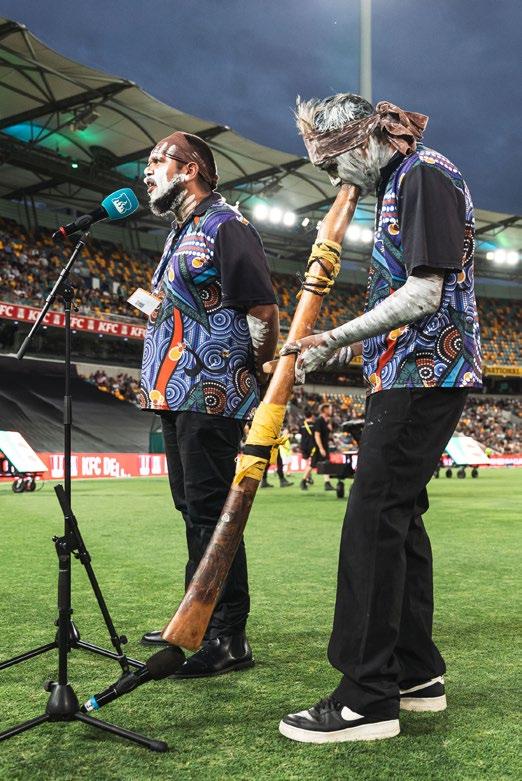
This is aided by QC having been and currently being represented by Aboriginal and Torres Strait Islander people in the elite levels of cricket.
On the ground, QC is delivering a range of Eddie Gilbert Talent ID and Woolworths Cricket Blast sessions targeting Aboriginal and Torres Strait Islander communities. Now the organisation is working to identify opportunities to engage further with Aboriginal and Torres Strait Islander people and players to achieve their goal of 4.8% participation in Entry Level Programs. This is higher than the population demographic and affirms QC’s desire to welcome Aboriginal and Torres Strait Islander people into the sport.
In recognition of QC’s existing Reconciliation initiatives, we would like to strengthen our commitment through the implementation of an Innovate RAP. This has received widespread support through our First Nations people player group, employees and endorsement from our CEO and Chair.




Queensland Cricket’s strategic plan is a comprehensive document outlining the future of the organisation.
Key to this are the vision, purpose and values outlined above. Improved engagement with Aboriginal and Torres Strait Islander communities aligns with our pillars and will assist in meeting these aspirations. Key strategic goals under these areas involve: Sustainable Participation growth, Better Teams, Players and Coaches, Entertainment, Organisational Capability, and Infrastructure & Facilities.
Genuine and positive engagement with Queensland’s Aboriginal and Torres Strait Islander communities should feature within each of the outlined goals, they align with Reconciliation Action Plan targets and Queensland Cricket will be well placed to build on this into the First Nations community space.

The re-launch of the Queensland Cricket Foundation remained a priority project for Queensland Cricket in 2022-23. The year was focused on driving major fundraising campaigns and re-investing into community initiatives that create positive differences in Queensland communities. Highlights included the Summer of Cricket Lunch that was headlined by Usman Khawaja, Matthew Hayden and Ryan Harris that raised over $40,000 for the Foundation, and the Buy A Picket campaign that was launched in 2022.
The Buy A Picket campaign allows cricket fans and stakeholders to own a piece of cricket in Queensland by having a supporter’s name inscribed onto a picket at the recently renovated Allan Border Field. The campaign has so far raised over $100,000 to be reinvested into the community.

The Foundation welcomed contributions from our commercial partners, including a $10,000 donation from Primo to be invested across initiatives in all-abilities and Indigenous cricket. Brisbane Airport Corporation contributed to the Jodie Purves Young Cricketer Development Scholarship, aimed at providing cricketing support for a rising female cricketer from regional Queensland, while Gallus Partners were a major partner of the Summer of Cricket Lunch.
The Foundation’s philanthropic efforts extended beyond cricket, with money raised at Brisbane Heat games donated to Deadly Choices as part of the club’s First Nations Round, Juiced TV, and local community cricket clubs through the 50:50 match-day charity program.

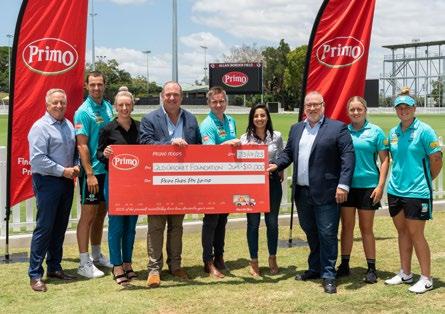

Upcoming fundraising initiatives for the Foundation include QC’s inaugural Golf Day in partnership with the Bulls Masters, the continuation of the Buy A Picket program, and the return of the Summer of Cricket Lunch.

Highlights of initiatives funded by the QC Foundation include:

- The Jodie Purves Young Cricket Development Scholarship for female cricketers from regional Queensland.

- A contribution to the Western Rivers Cup for competition support, Queensland’s biggest Indigenous cricket carnival.


- Equipment for the Nepalese Cricket Competition.
- A donation to mental health charity Trade Mutt.



Queensland Cricket is thankful to our commercial partners for their ongoing support that allows us to live our purpose of promoting and growing cricket in Queensland.
QC is also proud of the role we play in helping to grow our partners through the reach and cut through our teams and brands provide. The is perhaps illustrated best in the strategy of the Brisbane Heat’s Principal Partner Great Southern Bank who utilise their Heat sponsorship to live their purpose of helping all Australians own their own home.
Great Southern Bank enjoyed success at the Australian Marketing Institute (AMI) and Australian Effie Awards for their Heat sponsorship.
Great Southern Bank scooped the pool at the AMI Awards, picking up major gongs as winners in the National Event or Experiential Marketing and National Sponsorship Effectiveness categories.
The award for National Event or Experiential Marketing was won for the Great Southern Bank House Party – a VIP activation space at the Gabba that continues to the place to be on game day.



To complement the two major gongs, Great Southern Bank has also claimed a State Award for Brand Revitalisation at the AMIs and a Bronze Challenger Brand Award at the Effies. The AMI and Effie Awards recognise marketing effectiveness and excellence across Australia.
The Heat welcomed a new major sponsor into the club’s family this summer with Primo signing on across our WBBL and BBL teams. Primo’s brand can be seen on the Heat’s cap and helmet, plus training apparel and grass signage at matches.

National Storage’s commitment to QC and the Heat will extend into a 10th year after a two-year sponsorship extension was announced in December. True to the Heat’s ‘One Club, Two Teams’ principal, the sponsorship will see the National Storage brand featured on the sleeve of the club’s WBBL and BBL team playing kit.
The Heat also announced a new partnership with recycling scheme Containers for Change. The Heat supported Containers for Change positive recycling message through match-day and digital content, while bottles and cans collected at Allan Border Field saw money raised through the scheme donated to the Queensland Cricket Foundation.
Queensland Cricket gratefully acknowledges the assistance and backing it enjoys from several organisations of like-minded cricket enthusiasts and supporters. These groups directly support the growth of cricket across Queensland through performing important tasks within the wider community, as well as providing cricket with enviable role models in terms of their generosity and breadth of spirit.
The group of past Queensland cricket greats which help foster and develop cricket and assist local charities throughout Queensland regional communities. They play regular matches around Queensland and provide coaching and community outreach at each venue. The Bulls Masters came on board as an official Queensland Cricket sponsor in 2018-19.

The ACSQ is an official associate of Queensland Cricket. Its goal is: to provide a convivial “cricket lover’s” forum that promotes lasting friendships and a greater understanding of the cricketing world, past and present. It assists several charitable and cricket initiatives.
We thank the commitment of the Peter Burge XI and its members:

Doug Barton
Peter Bell
Tony Coutts
Peter Evans
John Gowdie
Spencer Grammer
Graham Oldham
John Pearce
Richard Williams
Mick Power AM
Tim Prest
Peter Chisholm

The Queensland branch is part of a national network of cricket lovers who raise funds exclusively to help the young and disadvantaged achieve their sporting goals. This support includes cricket for the blind and visually impaired, cricket for those with a disability, cricket for the deaf and Indigenous cricket.
In 2022-23, Tavnerners Queensland supported the Under-17 Premier Cricket competiton and put in place a partnership with mental health support network
Outside The Locker Room for Queensland Premier Cricket clubs in 2023-24.

Originally formed in 1961 in Victoria as a loose collective of like-minded individuals with an interest in sport and good fellowship, it has grown into an international organisation that raises and distributes funds for the benefit of young athletes and organisations serving the community through sport. The Queensland branch was formed in 1981 and for more than a decade, has presented a rising young Queensland cricketer with the Bill Brown Medal on an annual basis.
The Club encourages young people to play and enjoy the game of cricket. It plays mid-week matches each summer, mostly against schools in the state’s south-east, and undertakes an annual 12-day playing and coaching tour of country centres.
The Australian Cricketers’ Association (ACA) is the collective and representative voice of past and present male and female elite domestic and international cricketers in Australia. Via the ACA Past Player Game Development Program and the ACA Premier Cricket Program, ACA Members help identify, instruct and inspire talent through both the male and female pathways.
The 2022-23 Australian Cricket Infrastructure Fund (ACIF) saw $1,120,257 committed towards 80 projects across the State with an aim of making cricket more accessible and inclusive for all Queenslanders.
Spread across two rounds, the ACIF contributed to $8,102,878 in improved cricket facilities and infrastructure.
Approximately 40 per cent of committed funding went to projects within regional areas, which included refurbishments, replacements, and upgrades of existing infrastructure.
Among the successful ACIF candidates were the Paroo Shire Council in Cunnamulla that applied for funding for a new outdoor cricket practice facility, lighting of Rockhampton Brothers training facilities, a new synthetic pitch for Gladstone Cricket Association,
renewed training facilities for Maryborough District Cricket Association and upgrades to Sandgate-Redcliffe’s training complex at Deagon, including flood lighting.
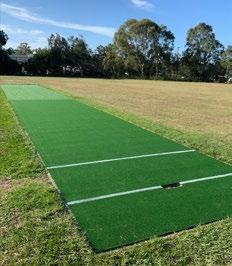
Queensland Cricket, with the support of Cricket Australia, has also revealed a new funding initiative for 2022-23.
The Cricket in Schools - Infrastructure Improvement Program, as part of the ACIF, is a school specific funding round that aims to grow community cricket through the development of more cricket facilities for schools and cricket club use.
The $165,000 commitment to minor infrastructure grants, enables schools to receive funding up to $10,000 or 50% of the total project cost under $20,000.
19 schools were successful in the 22-23 round, with 12 located outside of the South East corner.
This initiative forms part of the new Queensland Cricket Schools Strategy which includes participation initiatives, purchasing cricket equipment for schools, umpiring courses and infrastructure support.
The Cricket in Schools - Infrastructure Improvement Program also coincides with the second round of the Go for Gold Fund currently being rolled out by Queensland Government.
In a further boost for cricket infrastructure, 11 Queensland clubs and associations have been able to access $250,000 of funding as part of the National Disaster & Flood Recovery Fund.

QC and CA identified priority targets that had been affected by recent flooding, in particular the February 2022 weather event.
Queensland Cricket is currently engaged in a State Facility Audit – the organisation’s first since 2016 – and a critical project in shaping the development and design of cricket infrastructure into the future.
Among those able to implement rebuilding and flood-proofing projects were the following:
Loganholme Cricket Club
Valley District Cricket Club
Muddies Cricket & Recreational Club Inc
Logan Village Cricket Club Inc
Bulimba Cricket Club
Brookfield United Cricket Club
Fassifern Cricket Association
Wynnum Manly District Cricket Club

Mater Hill Cricket Club (Carina)
Additionally, the Queensland Government’s Minor Infrastructure funding round has committed almost $1 million to cricket to help support community sport and recreation.
Among the successful projects are $250,000 to Caboolture Sporting club to replace cricket nets at their Morayfield base, $250,000 to the Logan City Council towards
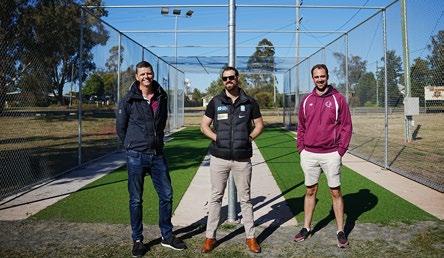
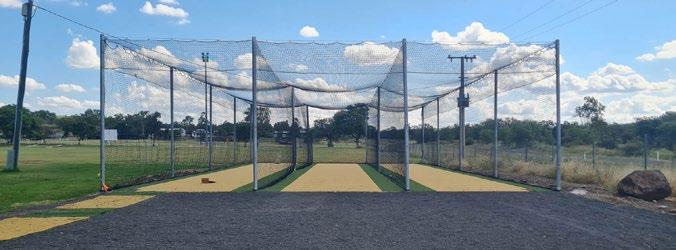
Tansey Park
Bancroft Park
Judy Holt Reserve
Newstead Oval
Colmslie Recreation Reserve
Brookfield State School
Coronation Park
Carmichael Park
Vince Herbert Oval
lighting of cricket facilities at Homestead Park and $130,000 to Cooroy-Eumundi cricket club to upgrade their training facilities.
The ACIF is a joint initiative between Cricket Australia, Queensland Cricket and the Australian Cricketers’ Association, through its contribution via the Grassroots Cricket Fund, that allows cricket clubs and
associations, schools and Councils to apply for funding to build and improve local cricket facilities and grounds.
The facility audit is used by the Queensland Government, Cricket Australia, and Queensland Cricket to determine which facilities need maintenance work and to prioritise investment.
With 75 per cent of the audit complete, QC will be able to provide clubs and associations with key outcomes and support, while also understanding opportunities to increase cricket participation and player enjoyment. Outcomes and project trends to date have included:
- Developing a greater understanding for clubs on mitigating environmental factors such as drought, flood, and bushfires.
- Club support for understanding and developing facility leasing agreements.
- Uncovering opportunities to develop cricket infrastructure in schools.
- Over 80 new sites across Queensland have been identified for cricket use.
Dear clubs, associations, affiliates, life members, past and present players, coaches, umpires, volunteers, sponsors, parents, fans, and supporters of Queensland Cricket.
As we enter the second half of 2023, and step-up plans for the 2023-24 season, it has become evident that cricket in Queensland is entering the most complex and uncertain era it has faced.
Like all Queenslanders, we proudly celebrated the announcement that Brisbane and South-East Queensland had been successful in securing the 2032 Olympic and Paralympic Games.
Queensland Cricket and Cricket Australia congratulated the Queensland Government on its commitment to develop a new world-class stadium at the Gabba as the centrepiece of both Games, tying together significant infrastructure investment such as Cross River Rail and the regeneration of the Woolloongabba precinct. However, there are significant unknowns around the Gabba project, including the level of detail that is needed by stakeholders about the decision-making process for both the Gabba and other related infrastructure projects.
The planning and the relevant timeframes for delivery of this critical infrastructure is now causing considerable uncertainty for cricket in Queensland, especially with regards to preparations for a seven-year period from 2025, which is when we expect the Gabba will be unavailable from.
This letter is to provide our cricket community with an update on a clear and factual outline of the status of these issues, and the steps we are proposing to key partners, including all levels of government, to identify solutions that will benefit all.
From the outset, Australian Cricket has proactively engaged with governments in the exacting and intricate process that surrounds major events such as the Olympic and Paralympic Games, a nation-building initiative that will have significant positive impacts on Queensland.
However, before that can happen, there needs to be greater clarity around the planning in the short, medium, and long-term.
The immediate priorities, from Cricket’s perspective, revolve around what measures need to be put in place between now and 2025 when the redevelopment of the Gabba is scheduled to commence, where we will play matches between then and 2032, and finally what sort of legacy will be left for cricket post-Olympics and Paralympics.
Importantly, our focus throughout this process is to not only maintain cricket’s presence in Brisbane but also identify opportunities to grow the game out to 2032 and beyond, and we are seeking support from governments at all levels to ensure this.
Regrettably, the level of detail surrounding the Gabba project’s timeframes has yet to be announced.
As a result, we face the real prospect of losing important Test and BBL cricket matches from Queensland to interstate venues during the pre-Olympic displacement from the Gabba and hold a reasonable fear that a suitable solution to enable continuity of matches in Brisbane may not meet our needs or expectations.
As a not-for-profit body, our concerns encompass the effect such uncertainty could have on participation throughout Queensland and the ensuing material financial impact across multiple areas of the sport, including at the grass roots level.
We are preparing ourselves for a worst-case scenario where cricket could face the loss of access to the Gabba for potentially greater than seven years during the period of demolition, construction, and post-Games return.
We are working to ensure that we are fully prepared for when the Gabba work is scheduled to begin in December 2025 following the Ashes Test at the venue.
At this stage, this will mean BBL matches in January 2026 will need to be played elsewhere, as will the remainder of the Sheffield Shield and One Day Cup seasons.
It has been speculated that the Gabba rebuild would be a four-year process. It has been suggested that cricket could be played at the venue post-2029 for at least a season before reverting to its Olympic Games configuration. As outlined below, this can only be achieved subject to key decisions being made about the long-term status of the pitch block.
In summary, Queensland Cricket and Cricket Australia will require fit for purpose venues between 2026-27 and 2029-30 seasons, and again between the 2030-31 and 2031-32 seasons.
We see the Allan Border Field precinct playing a major role in hosting more cricket while the Gabba is being redeveloped, while other options presently available to cricket will mitigate some of the displacement challenges, including Carrara Stadium on the Gold Coast and regional centres.
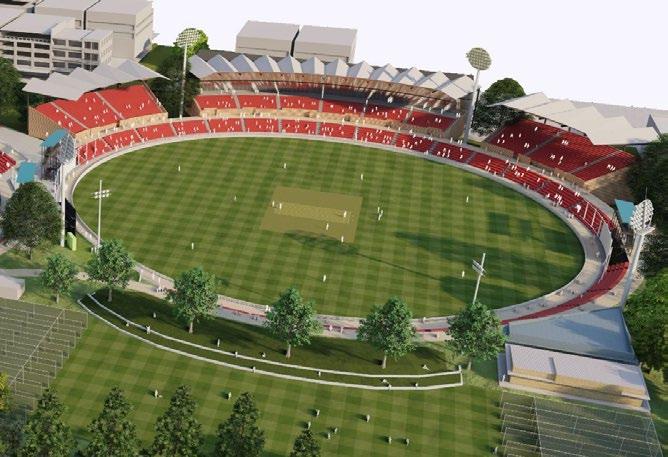
Queensland Cricket will strongly advocate for top level cricket (Test Matches, Women’s, and Men’s Big Bash League (W/BBL), ODIs, T20Is) to continue to be played in Brisbane during those seasons when the Gabba is unavailable.
The most efficient, cost-effective, and timely option to enable this is for Allan Border Field to be upgraded with a capacity of 10,000 permanent seats.
Allan Border Field already possesses a permanent wicket block and cricket-specific infrastructure such as sight screens, vision screen, field lighting, and broadcast requirements, as well as outdoor and indoor training facilities.
With additional seating capacity, it stands ready to meet the needs of cricket during an extended disruption period.
Allan Border Field currently hosts Women’s Internationals, WBBL and domestic cricket matches, and increased capacity would enable it to host BBL and Men’s International games, while remaining a boutique cricket venue with established green space and a continuing connection to our local community.
We estimate that the timing of this proposal would need to be enacted and completed by 2026 for use in the 2026-27 season.
The upgraded Allan Border Field project would deliver a cricket legacy, becoming a key national hub for Elite Women’s cricket during, and post Olympics. Should cricket be included in the Olympics for 2032, then the venue would be ready and available for use.
We envisage the redevelopment of the Gabba would deliver fit-for-purpose facilities for players, officials, curators, members, fans, broadcasters and media and commercial partners.
It is the firm stance of Cricket Australia and Queensland Cricket that a permanent pitch block be retained at the Gabba for its post-Games configuration.
Whilst no decisions have been made about the configuration of the new Gabba Stadium, the preliminary planning that we have been briefed on contains an onsite nursery and access provisions to be integrated into the design to utilise drop-in pitch technology.
Whilst we understand that preliminary design work on a major project must encompass as wide a brief as possible, it is the strong stance of Cricket Australia and Queensland Cricket that a permanent pitch block be retained at the Gabba for its post-Games configuration.
Advice from Cricket Australia and leading cricket curators is that their experience on similar pitches has shown that at least five years is required to be confident a pitch could be used for international cricket in the longest form of the game – five days for a Test match.
The most recent instance of a drop-in pitch being employed for Test cricket matches in Australia was at Perth Stadium. In that instance, the timeframe to establish a suitable nursery location and have a pitch fit for purpose to host a Test match was almost five years.
Financial risks associated with previous drop-in pitch performance means extensive quality control is now required to ensure pitches meet certain standards for international cricket.
Based on this assessment, the earliest a drop-in pitch capable of handling long-form cricket could be available for use would be by 2028, assuming the process started this year.
Other relevant detail surrounding drop-in pitches to be considered include the following assessments.
• For Big Bash and T20 cricket, a drop-in pitch would be ready to use in approximately two to three years (see discussion on RNA Showgrounds proposal below)
• The difference is essentially quality control to ensure a pitch can last five days for a Test match (and this would need to fully tested via Sheffield Shield cricket well prior to the Test)
• In contrast, a permanent pitch takes approximately 18 months to be ready for regular play.
• In terms of other venues, Allan Border Field, Great Barrier Reef Arena in Mackay, Riverway Stadium in Townsville, and Cazalys Stadium in Cairns have permanent pitch blocks.
• Carrara Stadium has three drop-in pitches that are housed and grown at the venue with two pitches able to be installed for its cricket requirements in stadium.
As outlined earlier, Queensland Cricket believes upgraded permanent seating capacity at the existing Allan Border Field precinct in Albion will deliver an appropriate solution to the challenges caused by the Gabba displacement. The value of investing in a cricket-specific venue aligns with Queensland Cricket’s long-term outlook for the precinct, both in its own right, and as part of an Olympic precinct.
However, there are several elements to consider with regards to the local area masterplan developed by Queensland Cricket for the venue.
The Albion area is currently identified as being part of the Olympic Venues plan, with an Indoor Sport centre listed at the Breakfast Creek aspect of the site.
There remains the possibility that Queensland Cricket’s existing footprint (a Brisbane City Council leasehold) could be significantly impacted by traffic and transport plans aligned to this Olympic venue project.
The possibility also exists that cricket as a sport could feature in the 2032 Olympics, which would most likely encompass Allan Border Field being utilised in some capacity. Again, an upgraded venue would complement any additional requirements should this transpire.
Cricket specific infrastructure requires a significant lead-in to be fully utilised for optimal playing conditions at the elite level.
The RNA Showgrounds at neighbouring Bowen Hills has been identified as a possible site for a sporting precinct. Queensland Cricket is open to hearing more about the RNA Showgrounds option but there is currently no cricket infrastructure at the RNA and the delivery of such would present some challenges.

The RNA proposal is aimed at hosting five BBL matches a season in a December/January window and utilising a drop-in pitch.
Under this proposal, Queensland Cricket and Cricket Australia would still need fit for purpose alternate locations to host Test Cricket, Sheffield Shield, WBBL and Women’s international cricket.
Hence, our preference for ensuring continuity of Elite Cricket in Brisbane when the Gabba is unavailable is an upgraded Allan Border Field, with existing cricket infrastructure that can host this level of cricket while being bolstered by an improved capacity. We believe that an upgraded Allan Border Field represents the most costeffective solution with greatest long-term benefit to the community.
Carrara Stadium on the Gold Coast will also certainly play an important role, although there are limitations on how much cricket can be played there across a season.
The information provided in this letter is designed to inform our stakeholders in a timely and proactive manner, as well as share with you what we believe are issues critical to address for the betterment of cricket. We do so transparently and in a collaborative spirit. However, timing and decisiveness will be paramount.
We are committed to working with all relevant stakeholders, including the Queensland Government, Australian Government, Brisbane City Council, Cricket Australia, the AFL, and Brisbane Lions to ensure the best possible, cost effective solution for Queenslanders.
Kind regards
Chris Simpson and Terry SvensonQueensland Cricket recognised the significant contribution of some of the men and women with the unveiling of new signage and infrastructure at the redeveloped Allan Border Field.
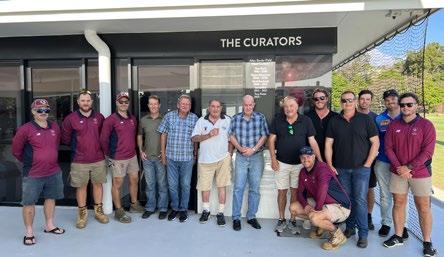

Queensland’s inaugural champion female teams were celebrated with the unveiling of Champions Corner – a new activation and food and beverage space overlooking AB Field. Champions Corner celebrates the triumphant 2012-13 WT20 Queensland Fire team, the 2018-19 Brisbane Heat WBBL team, and the 2020-21 WNCL champion teams.
The southern end of Allan Border Field was unveiled as the Katherine Raymont End in March. The prominent signage was on display during the final of the Katherine Raymont Shield to crown the Queensland Premier Cricket Women’s First Grade champions.

Raymont is regarded as one of the doyens of women’s cricket in Queensland. ‘Farmer’ represented Queensland from 1980-81 to 1993-94, captaining the side for 10 seasons. In 1990, she became the first Queensland women’s cricketer in 34 years to represent Australia at Test level, and the first Queenslander to play a one-day international. She was awarded QC Life Membership in 2017.
One of Queensland Cricket’s finest servants has been acknowledged for her contribution to cricket with the unveiling of the Melissa Bulow Terraces next to the top Ray Lindwall Oval at Allan Border Field.
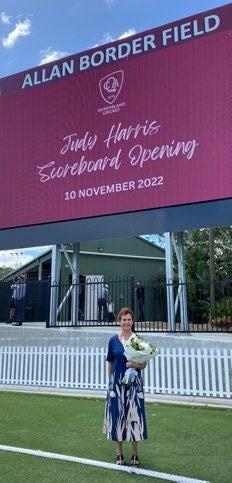

Bulow – considered one of the finest female players to represent Queensland – was bestowed the honour after a playing career that included 23 matches for Australia across Tests, ODIs and T20Is.
She was a member of the Queensland Fire team that won the Women’s T20 competition in 2014 – the state’s first female team to win a major domestic trophy – while she was an inaugural inductee into the Queensland Cricket Women’s Hall of Fame alongside former teammate Julia Price.
Fast-bowling icon Eddie Gilbert was recognised for his role as an Indigenous cricket trailblazer with the unveiling of the Eddie Gilbert End. The unveiling was complemented by the launch of Queensland Cricket’s Reconciliation Action Plan.
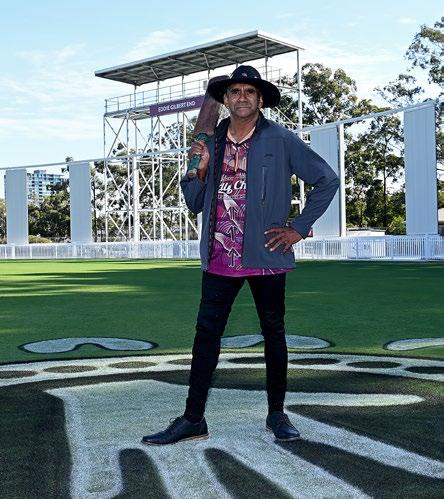
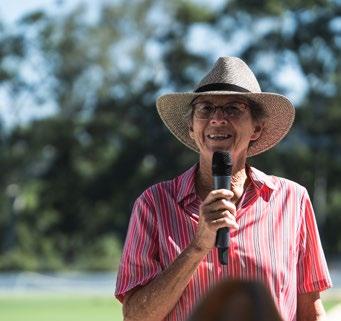
Gilbert was the first Aboriginal cricketer to play First Class cricket in Australia, and was remembered by Don Bradman as one of the fastest bowlers he faced. He took 87 wickets from 23 matches for Queensland.
Long-time QC Chief Executive Officer Graham Dixon was honoured with the unveiling of the Graham Dixon Gates at the Fox Street entry to Allan Border Field. The unveiling of the gates complements the Graham Dixon Award, awarded to the Queensland Cricket Employee of the Year. Each of Allan Border Field’s Head Groundsmen have been recognised with their names inscribed onto the new ground keepers facility.
2022-23 saw a positive bounce back from Covid impacted seasons with strong year on year growth in Woolworths Cricket Blast. Entry level participation grew by 7.74%, with girls participation growing by 19%, The Queensland Government and Cricket Australia were valued partners of Queensland Cricket in helping drive participation in regions where affordability is considered a barrier. Funding grants were received from the State Government and CA to subsidise programs in Logan, Ipswich and parts of Central Queensland. A Woolworths Cricket Blast reform is a strategic priority for Australian Cricket in 2023-24, with areas such as general brand awareness, program structure, school participation, and general promotions considered key in driving Cricket Blast and junior cricket growth.
Queensland Cricket this year has developed its first QC Schools Strategy. The multi-facetted strategy aims to grow participation and support schools through several initiatives including;
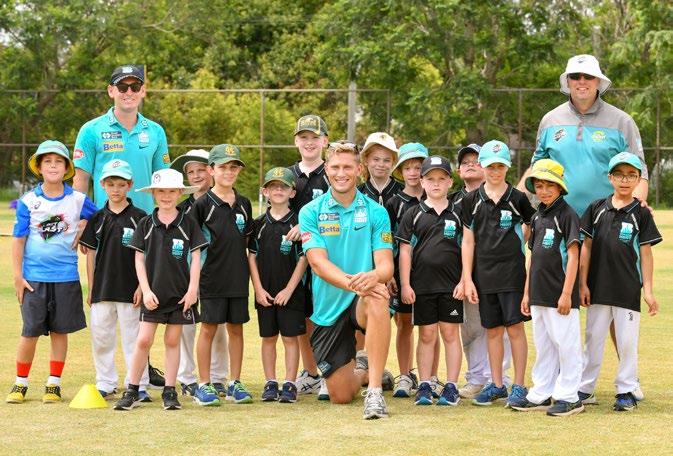

1. Participation programs such as Breakfast Blast before school Cricket Programs.
2. Infrastructure funding and support via the ACIF and development of the new Cricketin Schools - Infrastructure Improvement Program.
3. Providing professional development opportunities for teachers and staff through QC run umpiring and coaching courses
4. Providing Cricket Blast Equipment to Schools across Queensland

5. Providing pathway support through QC Coach and Talent Specialists

Developing new formats for changing lifestyles and demographics has been identified as a growth opportunity for cricket to appeal to new participants and audiences.
Some of the new formats and programs piloted in 2022-23 include;
• Social tape ball cricket. Highlights include a QC led community event at Wests in Graceville, and adult social competition held at Wilston Norths Junior Cricket Club.
• Junior softball games were trialled in South Brisbane.
Ensuring cricket is a sport all Queenslanders can play and enjoy remains a priority for Queensland Cricket. In 2022-23, QC implemented programs and strategies aimed at increasing participation and growing engagement for women and girls, First Nations, all-abilities, and multicultural Queenslanders.
Junior girls participation increased by 5% and Cricket Blast by 19% in 2022-23, supported by an $80,000 funding grant from Cricket Australia through the Growing Cricket for Girls Fund.
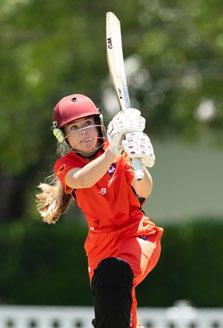
Strategic projects for 2023-24 include the Queensland Cricket Women and Girls Strategy, supported by the piloted That’s My Game Ambassador program, aimed at providing girls with community role models and experiences to develop cricketing skills.

Indigenous participation grew by 37% in 2022-23, largely contributed to by Cricket Australia’s Woolworths Cricket Fund that allowed QC Community Cricket staff to deliver junior programs through several indigenous communities and schools.

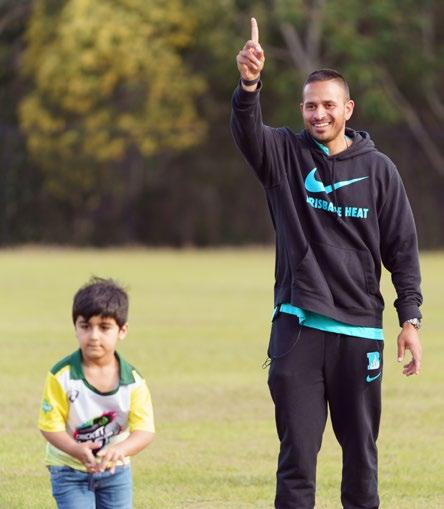

Queensland Cricket’s Reconciliation Action Plan, launched in June 2023, outline numerous participation priorities over the coming seasons such as the review of the Eddie Gilbert Talent Identification Program, and expanding pathway development opportunities for first nations participants.
QC’s Indigenous cricketers were standout performers at the National Indigenous Cricket Championships, with QLD’s Women’s Team going through the competition undefeated to claim their first-ever title.
QC was the beneficiary of a two-year $200,000 grant to fund T20 World Cup Legacy Projects aimed at multi-cultural participation. Highlights included the launch of the Tapeball Nations Cup – a competition that saw eight countries included - and a partnership with the Usman Khawaja Foundation that saw six dedicated multicultural Cricket Blast programs run in early 2023 for over 250 participants.
To engage Queensland’s vibrant multicultural community, QC entered partnerships with the Bangladesh Association of Brisbane, Nepalese Cricket Association and the Indian Australian Business Council for several cricketing initiatives.
12 Woolworths Cricket Blast programs were held across Queensland special schools that saw over 200 participants

engaged in cricket, while a partnership has been formed with the Special Olympics Queensland for 2023-24.
Queensland was again well represented in the National Cricket Inclusion Championships with teams entered in the Deaf and Hard of Hearing, Blind, and Cricketers with an Intellectual Disability competitions.
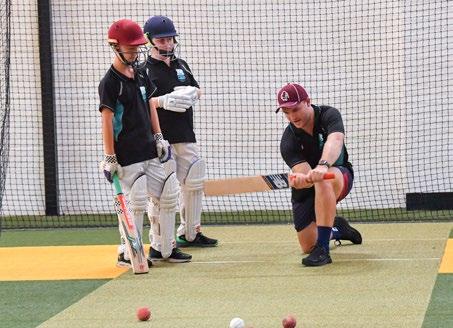
Junior Cricket Carnivals were again held across the State. The U12-16 boys Phase One carnivals were held in Gympie, Redlands, Gold Coast, Sunshine Coast,
Brisbane North, Ipswich, Mackay, Home Hill, Townsville & Cairns. Girls U13 and U15 Phase One Carnivals were held in Ipswich, Ingham and Townsville.
Queensland Cricket also hosted Phase Two Carnivals with the U15 Girls at Redlands CC, U15 boys at John Paul College and U16 boys at Caboolture CC.
Far North Queensland
Andrew Guest
North Queensland
Steve Carrara
Mackay Whitsunday
Mark Valmadre
Central Queensland
Nev Judd
Wide Bay
Brett Burrows
Sunshine Coast
Ben Shaw
Brisbane North
Clinton Keenan
Bayside East & Redlands
Andrea Pullar
Metro South West
Sathish Rajendran
South East Queensland
Faye Marsden
Gold Coast
Mel Lewis
Darling Downs & South West Queensland
Megan Kruger
The Queensland Cricket Volunteer Recognition Program, widely recognised as Kaspa’s Crew and named in honour of former fast bowling great Michael Kasprowicz, commemorated the exceptional efforts of individuals who embody the spirit of volunteering within the cricketing community during the 2022-23 season.
Queensland Cricket takes immense pride in acknowledging the remarkable contributions made by volunteers, which significantly contribute to the triumph of cricket across the state. The tireless endeavours of these remarkable individuals, as well as the unwavering dedication exhibited by clubs and associations at the grassroots level, play a pivotal role in strengthening the game.
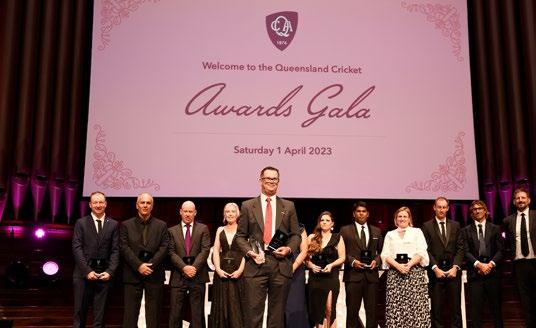

Following tradition, the Queensland Cricket Awards Dinner saw the formal recognition of twelve outstanding volunteers who were proudly inducted into Kaspa’s Crew. This esteemed group exemplifies the relentless commitment and passion of volunteers who continuously strive to establish cricket as Queensland’s favourite sport. This year’s volunteer of the year was Andrew Guest who is the Club Manager of PCYC Yarrabah. Yarrabah is a small coastal Aboriginal community east of Cairns, and home to a group of passionate young cricketers.
These young cricketers have been taken under the wing of Andrew who noticed a group of kids who attended the after-school care program were particularly talented with the bat and ball in their pick-up games at the centre.
“They’ve always loved playing cricket” he reflected. “They would play with a plastic bat and a tennis ball before we
COMMUNITY COACH OF THE YEAR
started playing cricket properly. Although they didn’t have a lot of technique at first with the bat, they had fantastic hand-eye coordination and were very athletic”.
From there, Andrew threw some feelers out to see who would be interested in playing cricket properly as part of a team. To his delight, plenty showed interest.
The Yarrabah PCYC cricket team is into their second season now and is comprised of girls and boys aged 8 to 12. They play in the Cairns tier 1 competition on weekends in conjunction with their closest club, Mulgrave Combined Cricket Club. Although they didn’t win a game during their first season, it was a big learning curve for the group, as they all figured out how the “order of operations” works on the day. With the second season completed now, momentum has grown significantly.
“The improvement has been amazing” commented Andrew.
“Three players were selected in the Under 13 female representative side and went on to play in the development carnival in Ingham in December.”
“The girls went really well at the carnival but unfortunately days two and three were washed out due to rain. Chantel Gordon finished the carnival with most catches and Eunice King with most wickets.” A fantastic result for the team.
Andrew’s goal moving forward is to keep the team going and continue building momentum. He would love to put another team on the paddock next year and has two to three boys eligible to put forward for the representative teams too.
CAITIE DEARNALEY TOWNSVILLE WESTERN SUBURBS
WOMEN & GIRLS INITIATIVE PIONEER VALLEY CC#
CLUB OF THE YEAR
SOUTHERN DISTRICTS MAGPIES CC TOOWOOMBA*
ASSOCIATION OF THE YEAR
CHINCHILLA CADARLING DOWNS#
INCLUSION & DIVERSITY INITIATIVE OF THE YEAR

BANGLADESH ASSOCIATION BRISBANE
INDOOR FACILITY OF THE YEAR
WILDCATS INDOOR SPORTS CENTRE
JUNIOR CRICKET INITIATIVE OF THE YEAR
NQ COUNTRY CUP HERBERT RIVER, CHARTERS TOWERS, HOME HILL, BOWEN CC
TECHNOLOGY & MEDIA INITIATIVE BUNDABERG CRICKET ASSOCIATION & WIDEBAYTV*
MATCH OFFICIAL OF THE YEAR
ALISON FAIRLEIGH*
TSV UPMIRES ASSOCIATION
COMMUNITY PARTNERSHIP OF THE YEAR
ST GEORGE CRICKET ASSOCIATION INC., BALONNE SCHOOL SPORT AND SOUTH WEST SCHOOL SPORT*
CRICKET IN SCHOOLS
JOSHUA WARDELL*
SPRING MOUNTAIN SS
VOLUNTEER OF THE YEAR
ANDREW GUEST#
FNQ - YARRABAH CRICKET
An umpire or match official (such as a scorer) who leads by example in championing safe, fair and enjoyable cricket for all.
Alison has been a shining light and fantastic addition to the North Queensland cricket umpiring ranks since enquiring about becoming a match official in mid-2022. Prior to this Alison was “just” a fan of cricket, with no previous playing or umpiring experience.

Alison quickly obtained her community accreditation level with Cricket Australia and has risen through the ranks so quickly that on the weekend she officiated her first B-Grade game. Alison has had a strong start to her umpiring career.

She is knowledgeable, confident, and empathetic to players and the game combined with excellent people skills which has attracted very positive comments from presidents, captains, and players. This has shown she possesses all the attributes of a quality umpire. Alison’s progression will allow her to perform at a higher level both locally and in the representative arena next season quite capably when selected.
A coach who exemplifies coaching The Australian Way. Someone who has gone out of their way to make sure that participants are supported to develop both their skills and a lifelong love of cricket.
Caitie is hugely passionate about growing the girls and women’s game and coaches two Under-13s girls’ teams at her club. These are also the first girls-only teams ever to play in the Townsville Junior Competition. At all times Caitie has made herself approachable and personable to parents, administrators, and fellow coaches, as she happily explains her methods and approaches.
It should also be noted that Caitie has had to deal with some adversity in the face of a couple of overzealous parents, but she has always tackled the issues the right way and never has she allowed those incidents to detract from what she is trying to do; and that’s to help more girls fall in love with cricket the same way she has.
A community cricket club that actively creates welcoming environments and seeks to create sustainable participation and growth through good governance, volunteer support and inclusive on field programs.


Southern District Magpies Cricket Club have gone above and beyond to work alongside Queensland Cricket to promote their Cricket Blast, Junior Cricket and encouraging young players into the Senior Cricket space. Souths is the only club in Toowoomba providing an All-Abilities Junior Blast program, and saw over 30 participants in Junior Blast, and 41 Master Blaster participants. This is the second season where Souths have maintained these high numbers, which means they are providing quality blast experiences. Numbers are increasing in the Junior Cricket space, with over 10 Junior teams and a coach assigned to each team. Souths have done a magnificent job to provide a coach to each team, including every Master Blaster team.
They have also provided training opportunities for ladies and girls on Wednesday nights to prepare for the Toowoomba Wednesday Women’s League, which shows an active effort to grow their female players. Souths have been excellent at working with Queensland Cricket, and doing small things right like re-endorsement of the Child Safety Policies and applying for grants. It is hard to fault the work they have done this season, and they are on the right track to becoming a successful and leading club in Toowoomba if they continue.
A young person, under the age of 25 who positively impacts those around them through their off-field leadership in volunteering.
SORAYA
In 2017, Soraya at the age of 16, played a crucial role in developing the Women’s team at Mulgrave Cricket Club when she joined the committee in 2020 as she believed she could offer more in different ways. During the 22-23 season, due to the rapid expansion of Mulgrave in a short time, and Soraya’s true eagerness to learn and help, she took on the Memberships, Apparel & Equipment, Social Media and Events Manager and the Female Cricket Representative positions.
As the Apparel and Equipment Manager, Soraya manages a small team who assist her ordering game balls, playing clothes and equipment, social polos, and hats and has worked well with her small team to fulfil these duties and demands. As the Events Manager, Soraya has grown not only in her ability to run events but her confidence to make decisions in stressful situations,
working with various stakeholders, building on her knowledge, actively reaching out to members for assistance, and ensuring she creates an enjoyable and inclusive event for everyone. These events have created a great club culture which also showed through results on the field as well. Soraya is not only a dedicated and well-respected member of the club, but a young leader who is doing great things within the community.
This award looks to celebrate the outstanding delivery of female based experiences by finding clever or innovative ways to engage and grow their program.
Pioneer Valley has added a further step in an already strong girls and women’s pathway at the club by recognising a gap in the development of junior girls looking to play representative cricket. Due to minimal opportunities other than a few carnivals to upskill and play at higher levels, the club entered an all-girls team into the traditionally boys Saturday morning junior competition.
This is a first for Mackay cricket with an all-girls team playing in this competition. The challenge of playing against boys in a competitive environment each week while still playing in an all-girls team serves to develop the team’s skills at a much faster rate and have them more customed and aware of the challenges when playing representative cricket. Through the introduction of female coaches, club supplied equipment, very bright and vibrant uniforms, Girls only Gala days, and clear pathways and opportunities, the club has created an exciting and welcoming environment for all female cricket in and around the Mackay region.
An individual, club or association who has used technology to create a connection to its members, whether by reducing volunteer time, connecting members through social media, or enhancing participant experience.
momentum between Friday night matches. The streaming also gave great exposure to association and club sponsors, which helps put extra value on the product and will make it easier to gain partnerships now and in the future.
BUNDABERG
The Bundaberg Cricket Association’s partnership with WideBayTV engaged the region’s cricket community and even created a new supporter base with its livestreaming of games from the Aussie Bundy Big Bash on Friday night and a weekly broadcast of The Cricket Show. The aim was to deliver a great product, a great atmosphere, get bums on seats, increase brand and sport awareness, and set cricket apart from all the other sports in Bundaberg, which in turn assisted in the increase of participation at junior and senior levels. BCA also ran their Junior Blasters prior to the Big Bash to bring families in and some of the players helped coach the next generation.
The Cricket Show is a weekly roundup of cricket in the Wide Bay region, hosted by Rhys Grills and David Boge, with both local and visiting guests joining them. This was a great way of maintaining the
This award looks to acknowledge the outstanding delivery of diverse and inclusive experiences by finding innovative ways to engage and grow their offering.

Bangladesh Association in Brisbane (BAB) was founded in 1997 and is a valuable part of Australia’s multicultural ecosystem, promoting diversity, inclusion and Bangladeshi culture and heritage in Queensland. BAB comprises of members of Bangladeshi origin in Australia, Bangla speaking people and those practicing Bangladeshi culture. It organises various social, cultural and sporting events including – Victory Day, Australia Day, Ekushe February, Bijoy Mela, Pitha Mela, Pohela Boishakh, soccer and cricket tournaments and music concerts.
The President of BAB is AKM Shahinuzzaman, a passionate community leader. Another BAB leader, Mr Jishu Das
plays an important role in organising Squad Bangladesh vs Squad India cricket match, especially during the 2022 T20 world cup in Adelaide, and in Brisbane in collaboration with Brisbane Super Kings and Queensland Cricket, Independence Day Table Tennis Tournament, BAB Soccer tournament and more. JD also champions the International Mother language Day event which is well received in the wider community.
A school, ambassador or initiative that celebrates the connection between school, students, and the broader cricket community.
Spring Mountain State School and Joshua Wardell have been amazing in the promotion and support of bringing our Queensland Cricket vision to life. In Term 3, 2022, a Junior Blaster after-school 8-week program ran which saw 83 paid registrations, including 12 girls. Spring Mountain State School and Josh are very committed to aligning and connecting students to their local Cricket Club and have done so by establishing a relationship with Greenbank Cricket Club.
From the development of this relationship, they were able to run a 6-week Master Blaster competition exclusive to Spring Mountain State School students on their school oval, with 64 students registering
in Term 4, 2022. This program was run on behalf of Greenbank Cricket Club with parents registering through the club entity. Club volunteers worked hard to assist in providing an amazing experience in Master Blasters whilst the students were able to participate in the comfort of their own school grounds with peers. With our schools and clubs working together, their children’s cricketing experiences can start earlier, create a love for the sport and even unearth some stars of the future.
An Indoor facility that embraces the connection with the community and cricket to provide the best program experience to its participants.
The strength of partnership between Townsville Cricket and Wildcatz Indoor Sports has rarely been stronger. Wildcatz is always happy and willing to open its doors whenever rain affects the region. At a moment’s notice, the Indoor Centre’s willingness has saved the inaugural North Queensland First Nations Carnival from being washed out, ensuring two separate Coaching Master Classes run by QC went ahead and allowed the Northern Zone Girls U13s to enjoy the end of their rep carnival after two of the three days had to be cancelled due to the weather.
On top of that, various club trainings constantly shift to the centre at a moment’s notice. The Indoor Centre also runs their
own Pop-Up Blast Programs on Saturday mornings and are the host venue for Heat School Holiday Programs during the summer. In another important connection, the centre is creating a junior competition for those kids who would like to continue building their skills over the cricket offseason. This will not only have a positive impact on children’s skills but also club bank accounts! For every team a club enters, Wildcatz will donate 20% of all registration fees back to the club at the end of the season.

This award recognises outstanding leadership and support in building community-based partnerships that provide positive outcomes to the Cricket community.
ST GEORGE CRICKET
BALONNE SCHOOL SPORT AND SOUTHWEST SCHOOL SPORT*
The St George Cricket Association has partnered with Balonne School Sport and South-West School Sport to conduct the Balonne District and South-West Region Girls and Boys 10-12 years cricket trials. As the school system had extreme difficulty sourcing expertise to conduct the trials, St George Cricket stepped in to provide this and the Balonne District provided administrative support. This partnership has now successfully continued for several years. Through this visible partnership, more players and parents see school sport cricket as an extension of local junior cricket
and are thus very keen to participate. This provides extra opportunities for local players to experience the game at a higher level, which in turn improves the skill level for not only local players, but also for players across the South-West.
This award looks to acknowledge the outstanding delivery of junior cricket experiences by finding innovative ways to engage and grow their junior offering with a focus on education, fun and social connection.
The North Queensland Country Cup has been held for the past two years for the Charters Towers, Herbert River, Home Hill, Mackay, and Proserpine regions. The cup was formed to create a sense of camaraderie and purpose for the regional associations. In the spirit of participation, each event has seen players mingle and play with and for other regions, to bolster the playing stocks of the lesser-represented associations, which adds to the sense of belonging for players.
The yearly Country Cup is also a precursor to the season, being held on the last weekend of the September school holidays, getting kids into cricket before the season starts, and creating an opportunity for players to start thinking about cricket well before the sign on dates are announced.
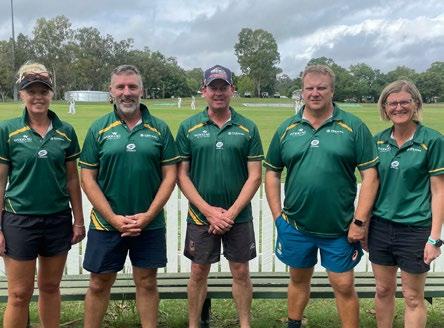

A cricket Association that actively works to create a sustainable competition that provides opportunities for everyone to have the chance to play cricket.
Chinchilla is the shining example of a cricket club batting above its average. Despite being from a town with little more than 7000 residents, the region’s growth numbers have been incredible. For the first time, Chinchilla started a Wednesday night ladies cricket event, which ran for four weeks and attracted almost 30 ladies on some of the nights.
The club has also significantly improved the pathway between junior and senior cricket. Players aged between 13 and 18, many who haven’t even played cricket before, have come together from neighbouring associations such as Dalby, Oakey, and Roma to join “Colts” cricket. It gives the younger, keener players the opportunity to play high-level cricket and improve their skills against older players. The impact this has made can also be seen in the overall junior numbers, which have risen by more than 40 percent in 2022/23 compared to 2021/22.
Queensland’s players once again shone in green and gold across 2022-23 in a year that saw players earn their first Baggy Green, while others lifted World Cups.
Matthew Kuhnemann became Queensland’s latest Test debutant during Australia’s tour of India. He played in three of the four Tests in the Indian series, picking up nine wickets at an average of 31.11, and performed a vital role in Australia’s nine-wicket win in the third Test in Indore, with his 5-16 helping roll the home side for just 109 on the first day.
Kuhnemann was joined on the tour of India by fellow spinner Mitchell Swepson alongside Marnus Labuschagne and Usman Khawaja.
Khawaja’s resurgence as an international batsman continued, with the Queensland captain becoming a mainstay at the top of Australia’s Test order. Khawaja featured in all Australian Tests across 2022-23, with his highlights including a career best 195 not out against South Africa in Sydney, and breakthrough centuries in India and England. The latter’s innings helped Australia seal a memorable win in the first Ashes Test at Edgbaston in a Man of the Match performance.
Khawaja was joined by Labuschagne in Australia’s XI that lifted the ICC Test Championship in England with victory over India. Labuschagne’s trajectory as an international batsmen saw him climb to the number one ranked ICC Test batsman, with his year highlighted by a second Test double century against the West Indies in Perth. The 2022-23 summer also saw Michael Neser play his second Test against the West Indies, while Matthew Renshaw made a return to the Test team after a four-year absence. Renshaw featured in the SCG Test in January, though his impact was limited after testing positive for COVID before the start of play, before playing two Tests in India and being selected in his maiden Ashes squad.
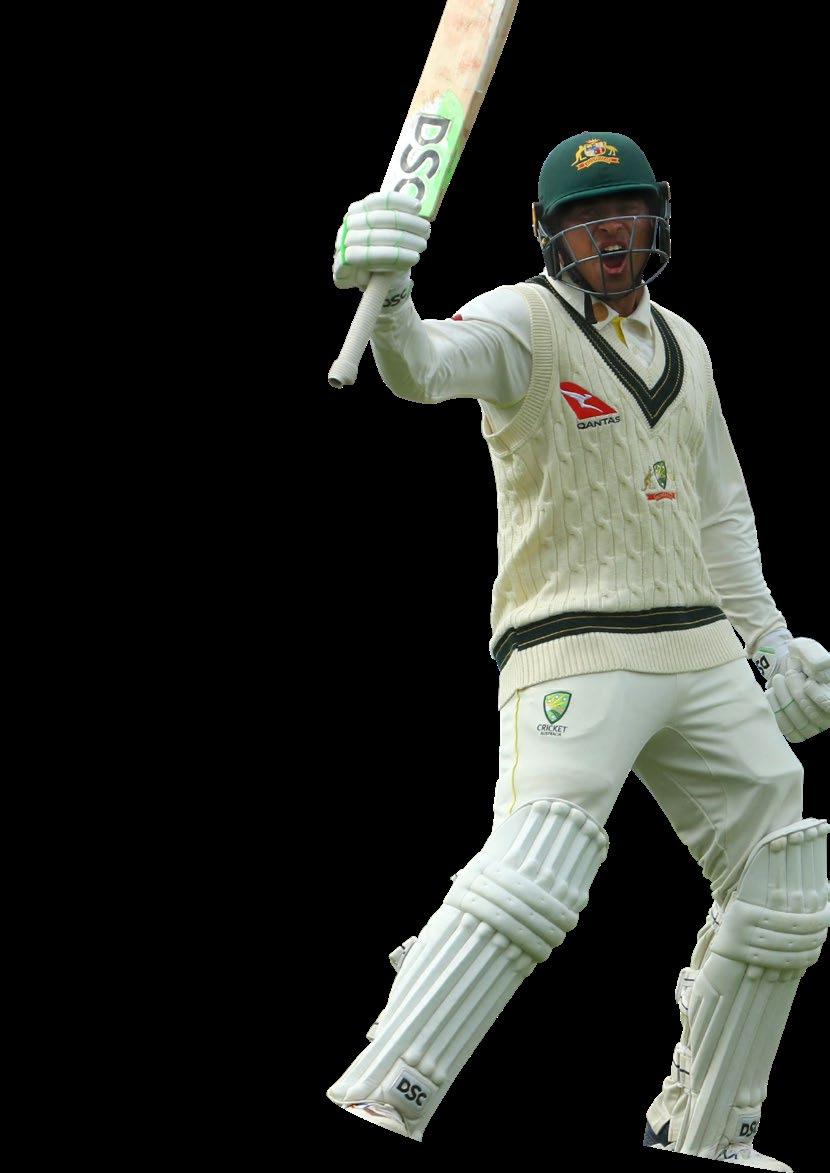
Queensland wicket-keeper Jimmy Peirson was a late addition to Australia’s Ashes squad, replacing Josh Inglis who returned to Australia for the birth of his child, while Neser’s domination of County Cricket with Glamorgan saw him added to Australia’s squad for the Ashes and World Test Championship.
The glittering career of Jess Jonassen continued with more T20 World Cup glory in 2023 to add to 2022’s Commonwealth Gold Medal and ICC One Day World Cup wins.
Jonassen featured alongside Brisbane Heat and Queensland Fire teammate Grace Harris in the Final of the T20 World Cup as Australia triumphed over hosts South Africa. Harris showed consistency with bat and ball during the World Cup win, while also taking one of the catches of the tournament against Sri Lanka.
Harris’s thunderous batting style was on show during Australia’s T20I tour of India in late 2022 where she finished the series with a strike rate of 203 and average of 132.
Jonassen’s deeds saw her named alongside fellow Queensland and Heat Captain Khawaja as Queensland Sport Star of the Year at the Q Sport Awards.
The global growth of the women’s game continued in 2023 as the first edition of the Women’s Premier League was held, running prior to the men’s equivalent –Indian Premier League. Queensland and the Brisbane Heat were well represented in the tournament, with Jonassen and Harris joined by Laura Harris and Amelia Kerr in getting picked up in the competition’s inaugural draft.
At the time of writing, both Jonassen and Harris were set to play major roles in helping Australia defend the Women’s Ashes in the United Kingdom, with the former featuring in the opening Test win.

AUSTRALIAN REPRESENTATIVES
MEN
Usman Khawaja (Valley)
Matthew Kuhnemann (Gold Coast)
Marnus Labuschagne (Redlands)
Michael Neser (Gold Coast)
Matthew Renshaw (Toombul)
Kane Richardson (Gold Coast)
Mitchell Swepson (Sandgate-Redcliffe)
WOMEN
Grace Harris (Wests)
Jess Jonassen (Valley)
QUEENSLAND FIRE WNCL: 3rd
QUEENSLAND BULLS Sheffield Shield: 3rd One Day Cup: 4th
BRISBANE HEAT WBBL: 3rd BBL: 2nd
Xavier Bartlett (Gold Coast)
James Bazley (Redlands)
Max Bryant (Gold Coast)
Joe Burns (Norths)
Jack Clayton (UQ)
Blake Edwards (Wests)
Liam Guthrie (Wynnum-Manly)
Sam Heazlett (Redlands)
Usman Khawaja (Valley)
Matthew Kuhnemann (Gold Coast)
Marnus Labuschagne (Redlands)
Michael Neser (Gold Coast)
Jimmy Peirson (Redlands)
Matthew Renshaw (Toombul)
Kane Richardson (Gold Coast)
Gurinder Sandhu (South Brisbane)
Mark Steketee (Valley)
Bryce Street (UQ)
Connor Sully (Norths)
Mitchell Swepson (Sandgate-Redcliffe)
Sam Truloff (Wests)
Jack Wildermuth (Valley)
ROOKIES:
William Prestwidge (Norths)
Jackson Sinfield (Redlands)
Hugo Burdon (Gold Coast)
Matthew Willans (UQ)
The Queensland Bulls were largely consistent across the first-class arena and showed promising signs for the future in the limited overs format in 2022-23.
After a poor start to the season, the Bulls finished fourth in the Marsh One Day Cup, capped off by a thrilling win in the last game of the season over NSW at the Gabba with a line-up featuring four debutants.
Queensland finished a clear third in the Marsh Sheffield Shield and will note the four draws that ultimately consigned them to miss the Final after being firmly in contention coming into the last round against Tasmania. One of those draws came with the Bulls charging to victory against NSW in Sydney before bad light ended play.
The Bulls had two outright wins at Allan Border Field – over Tasmania and Victoria – and two victories at the Gabba against NSW and South Australia.
The Bulls bats individually had Matt Renshaw produce the highest score with 200 not out, with wicket-keeper Jimmy Peirson hitting two of the other five centuries scored.

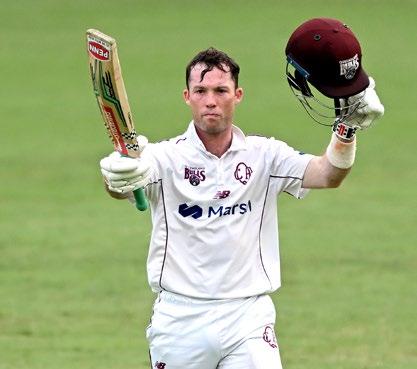
Peirson, who captained the team for a slab of the season, was the leading runs-scorer with 460.
The Queensland bowling attack was led by paceman Michael Neser who took 40 wickets, closely followed by fellow new ball bowler Mark Steketee with 38 dismissals.


Neser claimed personal milestones during the season of 200 Shield wickets and 2000 Shield runs, as did teammate Steketee who passed 200 Shield wickets as well.
As well as those Queenslanders chosen to represent Australia at Test, ODI and T20I level, Jimmy Peirson, Matthew Renshaw, Mitch Swepson, Xavier Bartlett and Brisbane Heat players Spencer Johnson and Nathan McSweeney were also chosen to tour New Zealand in April to play New Zealand ‘A’ in a pair of first-class games.
Ian Healy Trophy
Michael Neser
Marsh Sheffield Shield Player of the Year
Michael Neser
Marsh One Day Cup Player of the Year
Michael Neser
Andrew Symonds Medal (Bulls Player’s Player)
Mark Steketee
Queensland took out this year’s Men’s Benaud Spirit of Cricket Award, with a combined 276 points across the Marsh Sheffield Shield and Marsh One-Day Cup competitions, four points ahead of Tasmania.
In the Spirit of Cricket Awards, teams are awarded points across three categories at the end of each match, with Respect for Opponents, Respect for Umpires and Respect for the Game all measured. It was the second time in as many seasons that Queensland has won the men’s award. Individually, batting stalwart Joe Burns brought up his 100th match for Queensland, the 16th male player to register the first-class milestone for his State.
He joined Stuart Law, Martin Love, Matthew Hayden, Andrew Symonds, Jimmy Maher, Ken Mackay, Trevor Hohns, Greg Ritchie, Sam Trimble, Carl Rackemann, Michael Kasprowicz, Trevor Barsby, Chris Hartley, and James Hopes in reaching the mark. His 100th match came against South Australia in November 2022, 11 years after he made his Shield debut for Queensland against the same opponents.
Jess Jonassen (Valley)
Lucy Hamilton (Sunshine Coast)
Nicola Hancock (UQ)
Grace Harris (Wests)
Laura Harris (UQ)
Mikayla Hinkley (Valley)
Ellie Johnston (Sunshine Coast)
Ruth Johnston (Sunshine Coast)
Charli Knott (UQ)
Caitlin Mair (Sandgate-Redcliffe)
Grace Parsons (Gold Coast)
Georgia Prestwidge (Valley)
Georgia Redmayne (Gold Coast)
Courtney Sippel (Gold Coast)
Georgia Voll (Sandgate-Redcliffe)
The Queensland Fire took out third spot in the Women’s National Cricket League after losing its final round series to South Australia which finished runners-up to eventual champions Tasmania.

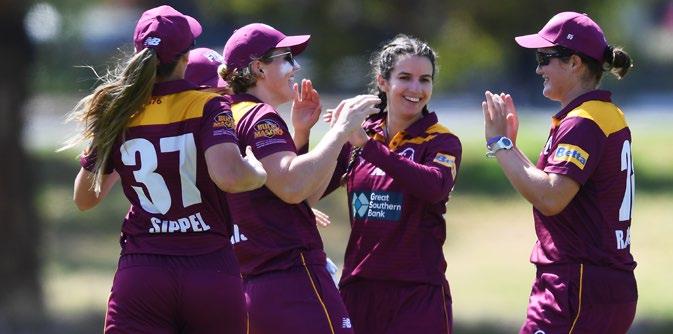
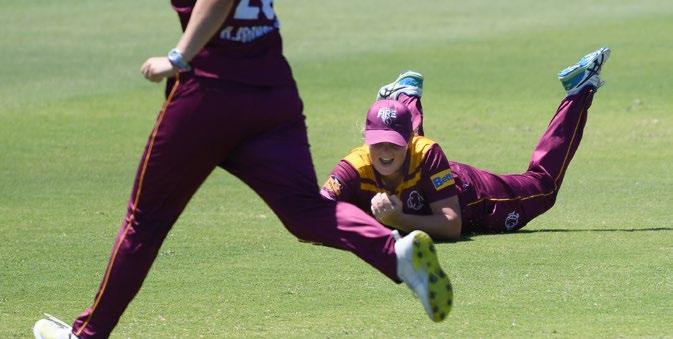
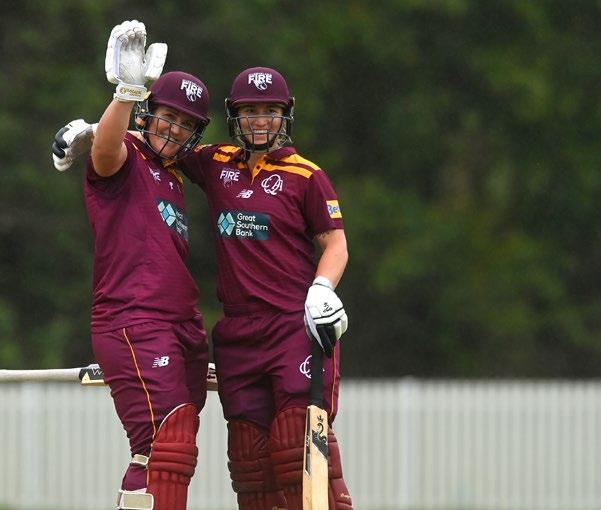
During the summer, Fire batter Laura Harris set a record for the fastest century in the WNCL, hammering 100 off just 50 balls against the ACT Meteors.
WBBL Heat and Fire captain Jess Jonassen and fellow allrounder Grace Harris were both important contributors in the Australian Women’s T20 World Cup winning team and toured with the Women’s Ashes squad during the 2023 winter.
Pace bowler Courtney Sippel and allrounder Charli Knott also toured the UK with Australia ‘A’.
Sippel (18), Fire player of the year Grace Parsons (15), pace bowler Nic Hancock (12) and Knott (12) were all consistent wicket-takers, while Laura Harris (411) and Georgia Voll (397) led the charge with the bat, including a career best WNCL score of 145 by Voll.
Harris, who captained the team in the second half of the season in the absence of Jonassen and the injured Georgia Redmayne, claimed the inaugural Jodie Purves trophy for her performances across both the Fire and the WBBL Brisbane Heat. There were four players make their debuts for Queensland in the WNCL. Pace bowler Nicola Hancock, wicket-keeper batter Kira Holmes, top order batter Ruth Johnston and allrounder Sianna Ginger all received their Fire caps during the summer.

Jodie Purves Trophy
Laura Harris
Pike-Maher Medal
Grace Parsons
Queensland Fire Player of the Year
Grace Parsons
Queensland Fire Player’s Player
Laura Harris
Usman Khawaja (Captain)
Xavier Bartlett
James Bazley
Sam Billings (International)
Josh Brown
Max Bryant
Sam Hain (International)
Sam Heazlett
Spencer Johnson
Matt Kuhnemann
Marnus Labuschagne
Nathan McSweeney
Colin Munro (International)
Michael Neser
Jimmy Peirson
Will Prestwidge
Matthew Renshaw
Mark Steketee
Mitch Swepson
Ross Whiteley (International)
Jack Wildermuth
The Brisbane Heat took fans on a roller-coaster ride in BBL|12 as the club rebounded from the disappointments of BBL|11 to go within a whisker of claiming a second KFC Big Bash League title.

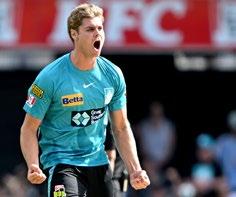
The club’s off-field recruitment was focused on improving its batting stocks following the departure of former captain Chris Lynn, which came in the form of securing Bulls captain Usman Khawaja on a four-year contract, along with the return of fellow Queenslander and former Heat batter Matthew Renshaw from the Adelaide Strikers.
The inaugural International Player Draft also proved fruitful for the Heat, picking up Sam Billings (England) and Colin Munro (New Zealand) as top-order hitters, with allrounder Ross Whitely the club’s third pick.
True to recent season form, the Heat struggled early in their campaign, opening with two losses to the Melbourne Renegades in Cairns and Geelong, though the latter match was highlighted by an early hat-trick to Michael Neser.
A much-needed win against the Adelaide Strikers that saw Lynn return to Brisbane for the first time since his off-season move helped stabalise the campaign before two losses in a row against the Sydney Thunder. The second match against the Thunder was a cliff-hanging contest where Munro played a lone hand in scoring 98 off 53 balls to set the Heat on path to chase down the Thunder’s total of 182. The damaging opener fell in the final over thanks to a stunning Daniel Sams catch on the boundary that turned the game, with the Heat eventually falling by 11-runs.
The following game saw the inaugural New Year’s Bash held on January 1 as the Heat kicked off 2023 against the Sydney Sixers in front of the biggest Gabba crowd since the pre-Covid seasons.
Newcomer Josh Brown thrilled the crowd with an early onslaught, smashing 62 runs off 23 balls, and helping set the tone for a huge total alongside Nathan McSweeney (84 from 51 balls) who hit a BBL best.
The Heat’s total of 5-224 was a club record and the fifth highest in BBL history, though it looked in danger of being chased down as the Sixers flew out of the blocks. The match-turning moment came in the 19th over as Michael Neser took a brilliant –and much talked about – catch on the boundary. Using the laws of the game to his advantage, Neser jumped from outside of the boundary to parry the ball in the air before landing back in the field of play.

The New Year’s Bash result didn’t prove to be the immediate season turner Heat fans had hoped for, with a washed-out game at North Sydney Oval against the Sixers followed by back-to-back losses against the Perth Scorchers putting the Heat’s campaign on the edge.
The turning point came in Adelaide as the Heat won a hard-fought contest on a steaming hot day that also saw KFC T20 Max recruit Spencer Johnson establish himself as a BBL fast-bowling force. Usman Khawaja’s astute captaincy was a welcome addition alongside fellow Test batter Marnus Labuschagne who top scored with 46 from 33 deliveries.
The Adelaide win set the Heat on a fourmatch winning run to secure a finals berth. The streak included a miraculous win at the MCG where Renshaw scooped a boundary off the final ball of the match to secure a famous victory on his way to 90 not out.
The Heat reversed their fortunes from BBL|11 where the club failed to win a game at the Gabba by winning four of their five Brisbane fixtures, with the final match highlighted by a 133-run stand between Jimmy Peirson and Sam Hain against the Melbourne Stars, followed by a deathbowling masterclass from Johnson.
A forgettable batting collapse in the final game of the regular season against the Hobart Hurricanes meant the Heat missed out on a home final and squeezed into the knockout phase by finishing fifth, though fortunately, the Hurricanes’ result was not a sign of things to come.
A Khawaja and Labuschagne batting showcase put the Heat on the front foot in the Eliminator against the Sydney Thunder at the Sydney Showgrounds, with the visitors racking up a formidable total of 5-203. An early David Warner onslaught had Heat fans nervous before rain intervened as the visitors won through to the Knockout against the Melbourne Renegades at Marvel Stadium.
Xavier Bartlett put in a Man of the Match performance against the Renegades, with his 3-18 helping to restrict the home team to 5-162 before another captain’s knock from Khawaja (59 runs from 47 balls) helped the Heat home with seven balls to spare.
The Grand Final Qualifier against the Sydney Sixers at the Sydney Cricket Ground proved to be a more nerve-wracking affair for the Heat.
The Heat seemed in control of the match after restricting the Sixers to 9-116 from their 20 overs with spinner Matthew Kuhnemann taking full advantage of the invariability of the pitch with 3-17, while Johnson claimed 3-28.
The Heat’s title charge was teetering at 6-86 before the calm head of Michael Neser came to the fore. Neser struck 48 not out from 32 balls to guide his team to a second BBL Grand Final.

Despite losing Khawaja, Labuschagne and Mitchell Swepson for the Challenger and Grand Final to Australia’s Test Tour of India, a buoyant Heat team travelled to Perth with momentum on their side.
What came next was a Grand Final for the ages. In front of a capacity crowd of rabid Scorchers fans, the Heat produced a batting performance that was full of contributions, with Josh Brown (25 from 12), Sam Heazlett (34 from 30), McSweeney (41 from 37), Hain (21* from 16), and Max Bryant (31 from 14) all putting scores on the board to set the Scorchers a defendable 176 for the BBL crown.
The Perth chase ebbed and flowed throughout the ensuing 20 overs. The Heat had some early momentum as the hosts reached 3-54 in the 8th over before captain Ashton Turner came to the crease.
Turner turned the game in the Scorchers ascendancy with a quick-made 53 before a Spencer Johnson run-out had the Heat back in front and ready to pounce. However, some late hitting from the unheralded Cooper Connolly turned the game in Perth’s favour, which they held for the remainder of the game and closed out a 5-wicker win with four balls remaining.
The Grand Final will be remembered as one of the great BBL games and was watched by a national audience of nearly 1.4 million fans, with the match the most-watched BBL game ever on Fox Cricket.
Having completed his first full season with the Heat, Neser’s 26 wickets saw him names in the BBL|12 Team of the Tournament, while he was also crowned the Heat’s Most Valuable Player.
Jess Jonassen (Captain)
Zoe Cooke
Lucy Hamilton
Nicola Hancock
Grace Harris
Laura Harris
Mikayla Hinkley
Ellie Johnston
Amelia Kerr (International)
Jess Kerr (International)
Charli Knott
Grace Parsons
Georgia Redmayne
Courtney Sippel
Pooja Vastrakar (International)
Georgia Voll
Danni Wyatt (International)
The Brisbane Heat again proved themselves to be one of the most-consistent teams in the Weber Women’s Big Bash League in 2022, making a fifth straight finals series and coming within a whisker of reaching the competition’s final.
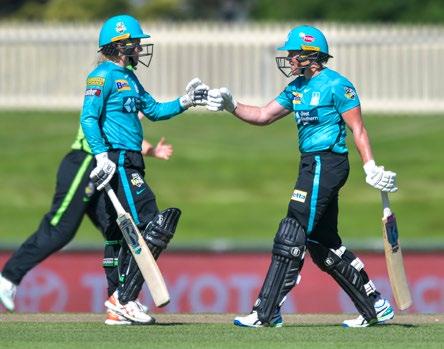
The Heat’s campaign started with a tight loss against the Sydney Sixers as the WBBL kicked off in Mackay. Georgia Voll was thrust into the unfamiliar role of death bowler and almost closed out a Heat win. With the Sixers only needing six from the final over, Voll kept the Heat in the contest with three runs and a wicket coming from the first three deliveries, before Maitland Brown hit a six off the penultimate ball of the game to open WBBL|08 with a bang.
The WBBL opener was watched by a national TV audience of almost 300,000, making it the second most watched opening match in the history of the WBBL.

The Heat then enjoyed back-to-back wins to close out their Mackay leg. Ellie Johnston hit a Player of the Match 54 from 34 balls to help her team to a 9-run win over the Sydney Thunder before Georgia Redmayne struck an unbeaten 98 from 67 balls in a thunderous win over the Melbourne Renegades.

Redmayne enjoyed a 165-run opening partnership with Grace Harris, the biggest in club history.
Redmayne was the Heat’s standout performer with the bat all season, with her 354 runs seeing her top the club’s run-scorers list and finish sixth on the competition’s standings.
After a pit-stop in Adelaide, the Heat came home to Brisbane for the club’s first games in the city since the WBBL|05 Grand Final.
This saw the Heat claim victory over the Sydney Thunder thanks to help from DLS, before a comprehensive loss to the Adelaide Strikers and a tight loss to the Perth Scorchers, with the latter played in front of a sold-out Allan Border Field. With the lights turned on following the ground’s redevelopment, ABF was turned into a carnival like atmosphere that featured fans being allowed onto the field of play following the game.
The Heat then went on a three-game winning streak on the road with victories over the Thunder, Hobart Hurricanes and Scorchers. The win over Hobart was highlighted by a signature batting performance from Laura Harris. Coming to the crease with the score at 4-65 in the 12th over in pursuit of 165, Harris put on a bighitting clinic, smashing 68 not out from 29 balls to help her team home by four wickets and with two balls remaining.
The remaining four games of the season saw the Heat locked in a battle to secure a top-two finish and a home semi-final or final. Two rain-interrupted games saw the Heat go down to the Hurricanes, then defeat the Strikers, before playing another cliffhanger against the Sixers. The Heat posted a competitive 5-163 from their 20 overs in their penultimate game of the regular season against the Sixers, and looked in control of the game when they reduced the Sixers to 5-72, before a 92 run unbeaten stand between Erin Burns and Sophie Ecclestone got the Sixers home with three balls remaining.
A final day washout against the Melbourne Stars, a Strikers win over the Thunder, and a Hurricanes loss to the Sixers meant the Heat would finish third and travel to Adelaide for back-to-back elimination finals.
The first of which saw the Heat overcome the Hurricanes by 44-runs thanks to another Laura Harris clinic of 44 runs from 14 balls in a Player of the Match performance. The win meant the Heat progressed to the Grand Final Qualifier against the Strikers.
In a seesawing affair that came down to the final over, the Heat amassed 8-154 from their 20 overs with Amelia Kerr (43 from 32) and Laura Harris (33 from 14) the top scorers. The Heat will rue a series of dropped catches during the Strikers’ chase that saw momentum switch several times. In the end a late stand between Bridget Patterson and Madeline Penna got the Strikers home with two balls to spare.
Amelia Kerr’s consistency with bat and ball - where she hit 295 runs and took 21 wickets - saw her voted the Heat’s WBBL|08 Most Valuable Player. Kerr was named alongside Redmayne and skipper Jess Jonassen in the WBBL|08 Team of the Tournament. Having crashed out of title contention at the Semi-Final stage for the past three seasons, the Heat will be focused on going from finalists to champions for WBBL|09. In an exciting development for the WBBL, an International Player Draft will be introduced for WBBL|09 to run alongside the men’s draft.

The Redlands Tigers ended their nineyear premiership drought with a masterful outright victory in the Sci-Fleet Motors First Grade competition.
Redlands held aloft the Cam Battersby Cup as two-day premiers for the first time since 2015-16, completing a nine-wicket win over University of Queensland at Allan Border Field.
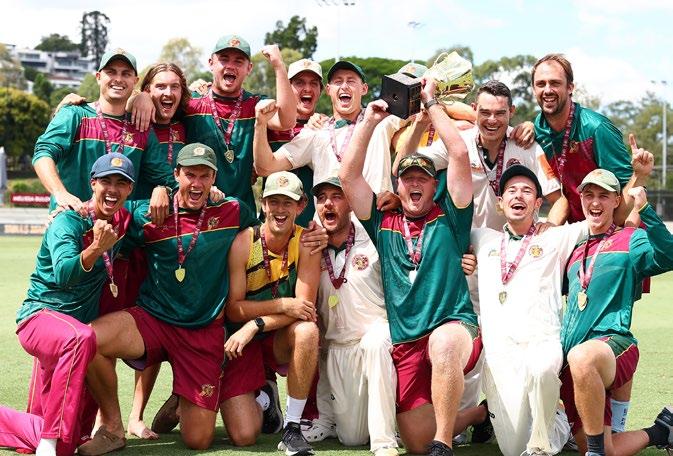
Needing 113 runs for victory on the final day, Stephen Muller and Sam Heazlett both hit half centuries to complete the victory, which was set up by a strong showing on the opening weekend of the four-day final.
A stand-out effort from off-spinner Jackson Sinfield was the centrepiece of the win, with the Bulls rookie player taking 10 wickets for the match including 7-83 in the first innings as UQ were dismissed for 228.
He also scored 48 not out in the Tigers first innings response of 325 and fittingly claimed the Andy Bichel Medal as Player of the Final. Allrounder James Bazley top-scored with 91 for Redlands.
University, with Bryce Street fighting hard with 73, scored 206 in their second innings to give themselves a lead of 110 and a hope of upsetting a Redlands line-up that had been bolstered by Test batsman Marnus Labuschagne for the second week.
Redlands captain Simon Milenko picked up 5 wickets in the second innings.
In other grades, South Brisbane took out both the Second and Fifth grade premierships.
Souths beat Gold Coast outright in a strong display, showing why they were on top of the Alan Pettigrew Shield ladder all season.
Souths Fifth Grade chased 273 to beat the home team Norths, a memorable victory for the Magpies in the Roy Tanner Shield which were strongly supported by their Second Graders and shared the joys of winning together.
Norths Third Grade secured a rare reverse outright. Playing at home, Norths lost first innings to Uni, falling 20 short of the target score of 250.
Norths then rolled Uni for 80, before chasing the 100 runs in the second innings without losing a wicket to claim the Norm McMahon Shield.
Norths Fourth Grade also secured the Bob Spence Shield premiership on the adjacent home field, defeating Valley outright.
Valley 1 defeated defending champions Redlands in Sixth Grade to finish with the WEP Harris Shield.
With the inaugural KFC T20 Max competition successfully launched in 2022-23 (see separate section), the Kookaburra One Day competition was fiercely contested.
Gold Coast maintained their recent white ball prowess, retaining the one-day title with a hard fought win over Norths.
Valley went back-to-back in the Under-19 men’s competition, defeating Northern Suburbs in a competitive clash that was distinguished by half centuries to Valley batsmen Cooper Mackie (86) and Hugh Weibgen (68). Archie Ramanathan (4-27) was Valley’s bowling pick while Ryan Forrester top-scored with 63 for the Vikings.
In the Under-17 Lord’s Taverners Queensland competition, Western Suburbs reaped the benefits from their strong youth program to defeat Valley in the Final to clinch the trophy. Jack Sonter (90) and Kye Martin (4-17) were stand-outs for Wests.
There were again a pair of first-time winners for the major individual awards at the Premier Cricket end of season presentation evening.
University of Queensland opening batsman Bryce Street and Sunshine Coast wicketkeeper Mikayla Wrigley claimed the Peter Burge and Kath Smith Medals respectively.

Street’s move from Sandgate-Redcliffe to University of Queensland proved to be fruitful for the Queensland contracted player, dominating the season with the bat and the ball.
The 25-year-old scored 1080 runs at an average of 67.5 across all formats (not including finals), with three centuries and six half centuries.
His 201 not out against Ipswich was his best return, in what was a record-breaking opening partnership of 0/423d alongside Angus Lovell.
Street also performed soundly with the ball, claiming 29 wickets at 21.38, which included a haul of 8-48 in round eight against Toombul.
Both Wrigley and Street were named in their respective Teams of the Year.
Toombul’s Aubrey Stockdale claimed the Bob Spence Trophy as the Most Improved U21 player.
Stockdale took 48 wickets at 22.4, including a season best haul of 7-56.
Northern Suburbs took home the Club Championship and the Damien Mullins Cup (First Grade Overall Champions), capping off a successful season for the Vikings.
There were a staggering 51 centuries in two-day cricket this season.
Street and Angus Lovell both scored double centuries for UQ, while Ipswich allrounder
Harry Wood’s 227 not out and 201 were a standout. Making Wood’s double double’s even more special was the fact they were in back-to-back matches.
Wood and Lovell finished the year with three scores of more than 140 each.
Street not only scored big runs this season but finished with the best bowling figures too. His 8-48 in Round 8 against Toombul edged out the three 7 wicket hauls by Blake Maher, Aubrey Stockdale and Jack Sinfield. A special mention to Sinfield, whose 7-83 earned him a man of the match in the Final and completed a treble of five wicket hauls in the summer.
Street also showed his class in the one-day competition, hitting a memorable 134 for UQ against his former side SandgateRedcliffe.
Experienced spinner Cameron Boyce was at his leg spinning best against his former side Toombul, taking 5-14 to lead Valley to victory.
Bryce Street (UQ)
Angus Lovell (UQ)
Harry Wood (Ipswich)
Sam Truloff (Wests)
Steven McGiffin (Wests)
Jack Wildermuth (Valley)
Harry Walker (UQ)
Harmon Sandhu (Souths)
Aubrey Stockdale (Toombul)
Jon Stimpson (Redlands)
COACH: Simon Belston (Redlands)
STA Groundsman Awards
Most Improved Groundsman Award: Ben Johnston
First Grade Wicket & Ground: Daniel Bronish Groundsman Award: Jonathan Walker
The Sunshine Coast Scorchers, one of the newest clubs in the Katherine Raymont Shield, clinched their second title in three seasons as they triumphed in the 2022-23 season.
Home grown talent blended with an overseas leader proved the winning formula for the Scorchers, which defeated University of Queensland in the Final at Allan Border Field.
It was the second title in three seasons for the Scorchers, which won their first Katherine Raymont Shield in their inaugural season in the competition in 2020-21.
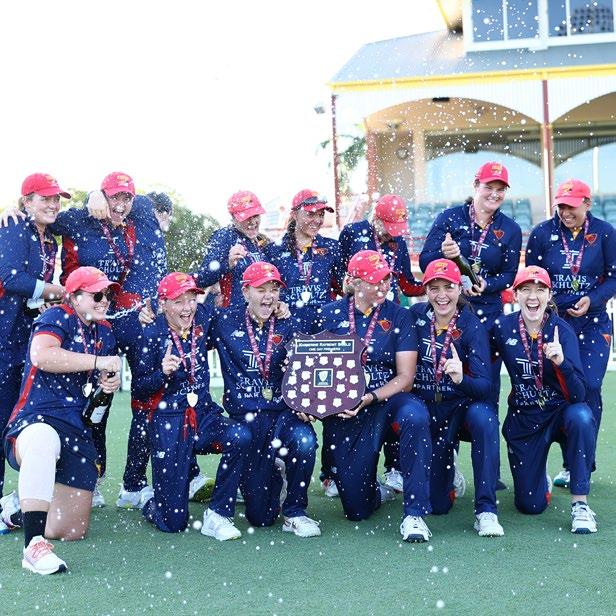
English import Georgie Boyce did not miss a trick at Allan Border Field as the Scorchers captain produced a player of the match effort, scoring 108 from 135 balls as she combined with young guns Ruth Johnston (69 from 59 balls) and Mikayla Wrigley (71 from 56 balls) to overpower Uni.
The right-handed top order bat claimed the Julia Price Medal for her 108 off 135 balls performance.
Sunshine Coast finished with 5-329, with Boyce
dismissed in the 46th over, before the Scorchers dismissed UQ for 242 after 47 overs of their run chase.
Boyce, 24, has played extensively in the United Kingdom and brought the experience earned in The Hundred (Manchester Originals) and in county cricket for Nottingham and Lancashire to bear when it was needed in the 2022-23 Final.
University of Queensland left-arm wrist spinner Laura Scheiwe claimed 2-55.
Johnston, who made her Women’s National Cricket League debut for Queensland during the season, took on the Allan Border Field boundaries with eight fours and three sixes while Queensland Under-19 wicketkeeper Wrigley hit 12 fours as she motored to a half century at a strike-rate of 126.79.
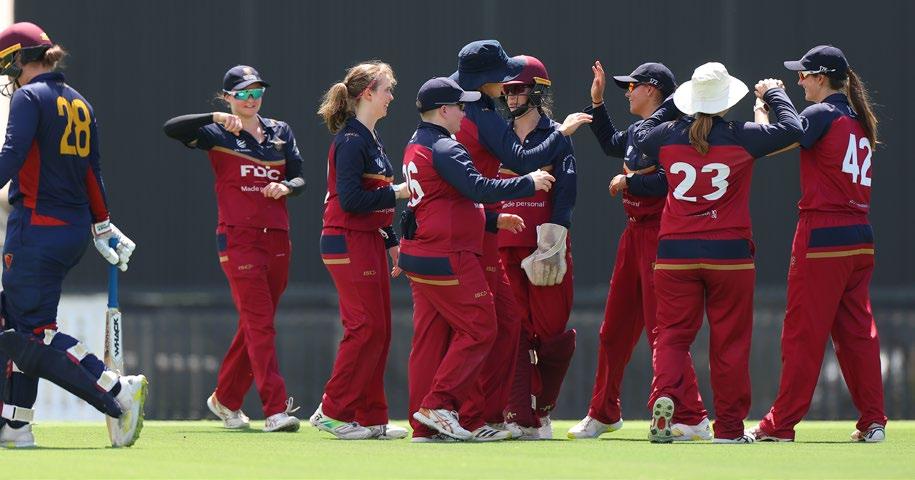
UQ looked to Queensland Fire and Brisbane Heat allrounder Charli Knott to lead their chase, and she produced a fighting 81 from 82 balls. However, the run-rate mounted quickly, and the Scorchers were able to maintain pressure on the chasing team despite quick runs from Nic Hancock (30 from 27 balls).
Scheiwe was the last batter dismissed for 20 with Emma Blamey 15 not out.
Pace bowlers Maddie Duncan (2-48) and Shari Anderson (2-38) were multiple wickettakers for the premiers, while Lucy Hamilton, Ruth Johnston. Ruby Orchard and Mahli Rea each claimed a wicket.
Wrigley became the inaugural Kath Smith Medallist from the Sunshine Coast Cricket Club, with the keeper / batter hitting 750 runs at an average of 50 to play a feature role in the Scorchers
Katherine Raymont One Day Shield Premiership.
Valley batter Kira Holmes, who made her WNCL debut for the Queensland Fire during the season, scored 865 runs at 34.6, including two centuries, and took 26 catches and 11 stumpings to receive the Loretta Moore Trophy as the Most Improved U21 female player.
In the Jodie Purves Second Grade Shield Final, Western Suburbs overcame defending premiers South Brisbane in a determined performance.
Souths were held to 6-112 with Matilda Ingram (48no) underpinning their effort, before Wests delighted the Graceville crowd with a composed chase of 3-113, with Taylor Hamblin adding 37 to her 2-14 and wicketkeeper Chelsea Sonter finishing 30 not out. Wynnum-Manly defeated University of Queensland to claim the Kirby Short Cup in the Under-19 women’s competition.
Georgia Voll set a Women’s First Grade record in Round 28 against Wynnum-Manly, plundering 209 off 155. The 19-year-old batting sensation lead Sandgate-Redcliffe to 4-400 in that match, which included an opening stand with Tess Cooper of 329. There were two seven wicket hauls in Women’s First Grade. Charli Knott’s 7-18 against Sandgate in Round 19, and Rebecca Kuiters 7-33 against the Sunshine Coast. Kuiters’ inspired effort helped lead Sandgate to a win defending the skinny total of 180. Knott’s bowling decimated Sandgate, UQ chasing the Gators 61 for the loss of four wickets.
Kira Holmes (Valley)
Georgie Boyce (Sunshine Coast)
Courtney Sippel (Gold Coast)
Mikayla Wrigley (Sunshine Coast)
Tess Cooper (Sandgate-Redcliffe)
Mikayla Hinkley (Valley)
Anlo van Deventer (UQ)
Sianna Ginger (valley)
Charli Knott (UQ)
Georgia Prestwidge (Valley)
Zoe Valencic (Sandgate-Redcliffe)
COACH:
Daniel Book (Sunshine Coast)
Gold Coast completed their third T20 victory in as many seasons, receiving the Tom Veivers Cup to make it a hat-trick of titles, clinching victory in the inaugural KFC T20 Max competition with two balls to spare.
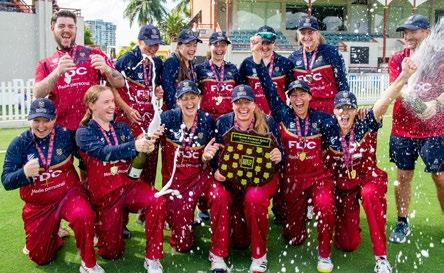

The beginning of the 2023-24 season saw a new venture for premier cricket take place, the KFC T20 Max.
A host of state contracted players, BBL and international players descended on SouthEast Queensland to compete in what rapidly became clear would be the country’s premier club cricket competition.
The men’s tournament was played over three weekends in the pre-season, with all KFC Queensland Premier Clubs competing, while the women’s competition was held during its regular season slot with a view to re-aligning it with the men’s window in 2023-24.
The Brisbane Heat kept two spots on their BBL playing roster free with a view to signing home-grown and interstate talent.
As it turned out, four were signed as contracted or local replacement players, with Spencer Johnson, Josh Brown and Nathan McSweeney all producing significant BBL moments and rising paceman Will Prestwidge secured for two seasons.
Norths lost just one game in the regular season round and finished with the leading runs-scorer in Brown (447 runs at 63.86) and leading wicket-taker Scott Rodgie, the Sydney Northern Districts allrounder who claimed 16 wickets at 11.63.
Brown’s 157 and 146 not out were the top batting performances of the KFC T20 Max. His big hitting exhibitions against Ipswich and University undoubtedly put him further on the radar than he already was, eventually earning his spot in the Brisbane Heat and Queensland One Day sides.
With the ball, paceman Will Crook’s 6-12 for University against Redlands was the best return for a bowler in the tournament. A special mention to Rodgie who took 5-18 against Uni including a hat trick.
Gold Coast and South Brisbane clinched Finals spots in an exciting round of semi-finals to play-off at Allan Bprder Field.
After batting first, Souths looked capable of defending their total of 6-151, taking regular wickets as the scoreboard pressure in the chase began to mount on the defending title-holders.
But Gold Coast recruit Caleb Ziebell, another regional star attracted to the inaugural KFC T20 Max competition, produced a nerveless all-round game as he and Dolphins regular Emmaus Benn delivered a strong Power Surge before holding their nerve in the final overs to finish 6-152.
Ziebell, named in the NSW Country Cricket Team of the Decade in 2021, was recruited to the Dolphins from Cudgen on the recommendation of Brisbane Heat and Queensland Bulls batsman Max Bryant, another to hail from the Tweed coastal town.
The strongly built Ziebell, who also plays rugby league for the Cudgen Hornets, finished 37 not out from 20 balls as the Dolphins took out the title.
Fittingly, Ziebell, who also took 1-13 from four excellent overs, was named the Andrew Symonds Medal winner as the Player of the Final.
The Dolphins brains trust of head coach Andrew Robinson and first grade coach Nick Buchanan were delighted at the all-round effort of the team, with the two ex-Heat players enjoying the performances of Bryant, allrounders Josh Kann (a century-maker in the semi-final) and Hugo Burdon, pace bowler Jackson Smith as well the captaincy of Matt Kuhnemann across the tournament.
South Brisbane was making their first Finals appearance in 21 years, with several members of their previous two-day premiership line-up at the venue.
The experienced coaching duo of Ken Healy and former Adelaide Strikers assistant coach Joe Dawes drew together a well-rounded T20 squad which timed their winning run almost to perfection.
They overcame Wests y in the semi-final and looked set to take that momentum into the Final, which was staged before a good crowd with many fans staying on after the Brisbane Heat Family Day in the morning.
Souths made sure they had a target to bowl to, with the experienced Ben Cutting and impressive Sydney Premier Cricket recruit Dylan Hunter taking advantage of the fielding restrictions early to bolt to 41 from the first three overs before Cutting was dismissed.
Hunter, who plays for Gordon, hit 38 from 25 balls and the Souths total grew steadily through the likes of wicket-keeper Brendon Faber (34), captain Gurinder Sandhu (21no) and former AFL player turned cricketer Claye Beams (14 off 7 balls).
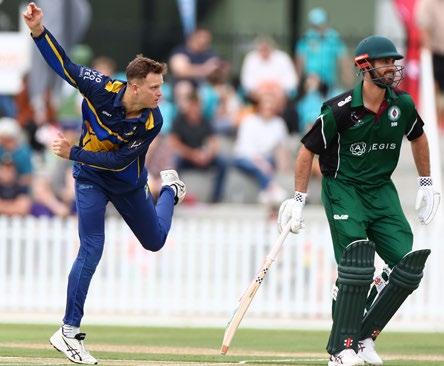
The Dolphins lost trumps Bryant and Kann early, as Gurinder Sandhu and brother Harmon struck early.
Burdon, who top scored with 41, and Queensland Under-19 player Judd Markham (34) got the chase in order before young Souths leg-spinner Connor McMillan picked up two wickets in an over to give the Magpies a chance of swooping on the title.
The KFC T20 Max Team of the Tournament was chosen by the Heat coaching staff of
Josh Brown (Norths)
Max Bryant (Gold Coast)
Nathan McSweeney (Norths)
Lachlan Hearne (Toombul)
Steve Paulsen (Wests)
Nikhil Chaudhary (Norths)
Tyran Liddiard (Sunshine Coast)
Arjun Nair (Wests)
Scott Rodgie (Norths)
Jackson Smith (Gold Coast)
Spencer Johnson (Redlands)
COACH: Nick Buchanan (Gold Coast)
Tess Cooper (Sandgate-Redcliffe)
Tara Wheeler (Gold Coast)
Georgie Boyce (Sunshine Coast)
Mikayla Wrigley (Sunshine Coast)
Emma Jackson (University of Qld)
Mikayla Hinkley (Valley)
Sianna Ginger (Valley)
Eleanor Swanepoel (Valley)
Shanni Bloxsom (University of Qld)
Sophie Martin (Sandgate-Redcliffe)
Seccombe, Darren Lehmann and Andy Bichel and QC Selectors Chris Hartley and Ryan Harris.
The excitement reached similar levels in the women’s version of the KFC T20 Max competition later in the summer.
University of Queensland turned the tables on their rivals to take out the title, claiming some redress for Valley defeating them last season in the Final of the Katherine Raymont Shield one-day competition.
It completed an outstanding weekend for UQ, which were also impressive in winning their semi-final against Sunshine Coast
After winning the toss and sending Valley into bat, the Students quickly gained the upper hand.
New ball bowler Emmie Blamey claimed potential match-winner Mikayla Hinkley in her first over to boost their chances.
Blamey went on to claim the Melissa Bulow Medal for her bowling effort of 2-8 from three overs as Valley battled to 53, with the experienced Chris Coulson (15) top-scoring for her side.
Gillan Chalmers also claimed 2-9 from three overs.
UQ then charged to the title, finishing with
1-56 as reigning Kath Smith Medallist Ruby Strange (21no) and semi-final hero Emma Jackson (29) led the way to the title. The preliminary rounds produced some eve-catching efforts.
Among the stars was WBBL Brisbane and Queensland Heat batter Mikayla Hinkley who hit three half centuries for Valley and claimed a remarkable 6-2 off two overs against Wynnum-Manly, claiming the competition’s only five wicket haul.
Sandgate-Redcliffe’s Tess Cooper dominated with the bat, hitting the two top scores of
Ruby Orchard (Sunshine Coast)
Mark Daldy (coach, University of Qld)
92 not out and 86 not out. She also scored a further two half centuries for the tournament, finishing as the top run scorer by more than 100 runs.
UQ left-hander Emma Jackson hit 79 from 58 balls in the semi-final win over Sunshine Coast while Shanni Bloxsom was similarly impressive with the ball to claim 4-12.
English player Georgie Boyce, who has featured in The Hundred in England, was one of three Scorchers players to make the Team of the Tournament.
The coach of the team was UQ mentor Mark Daldy who has been a pivotal figure in the Students’ run of recent success.
Queensland completed a strong season in Youth cricket, with the Under-17 boys team collecting the national title with victory in Hobart in January and the Under-19 Qld Metro side finishing second after losing the Final to NSW in Adelaide in December.
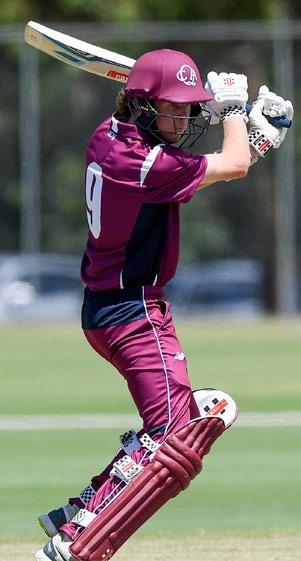
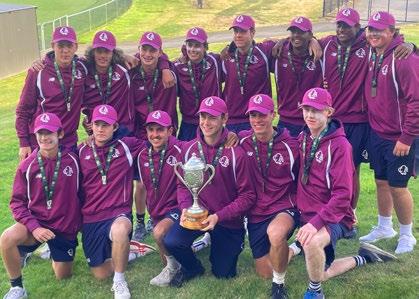
At the same tournament, Queensland Country Under-19 finished seventh, with an improved showing to win three games in just its second appearance at the national titles. Metro duo Lachy Aitken, who hit a top score of 157 during the championships, and Callum Vidler were chosen in the team of the tournament at the end of the titles.

Wynnum-Manly opener and wicket-keeper Reuben Burger hit 286 runs at 47.5 for the Metro team.
Cairns batsman Matthew Wilkin, the Country captain, hit his team’s highest score in the tournament with 103, while Toowoomba’s Rex Tooley was his team’s highest scorer with 203 runs at 40.
Jackson Evetts claimed 5-46 against the ACT and spinner Cody Saddler took nine wickets to be Country’s leading wicket-taker.
Several Queensland players also featured in the Australian Under-19 squad that played a series against their English counterparts in Brisbane, with Hugh Weibgen, Vidler, Aitken, and Tom Balkin all contributing solid performances.
Weibgen was subsequently chosen as captain of the Australian Under-19’s reciprocal tour to the UK in August 2023, while Aitken and Vidler were joined by Gold Coast paceman Cody Reynolds in the touring party which was chosen with an eye to the 2024 ICC under-19 World Cup in Sri Lanka. The Under-17 squad defeated NSW Metro in the Final in clinical fashion, restricting the Blues to 92 from 43.2 overs, before batting sensibly to finish 1-93 from 28.4 overs.
Queensland’s all-round strength of their bowling attack stood out as it did throughout the titles.
Jack Balkin (2-11), Griffith Williams (213), James Alexander (2-18) and Thisaja Samarawickrama (1-18) ensured the Queensland batters had the best possible chance to chase down the score.
Wests opener Daniel Skipwith finished 32 not out while Gold Coast bat Bailey Garnham scored 28 and Wests bat Jack Sonter was 19 not out.
It was a committed showing by the youthful Queenslanders, which lost two games during the preliminary games, but produced their best efforts in the championship rounds.
Queensland was unable to win back-toback Betty Butcher Shields at the National Under-19 women’s titles in Perth but gave a competitive account of itself with a squad that will have the bulk of its players eligible again next season.
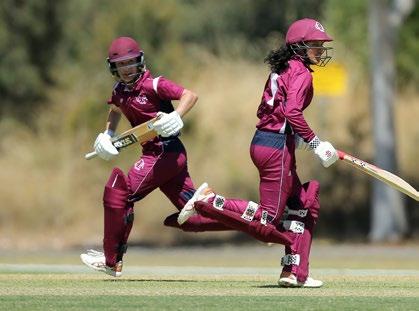
Bundaberg’s Lucy Hamilton and Townsville product Sianna Ginger were selected for the inaugural ICC Women’s Under-19 World Cup in South Africa in January where Australia made the semi-finals.
Ginger was Queensland’s captain and leading run-scorer with 237 runs to be the third highest scorer of the tournament while Warwick’s Lucinda Bourke also impressed with 190 runs including a highest score of 67.
Sandgate-Redcliffe finger spinner Darcy Johnson was Queensland’s leading wickettaker with 13, the fourth highest total in the championships. Wests leg-spinner Naiya Varidel claimed 10 wickes while Ginger and Hamilton each took nine wickets.
Alex Procopis (Northern Suburbs)
Amitoj Sidhu (Toombul)
Bailey Garnham (Gold Coast)
Carter Simpson (Sandgate-Redcliffe)
Curtis McAllister (Sunshine Coast)
Daniel Skipwith (Western Suburbs)
Eshwin Kapoor (Toombul)
Griffith Williams (Gold Coast)
Jack Balkin (Toombul)
Jack Sonter (Western Suburbs)
Jamie Alexander (University of Queensland)
Seth McGinty (Rovers, Cairns)
Thisaja Samarawickrama (South Brisbane)
COACH: Gavin Fitness
ASSISTANT COACH: Ryan Harris
RESERVE PLAYERS: Jackson Steinhardt (Wynnum-Manly)
Brayden Meegama (University of Queensland)
Talon Reichert (Sunshine Coast)
Fergus McFadyen (Northern Suburbs)
Hugh Weibgen (c, Valley)
Lachlan Aitken (vc, Gold Coast)
Angus Tolhurst (Western Suburbs)
Ashton Gumm (Gold Coast)
Callum Vidler (Valley)
Reuben Burger (Wynnum-Manly)
Tom Balkin (Toombul)
Cody Reynolds (Gold Coast)
Marcus Bean (Northern Suburbs)
Carter Pearson (Redlands)
Luke Davies (Western Suburbs)
Cameron Steinhardt (Wynnum-Manly)
Brodie Murphy (Sunshine Coast)
COACH: Ryan Harris
ASSISTANT COACH: Sam Ward
Sianna Ginger (c, Valley)
QLD COUNTRY
Paul Draheim (Darling Downs)
Hayden Evetts (Mackay Whitsunday)
Jackson Evetts (Mackay Whitsunday)
Lachlan Holmes (North Queensland)
Luke Maugeri (North Queensland)
Ryan McCarron (North Queensland)
Harry Meiklejohn (Darling Downs)
Jem Ryan (Darling Downs)
Cody Sadler (North Queensland)
Arshvir Singh (Darling Downs)
Rex Tooley (Darling Downs)
Harrison Tzannes (Darling Downs)
Matthew Wilkins (Cricket Far North)
COACH: Tony Hampson (NQ)
ASSISTANT COACH: Wade Frazer (CFN)
PHYSIO: Andrew Boyle (NQ
Lucy Hamilton (vc, Sunshine Coast/ Across the Waves CC
Tara Staines (Sunshine Coast/ Across the Waves CC)
Amy Hunter (Sunshine Coast/ Atherton CC
Bonnie Berry (Sunshine Coast/ Emerald Brothers CC)
Mikayla Wrigley (Sunshine Coast)
Holly Barr (Wynnum Manly)
Darcy Johnson (Sandgate-Redcliffe)
Taylor Stumer (Sandgate-Redcliffe/ Across the Waves CC)
Rebecca Kuiters (Sandgate-Redcliffe)
Lucy Bourke (Valley)
Naiya Varidel (Western Suburbs)
Trinity Doyle (Ipswich)
COACH: Mark Sorell
ASSISTANT COACH: Delissa Kimmince
Christina Coulson (Capt, Valley, Brisbane)
Clodagh Ryall (VC, Wynnum-Manly, Brisbane)
Courtney Hagen (Valley, Brisbane)
Grace Abdy (Wanderers, Townsville)
Lucy Neumann (Ipswich, Ipswich
Rosie McMahon (Sunshine Coast, Sunshine Coast)
Taylor Fitzgerald (Sunshine Coast, Sunshine Coast)
Kameryn Bray (Wynnum-Manly, Brisbane)
Grace Warcon (Caboolture, Caboolture)
Keiryn Lenoy (Norths, Cairns)
Melissa Parter (Brothers, Mackay)
Tracee Williamson (Pioneer Valley, Mackay)
Carys Underwood (Sunshine Coast, Sunshine Coast).
COACH: Ash Renouf
MANAGER: Tamika Hansen
QC STAFF: Zoe Eisenmenger
Tyran Eggmolesse (Northern Suburbs, Brisbane)
Jake Coolwell (Toombul, Brisbane)
Cruz Baker (Northern Suburbs, Brisbane)
Kieren Gibbs (Highfields-Railways, Toowoomba)
Jake Turner (Northern Suburbs, Brisbane)
Dylan McLachlan (Valley, Brisbane)
Steve Roser (Gracemere, Rockhampton)
Cameron Moodie (Souths, Toowoomba)
Brad Radford (Wynnum-Manly, Brisbane)
Kaiel Newcombe (Rovers, Cairns)
Jackson Plumb (Wynnum-Manly, Brisbane)
Jamison Allan (Broadbeach-Robina, Gold Coast)
Lachlan Marks (Toombul, Brisbane)
Men’s Coaching Staff:
COACH: Worrin Williams
ASST COACH: Michael Prein
MANAGER: Adrian Coolwell
QC STAFF: Mick Rees
The return of the National Indigenous Cricket Championships in Alice Springs in February after a two-year absence due to the pandemic produced an historic first title for Queensland.
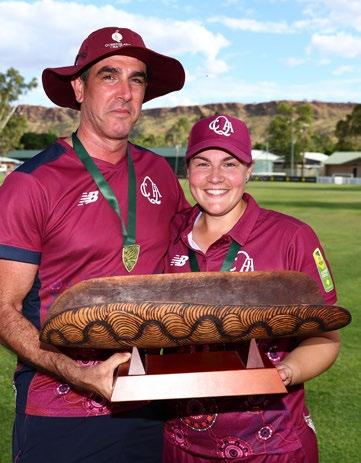
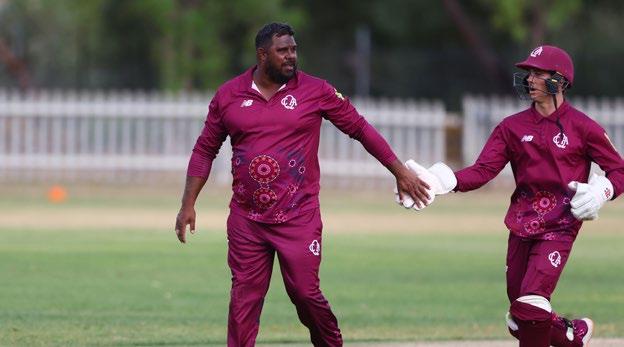
The Queensland Women’s Aboriginal and Torres Strait Islander squad went through the titles unbeaten, with captain Chris Coulson finishing as the leading wicket-taker and Mackay’s Tracee Williamson the player of the final.


The men’s Aboriginal and Torres Strait Islander squad had injury and illness concerns around the tournament but finished fifth with some good wins amongst their campaign in what was a rewarding return to the Northen Territory.
The Queensland women were constant throughout the tournament, with their efforts in the Final testimony to their consistency.
Queensland held NSW to 5-77 from its 20 overs and then charged to 2-81 from 10.1 overs to complete a memorable victory at Traeger Park.
Williamson led the way with 41no from 28 balls to claim the player of the match award.
Lucy Neumann (14) and Courtney Fewquandie, a member of the original Queensland women’s team that competed for the first time in 2013, hit 10 before Cloncurry teenager Grace Abdy (5no) was there for the winning runs.
Williamson, representing Queensland for the first time in the NICC, was the team’s leading runs-scorer and claimed eight wickets.
Coulson had led the way with the ball, with the captain snaring 2-9 from her four overs, finishing with 14 wickets at 4.21 for the tournament.
Queensland also claimed the Spirit of Cricket award for the women’s division.
The victory continued a run of ‘firsts’ for coach Ash Renouf, who also steered the Sunshine Coast Scorchers women’s team to their inaugural Premiership in the team’s first year in the Katherine Raymont Shield.
The Queensland men’s squad unveiled several promising talents including Norths teenager Cruz Baker who finished equal second in the player of the tournament standings.
Baker hit two half centuries and along with Valley batsman and Queensland captain Dylan McLachlan, was the team’s leading runs-scorer.
Queensland beat South Australia in their play-off to finish the tournament on a high. Rockhampton left-hander Steve Roser top-scored with 51 and McLachlan hit 35 while paceman Jack Coolwell claimed 3-31.
Chasing South Australia’s 9-129, Queensland needed 10 off the final over and Roser delivered, hitting a six off the third ball to bring up his 50 and get his team on target before Toombul’s Lachlan Mark nabbed the single off the last ball to win.

Following the championships, Cricket Australia selected men’s and women’s squad to make an historic tour of Vanuatu in March.
Coulson, Abdy and Clodagh Ryall were chosen from the championship Queensland women’s team while WBBL Heat and Queensland Fire batter Mikayla Hinkley was also named in the Australian squad.
McLachlan was chosen as vice-captain of the Australian men’s squad.
The Queensland Country Brahmans and Brolgas made a competitive return to the Toyota Australian Country Cricket championships in Canberra in 2022-23.
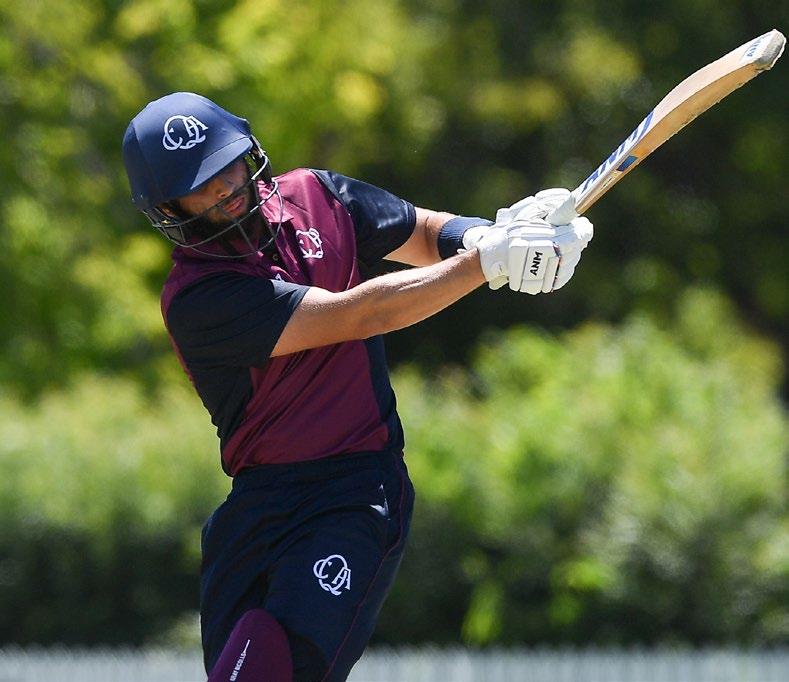
The teams, which were assisted in their final preparations by Queensland Cricket identities
Jimmy Maher, Luke Feldman and Gavin Fitness, participated in the first titles to be held in two years following the pandemic.
The titles featured teams from Western Australia, South Australia, Victoria, ACT, Queensland and East Asia Pacific.
The Brahmans men’s team was led by Townsville’s Sam Lowry while the Brolgas women’s team was captained by Sunshine Coast wicket-keeper Mikayla Wrigley, who played in the recent Australian Under-19 championships.
The Brahmans claimed third after finishing the regular fixtures on the same points as second-placed WA, only to miss on Net Run Rate while the Brolgas were fourth, one point off third
Lowry was the leading runs-scorer for Queensland with 209 runs including a top score of 78 while Gold Coast paceman Sam Yabsley was the leading wicket-taker in the competition with 14 scalps at 11.07.
Wrigley was likewise the leading runsscorer for the Brolgas with 215 runs at 43.00 while Tarah Staines claimed six wickets to be Queensland’s leading bowler.
Members of the Brahmans team also played in the Bulls Masters T20 Country Challenge Final at the Gabba, which saw Far North Queensland Fusion (6-184) defeat North Queensland Monsoons (8-176).

The Brolgas squad included several players with experience in the Katherine Raymont Shield in the KFC Queensland Premier Cricket competition.
Young Atherton pace bowler Amy Hunter was the 2021 holder of the Jodie Purves Scholarship awarded by the Toowoomba product to a young regional female player. The Queensland Country Under-19 men’s team also competed at national level for the second time.
David Heymer (Central Qld)
Scott Sanderson (Southeast Qld)
Craig McElligott(VC) (North Qld)
Sam Lowry (c) (North Qld)
Lachlan Ford (North Qld)
Jake Roach (Cricket Far North)
Joe McGahan (Central Qld)
Sam Vassallo (Mackay Whitsunday)
Lane Kohler (Mackay Whitsunday)
Mason Kohler (Mackay Whitsunday)
Justin Dixon (North Qld)
Regan Hoger (Southeast Qld)
Sam Yabsley (Southeast Qld)
Logan Whitfield (Central Qld)
Coach: Troy Paradies (Central Qld)
Abby Toshach (v-c) (Cricket Far North)
Mikayla Wrigley (c) (Sunshine Coast/Wide Bay)
Phoebe Murphy (Sunshine Coast/Wide Bay)
Taylor Stumer (Wide Bay)
Chloe Murphy (North Qld)
Tarah Staines (Wide Bay)
Grace Abdy (North Qld)
Amy Hunter (Cricket Far North)
Breanna Craven (DD&SWQ)
Meghan McCartney (Mackay Whitsunday)
Hannah Courtnell (Mackay Whitsunday)
Olivia Winter (DD&SWQ)
Abbey Harvey (Central Qld)
Laura Scheiwe (DD&SWQ)
Coach: Anthony Clark (DD&SWQ)
A season to savour for paceman Michael Neser had its crowning glory with a near clean-sweep at the 2022-23 Queensland Cricket Awards Gala.
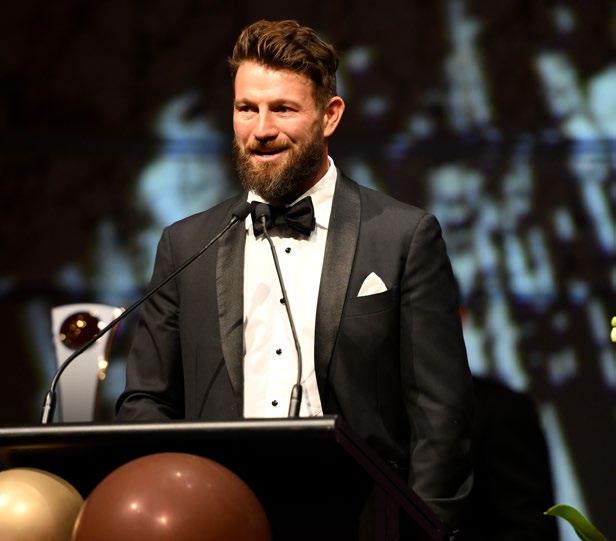
Neser claimed a record fourth Ian Healy Trophy as Queensland player of the year as well as taking out the Bulls’ Marsh Sheffield Shield and Marsh One Day Cup Player of the Year and Brisbane Heat BBL MVP awards.
The inaugural Jodie Purves Trophy, named in honour of the former Australian captain and wicket-keeper, was presented to hard-hitting batter Laura Harris.
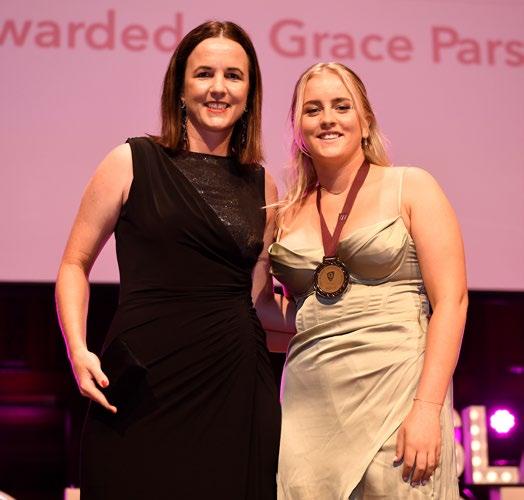
The trophy is awarded to the best female player from votes tallied across the Queensland Fire and Brisbane Heat seasons.
Harris, who also won the Queensland Fire Players’ Player award, produced several match-defining innings for the Fire and the Heat.
In the WNCL, she set the record for the fastest century of all-time, hammering 100 off just 50 balls against the ACT Meteors. In her 100th WBBL game, she produced the second fastest 50 of all time in the competition as she swept Brisbane to a win over Hobart.
Neser was equally eye-catching across all formats, finishing as the leading wicket-taker for the Bulls in the Shield and One Day competitions and the Heat in the BBL.
His 40 Shield wickets was the most in the regular season with Victoria’s Will Sutherland finishing with 41 after the Shield Final which was won by WA.
In the BBL, he finished as the second leading wicket-taker in the League, with his 26 wickets coming at an economy rate of 8.51. He also scored 141 runs, including a match-winning 48no against the Sixers to put the Heat into the Final.
Neser’s fourth Ian Healy Trophy win takes him clear of former Bulls legends James Hopes and Chris Hartley who each claimed the award on three occasions.
His Bulls fast bowling compatriot Mark Steketee was announced as the inaugural Andrew Symonds Medalist as the Queensland Players’ Player.
The award, named in honour of the former Queensland and Australian allrounder who passed away 12 months ago, was presented to Steketee by Symonds’ mother Barb and his children Chloe and Will.
The Jodie Purves Trophy and Andrew Symonds Medal were among three new awards presented at the evening, with the first ever Pike-Maher Medal also unveiled.
The award, named after former Queensland and Australian players Kirsten Pike and Jimmy Maher, is presented to a Queensland male or female player who has played a major role in creating a positive difference in their communities through charitable and community contributions.

Teenage Queensland leg-spinner Grace Parsons was announced as the inaugural winner for her efforts to assist the Lismore community during last year’s flooding events in the northern NSW regional city where she grew up.
While preparing for a WNCL game, she organised flood clean-up and retrievals during the catastrophic event. In the immediate aftermath, she donated her first Queensland match payment and coordinated similar donations from the Fire squad and their opponents South Australia.
Parsons, 19, also took out the Fire player of the year award with a strong first season showing of 15 scalps at an exceptional return of 20.66 and economy rate of 3.78.
New Zealand allrounder Amelia Kerr capped off her welcome return to the Weber Women’s Big Bash League by claiming the WBBL Heat MVP award.
After missing the previous season while having a break from the game, she was a stand-out for the Heat, scoring 243 runs and taking 19 wickets to be the only international player named in the Team of the Tournament.
Former Test batsman Joe Burns was acknowledged for his milestone of playing 100 first class games for his State with the presentation of a portrait painted by acclaimed sports artist Jamie Cooper.
QUEENSLAND CRICKET
2022-23 AWARD WINNERS
IAN HEALY TROPHY
Michael Neser
JODIE PURVES TROPHY
Laura Harris
PIKE-MAHER MEDAL
Grace Parsons
QUEENSLAND FIRE PLAYER OF THE YEAR
Grace Parsons
MARSH QLD SHEFFIELD SHIELD PLAYER OF THE YEAR
Michael Neser
MARSH QLD ONE DAY CUP PLAYER OF THE YEAR
Michael Neser
ANDREW SYMONDS MEDAL (Bulls Player’s Player)
Mark Steketee
QUEENSLAND FIRE PLAYER’S PLAYER
Laura Harris
BRISBANE HEAT WBBL MVP
Amelia Kerr
BRISBANE HEAT BBL MVP
Michael Neser
COUNTRY PLAYER OF THE YEAR male)
Sam Lowry
COUNTRY PLAYER OF THE YEAR female
Tarah Staines
The 2022-23 season was another filled with off field highlights for the Brisbane Heat. After two COVID disrupted summers, the Heat welcomed the return to a regular home and away season for the WBBL and BBL, with Heat teams playing games in more home markets across Queensland than ever before.
The Heat played matches at the Gabba and Allan Border Field in Brisbane, Metricon Stadium on the Gold Coast, Great Barrier Reef Arena in Mackay and took a BBL game to Cazalys Stadium in Cairns for the first time.
The Heat sold out Allan Border Field during the WBBL season, recorded its biggest BBL crowds in three seasons on the Gold Coast and the Gabba, while also welcoming a near capacity crowd to Cazalys Stadium.

The Heat successfully created and launched the “New Year’s Bash” event at the Gabba to kick off the new year on January 1 featuring music performances from Peking Duk, Ball Park Music, plus KLP and Stace Cadet.
The club also set a membership record with 5803 signing on in 2022-23.
In the broadcast space, the KFC BBL Final between eventual champions Perth and Brisbane was the most-watched game of the season and most-watched BBL game since the BBL|10 Final. It was the most-viewed BBL game ever on FOX and attracted a national TV average of nearly 1.4 million viewers across FOX, Channel Seven and streaming.
The Heat enjoyed a BBL cumulative TV audience of 12.3 million people across the season, a 33% increase from 2021-22. In an ever-changing media consumption and viewing market, the BBL was one of only two Australian codes to increase year-onyear linear TV viewership.
The WBBL also retained its place as a leader in the Australian sporting landscape, retaining its mantle as the fourth most watched competition in Australia on a per game basis. Despite taking place in a window in the sporting calendar that included AFLW, the Men’s T20 World Cup,


FIFA World Cup, Rugby League World Cup and Spring Racing Carnival, the Heat held its TV audience at 172,000 viewers per game.
Initiatives such as the BBL International Player Draft and the increased promotion of the summer of cricket saw the Heat’s media reach increase by 85% year-on-year. Heat fans continued to be entertained and inspired through the club’s digital media presence with the Heat retaining their mantle as the most followed sports club in Oceania.
The Heat were recognised as industry leaders in entertainment and fan engagement after being shortlisted for three awards at the Mumbrella Sports Marketing and Entertainment Summit. The Heat were shortlisted in the Best Owned or Social Media; Best Team or Sports Sponsorship for the club’s Great Southern Bank partnership; and, Best On-ground Activation for the StreetSmarts Innings Break Show. The winners will be announced in late August.





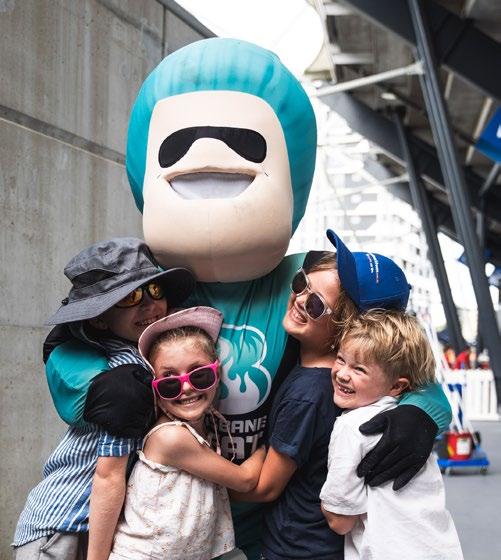
The Heat welcomed a new event to the summer sporting calendar in 2022-23 – the New Year’s Bash.
Kicking off the new year in style, the Heat welcomed a buoyant crowd of 23,269 to the Gabba on January 1– the club’s biggest home crowd since the COVID-19 pandemic. Fans were treated to a spectacular night of on and off field entertainment that featured 433 runs, a 15-run Heat victory, and a musical extravaganza.
The Heat’s score of 5-224 on the night was the fifth highest in the history of the KFC Big Bash League and the club’s biggest, with the total highlighted by maiden BBL half centuries to Nathan McSweeney (84 from 51 balls) and Josh Brown (62 from 23) who was playing in his second game for the club.
The New Year’s Bash featured performances from pop dance group Peking Duk, Brisbane rockers Ball Park Music, and electro duo KLP and Stace Cadet.


The night included the StreetSmarts Innings Break fireworks and lights show, sponsored by the Department of Transport and Main Roads, alongside Peking Duk playing their hit High and dance duo KLP and Stace Cadet playing popular tracks Happy People and Energy.
To celebrate the New Year’s Bash, several Brisbane landmarks were turned teal on January 1 including the Story Bridge, Victoria Bridge, Kurilpa Bridge and Raddacliff Place, with the initiative achieved through event partnerBrisbane Economic Development Agency.
The New Year’s Bash was the fifth highest rating game of the BBL regular season with a total national audience average of over 850,000 viewers.
Such was the success of the New Year’s Bash, the Heat has secured the game for BBL|13, with hopes it can form a permanent part of the Queensland sporting calendar and a much-anticipated summer event.
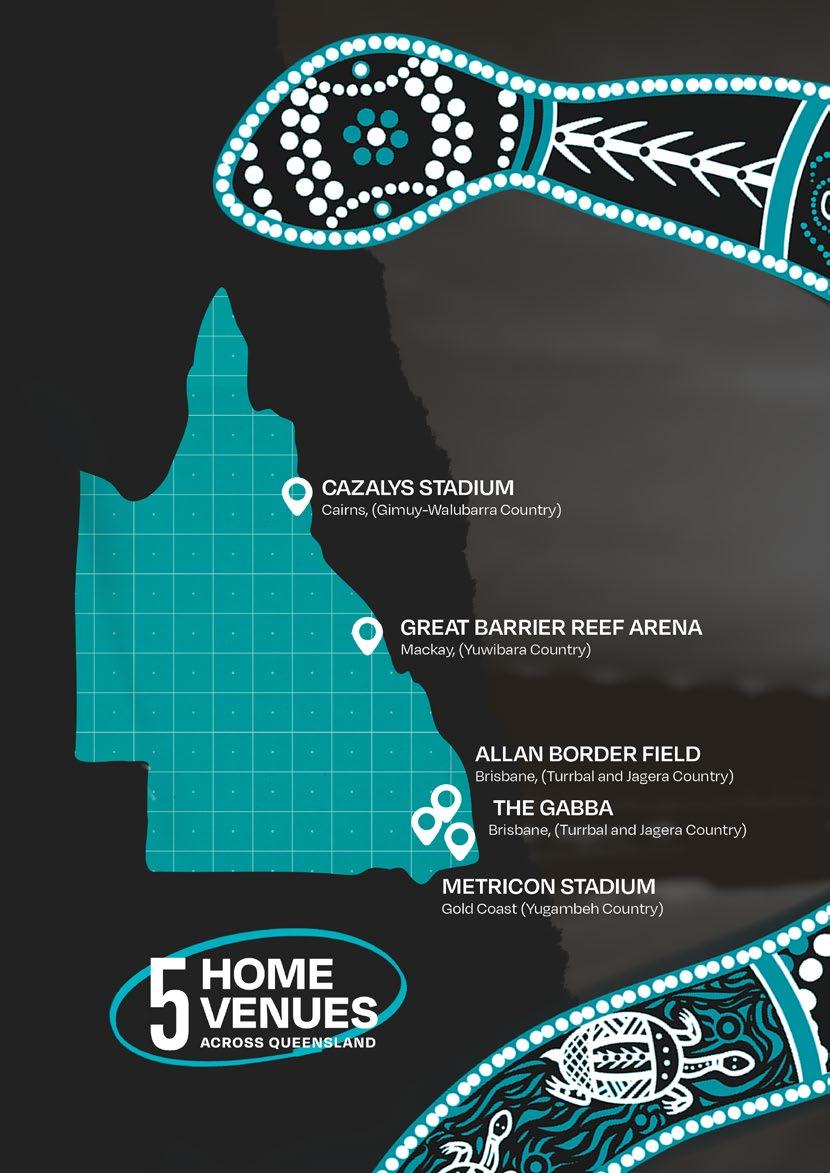

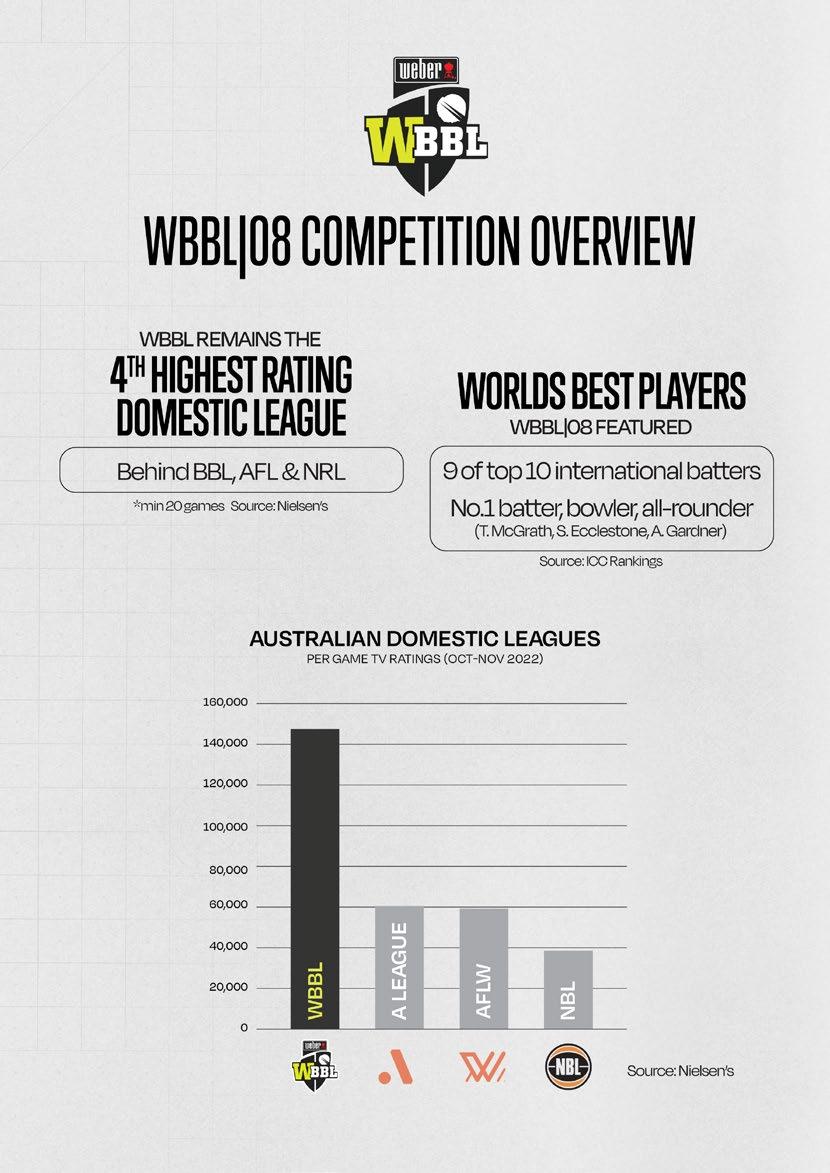

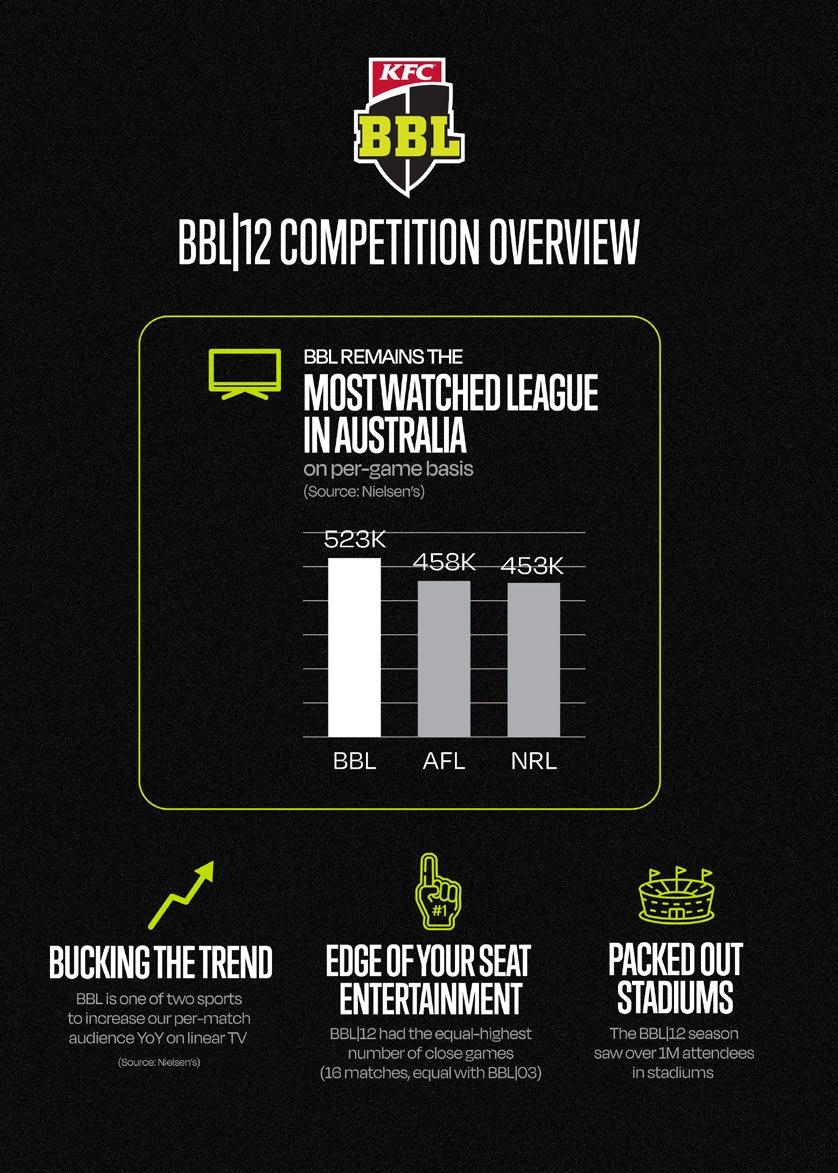

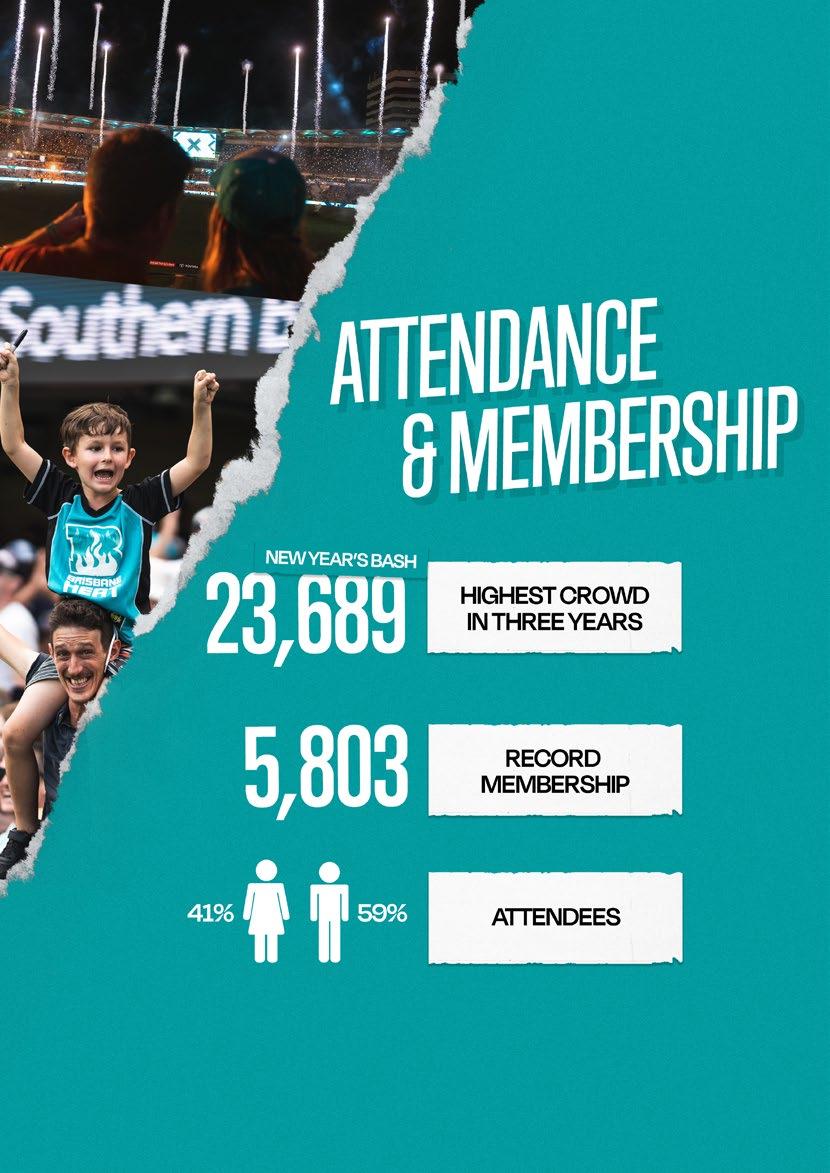
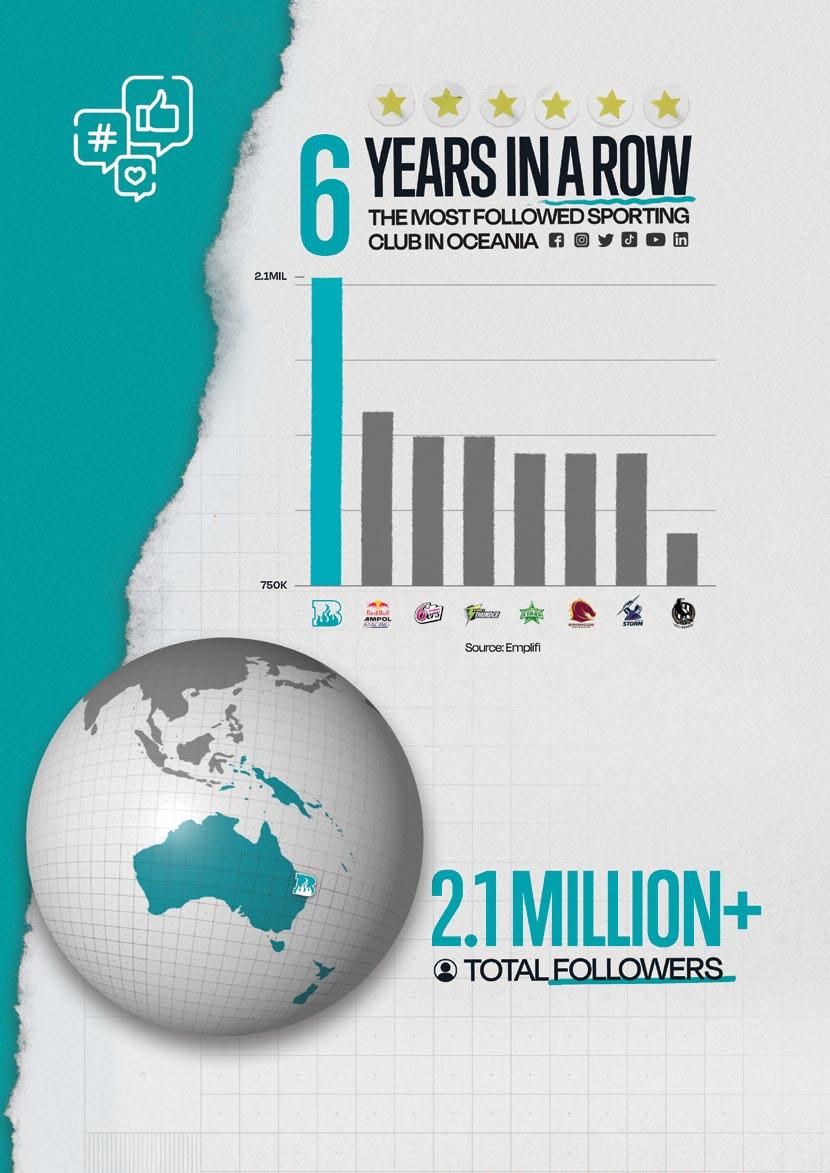
> Cricket Ipswich Inc
> Gold Coast Cricket District Cricket Club
> Northern Suburbs District Cricket Club Inc
> Redlands Cricket Inc
> Sandgate-Redcliffe District Cricket Club Inc
> South Brisbane District Cricket Club Inc
> Sunshine Coast Cricket Association Inc
> Toombul District Cricket Club Inc
> University of Queensland Cricket Club Inc
> Valley District Cricket Club Inc
> Western Suburbs District Cricket Club Inc
> Cricket Far North Inc
> Wynnum-Manly District Cricket Club Inc
> Queensland Country Cricket Association Incorporated
> Queensland Cricket Umpires’ & Scorers’ Association Inc
> Queensland Junior Cricket Inc
> Queensland Sub Districts Cricket Association Inc
> Warehouse Cricket Association
Queensland Inc
> North Queensland Cricket Association Inc
> Mackay-Whitsunday Cricket Inc
> Central Queensland Cricket Inc
> Wide Bay Cricket Inc
> Darling Downs and South West
Queensland Cricket Inc
> South East Queensland Cricket Inc
> Queensland Veterans’ Cricket
Former Australian and Queensland fast bowler
Michael Kasprowicz was presented with Queensland Cricket Life Membership by Chair Chris Simpson at the 2022 Annual General Meeting.
Kasprowicz made his debut for Queensland while still at high school and finished as the State’s all-time leading wicket-taker in first class cricket, with 505 dismissals across 115 games in 19 seasons for Queensland.

He played 38 Tests for Australia, claiming 113 wickets, as well as turning out in 43 One Day Internationals and two T20 Internationals.
His post-playing days have been distinguished by a nine-year stint as a director of Cricket Australia between 2011 and 2020 as well as a period as acting CEO of Queensland Cricket.
Kasprowicz is also a former President of the Australian Cricketers’ Association and a founding Director of the Bulls Masters, while he is currently President of Lord Taverners Queensland.
Equally, his influence on the grassroots of the game remains on-going.
In 2003, Kasprowicz agreed to be the face of Queensland Cricket’s inaugural Volunteer Recognition Program.
‘Kaspa’s Crew’ was the first program of its type to be introduced in Australian Cricket and continues to this day, acknowledging and rewarding volunteers throughout the State.
Queensland Cricket Scorers’ Association Inc.

Queensland Deaf Cricket Association
Australian Cricket Society (Queensland) Inc.
Queensland Blind Cricket Association Inc.
Queensland Primary Schools’ Cricket Association
The Associated Schools Inc. (TAS)
Queensland Secondary School Cricket
The Great Public Schools’ (GPS) Association of Queensland Inc.
The Lord’s Taverners (Australia) QLD Incorporated
Wanderers (Q) Club Inc
Queensland Police Cricket Association Inc
G Down 1908
BR Bale 1908
R Doran 1908
WB Slade 1909
TMW McWilliam 1909
GM Colledge 1909
J Allen 1911
SC Whittred 1911
WT Evans 1911
AE Oxenham 1912
WJ Lewis 1913
Col The Hon JFG Foxton 1913
T Muir 1913
EJ Beard 1919
MF McCaffrey 1919
WH Carvasso 1919
RA Alexander 1920
WH Henley 1920
JN Horton 1921
GW Ward 1922
HTA Wetzig 1922
MJ Hartigan 1923
JS Hutcheon 1923
CL Mossop 1925
AE Wyeth 1925
RA Alton 1926
WJ Fehlberg 1926
JP Orr 1927
LPD O’Connor 1928
FC Thompson 1929
JRD Mahoney 1930
RK Oxenham 1934
JH Holdworth 1935
PJ Carter 1936
LL Gill 1937
TM Barber 1938
JW Hoelscher 1940
JT Bale 1942
NJ Plaisted 1945
TE Williams 1946
PJ Frawley 1947
PM Hornibrook 1948
CF Moroney 1949
GE Lax 1950
VC Schaefer 1951
TJ Burge 1952
FP Malone 1953
BH Shaw 1954
WJ Scott 1956
QF Rice 1957
R McGhee 1958
MJ Whalley 1959
LDA England 1960
IH Townsend 1962
NT McMahon 1963
CO Apps 1964
KLM Mossop 1965
CL Saunders 1966
TS Redgrave 1967
C Jones AO 1968
JG Cooke 1969
EA Toovey MBE OAM 1970
EC LaFrantz MBE 1971
R Spence 1972
RG Teske 1973
GI Hornsby BEM 1974
RA Young 1975
KD Mackay MBE 1976
AC Pettigrew 1977
OD Driscoll 1978
VW Holland 1979
CR Richards 1980
HR Tanner 1981
BS McCahon 1982
CE Anstey OAM 1983
PJ Mullins OAM 1984
R Littledike 1985
RD Harris 1986
AC Battersby AM 1987
RP Easton OAM 1988
PJ Burge AM 1989
WEP Harris 1990
RR Lindwall 1991
WA Brown OAM 1992
JJ McLaughlin OAM 1996
SC Trimble MBE 1997
JA Maclean MBE 1998
RT Pascoe 1999
RG Archer AM 2000
JN McKnoulty AM 2001
GJ Madsen OAM 2002
TV Hohns OAM 2003
SG Law OAM 2004
TR Veivers 2005
DG Mullins SC 2006
P Stathis 2007
L Moore 2008
B Phelan OAM 2009
AR Border AO 2010
MW Johnson 2011
CG Rackemann 2012
G J Dixon 2013
LD Cooper 2014
IA Healy AO 2015
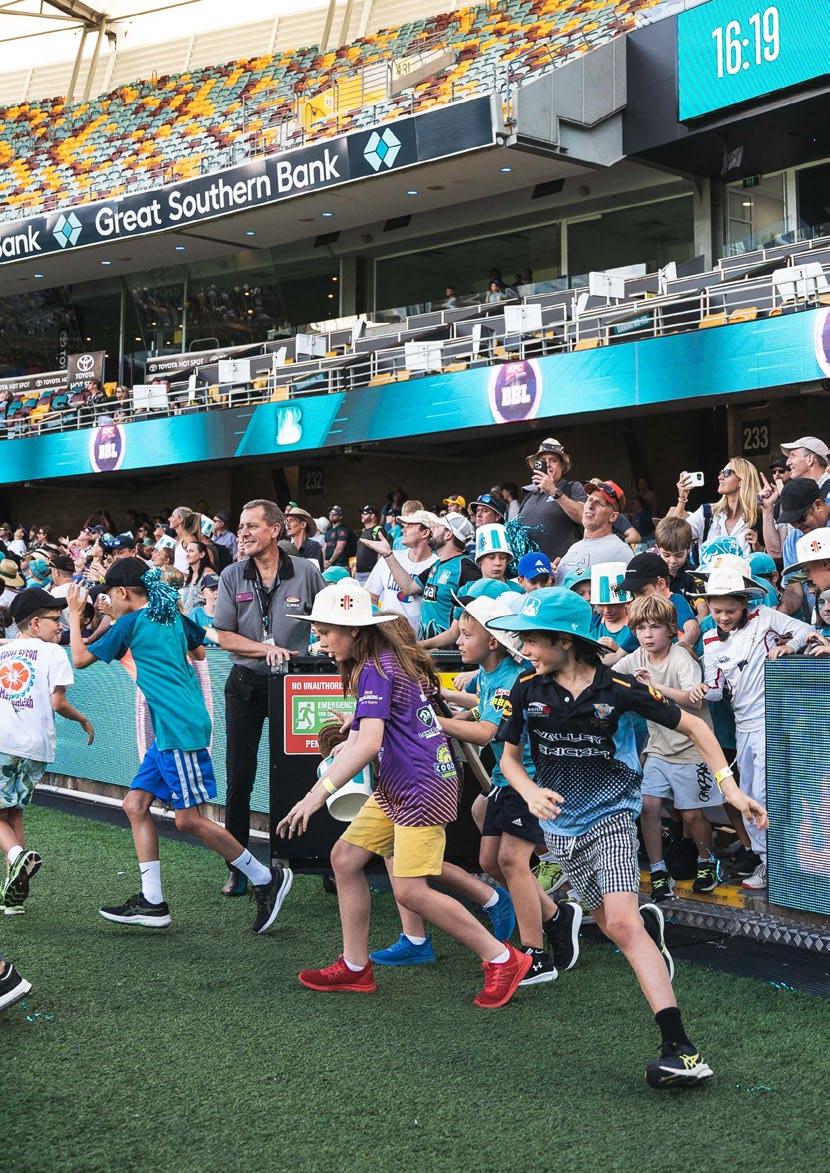
KG Raymont 2017
N Grout 2018
B Gaskell 2019
Kev Maher 2020
Peter Evans 2021
Michael Kasprowicz 2022
Queensland Cricket mourned the passing of former state captain and player Ron Archer in April, aged 95.
Prior to his passing he was Australia’s oldest living male Test cricketer.
He played 58 First Class matches as a top and middle order batsman for Queensland, scoring two centuries with a highest score of 118 in a state career that spanned 10 years. He also played five Tests for Australia and toured South Africa with the national team.
The retirement of the great Ray Lindwall and loss of rising allrounders Ron Archer and Jim Bratchford with injury and work commitments left Queensland Cricket with challenges to overcome in the early 1960s.
The State selection panel cast its net widely through the State’s pace bowling ranks, with the Rockhampton-born Keith Perrins among a host of likely types earmarked for higher honours.
After being one of the leading wickettakers in Brisbane First Grade cricket for Wests, including topping the 1959 list with 38 dismissals at 11.52 in their premiership season, he was included in Queensland’s early season trial games in 1960-61.
Former Queensland player, coach, selector and Life Member, Jack McLaughlin OAM passed away in March aged 93.
At the time of his death, he was Queensland’s second oldest male player and oldest Life Member, having received the honour in 1996.
Born in Corinda and a stalwart of the Western Suburbs club, the main playing field at the club’s home ground at Graceville was named in his honour a few weeks prior to his passing.
John ‘Jack’ McLaughlin made his first grade debut in 1947 for Wests after impressing as a schoolboy at Gregory Terrace.
After catching the eye as a 19-year-old in the Queensland Colts team at the start of the 1949-50 season, he subsequently made his First Class debut later that summer, taking on Victoria at the Melbourne Cricket Ground
Archer enjoyed three seasons playing in the First XI at the Anglican Church Grammar school in Brisbane before going on to play First Grade cricket for the University of Queensland.
Aged just 18 when he made his First Class debut against a touring 1946 England team, he went on to score 2,665 runs at an average of 28 for Queensland while assuming the state captaincy in the 1952-53 Sheffield Shield season. He also represented
Queensland in baseball in the Claxton Shield and was offered – but declined – a professional contract to play in the United States of America.
Part of a talented sporting family, his younger brother Ron also represented Queensland and Australia.
Archer enjoyed a successful career in media and broadcasting, and in 1980 was awarded a Medal of the Order of Australia for Services to Media.
Former Queensland and Australia fast bowler Peter Allan passed away in June 2023.
Allan, at one stage the State’s all-time leading Sheffield Shield wicket-taker and the only Queenslander to claim all 10 wickets in a Shield innings, was 87. He played one Test for Australia, making his debut in the opening clash of the 1965-66 Ashes tour at the Gabba in what became a roller coaster season for the tall right-arm quick who could swing the ball both ways.

In his debut, which also featured a teenaged Doug Walters in his first game for his country, he took the new ball and claimed 2-58 from 21 overs in the first innings and 0-25 in the second innings of the drawn match.
He was 12th man for the Second Test and omitted for the Third Test, only to earn a recall for the Fourth Test in the wake of his astounding performance for Queensland against Victoria in the Sheffield Shield at the MCG in January 1966.
His remarkable summer had one final highlight, taking another 10-wicket haul in an innings, this time for South Brisbane in the Brisbane First Grade competition in March 1966.
Allan continued opening the bowling for Queensland until he retired after a successful 1968-69 season in which he headed the national averages with 46 wickets at 16.36.
The Boonah-based Perrins was selected to make his debut at the Gabba in the opening game of the 1960-61 Shield season. It was a stirring baptism of fire, with his initial two games coming up against a star-studded NSW line-up including Australian players Richie Benaud, Neil Harvey, Brian Booth, Ian Craig, Alan Davidson, and Norm O’Neill. Better fortune was to come in his third game, against WA in Perth, when Queensland won outright after giving up a first innings lead. Perrins claimed career best figures of 3-42 and made 19 not out.
His fourth and final game for Queensland came in the loss to Victoria in Melbourne, with the home side featuring the likes of Bill
Lawry, Bob Cowper, and Lindsay Kline, who took nine wickets in what was a comfortable outright win.
In his post-playing life, he was a popular and long-serving publican in Maryborough where he was involved in supporting several local sports including cricket, rugby league and the Granville Hockey Club near where he lived.
The Hotel Francis in Maryborough (which was known as Keith Perrins’ Hotel Francis) formed part of the setting for Kylie Minogue’s movie The Delinquents and was later heritage listed as one of the oldest establishments of its type in the city.
Born on 17 January, 1931, he passed away in Maryborough on 23 June, 2023.
He made a belated Test debut as a 29-year-old after making his first-class debut for Queensland in 1959-60 and touring the West Indies with Australia in 1964-65.
Diagnosed as a diabetic before the tour, he battled illness for much of the trip after making a promising start with a five-wicket haul against the Leeward Islands. Unable to push for a Test berth due to illness, he was forced to wait until England toured the following summer to make his mark at the highest level.
Allan finished with figures of 10 for 61 from 15.6 overs. He bowled unchanged in the innings, and with the overs being eight-ball overs at the time, it was the equivalent of 21 consecutive six-ball overs.
He was only the second player in Australian first-class cricket history to take all 10 wickets in an innings, and with WA’s Ian Brayshaw achieving the same feat the next season, was one of only three players to do so.
He succumbed to an ankle injury on the eve of the Fourth Test, which saw him replaced by Graham McKenzie and he was subsequently overlooked for future Tests.
His Sheffield Shield career tally of 182 wickets at 25.29 was the all-time record at the time.
In 57 first class games, including 52 matches for Queensland, he took 206 wickets at an average of 26.10 and claimed 5 wickets in an innings on 12 occasions to go with his 10-wicket haul. His post-cricket career featured a variety of roles, including with the Brisbane City Council where he held a senior post managing Queen Elizabeth II Stadium post the 1982 Commonwealth Games, as a hotel publican, and a civil celebrant on Hamilton Island.
under the captaincy of Bill Brown who was in his last season for Queensland.
McLaughlin made 58 as an opener on debut and went on to play 59 First Class and 56 Sheffield Shield games for the State between 1949-50 and 1962-63.
McLaughlin hit 2988 first class runs at 33.95, with a highest score of 146. That knock was one of two centuries he scored in the 1957-58 season, which he topped off by leading Western Suburbs to a first grade premiership.
His best summer was in 1959-60 when he hit 740 runs at 49.33, including two centuries and six half-centuries. He captained Queensland on three occasions.
An elegant batsman and exceptional fielder who cut a distinctive figure in the field due to his preference of wearing a white floppy ‘washing hat’, he also represented
Queensland in Claxton Shield baseball from 1948 to 1956.
He was a Queensland cricket selector from 1965-66 to 1975-76, and a respected coach, overseeing Shield preparations, mentoring promising first grade players, and travelling widely throughout the State to deliver junior development programs under the Utah Coal State Coaching program during the 1970s.
He was also a regular commentator for the ABC and columnist for The Courier-Mail in his post-playing days.
In his later years, he farmed cattle at ‘Emerald View’ at Grandchester.
He was a life member of both Queensland Cricket and Wests and received an Order of Australia medal for his services to cricket in 1993.
Queensland Cricket Association Ltd
Queensland Cricket Association Ltd
Directors' report
30 June 2023
The Directors present their report on the consolidated entity consisting of Queensland Cricket Association Ltd ("QC") and the entity it controlled at the end of, or during, the year ended 30 June 2023 Throughout the report, the consolidated entity is referred to as the Group
Directors
The following persons were Directors of Queensland Cricket Association Ltd during the whole of the financial year and up to the date of this report, unless otherwise stated:
C Simpson
KE Pike
TW Frankling (resigned 13 September 2022)
BW Jansen (resigned 4 April 2023)
AM Gray
JA Salter
Healy AO
J Dooley
J Maiden (resigned 1 July 2023)
D Frakes (appointed 13 September 2022)
Nature of operations and principal activities
Queensland Cricket Association Ltd is a not-for-profit association and any surplus income or property must be applied to promote its principal activities
The Group’s principal activities are the promotion, development and governance of cricket at all levels, from grassroots to elite, in Queensland.
The Group is a member of the national body, Cricket Australia (CA) and works closely with CA and its officers in the development of strategies to improve the delivery of cricket programs.
Given the geographical distances in regional Queensland, the Group's resources are strategically located to support community cricket and talent pathways across the state, working closely with the various regional associations and clubs.
In recent years the Group has focused greater emphasis in building participation in the game for women, girls and all diversity groups and increasing the focus and investment in the improved infrastructure and facilities for the game in Queensland.
The Group has also focused upon building the support and engagement with fans through the Brisbane Heat. This has delivered improved revenue incomes through sponsorship and ticket sales, but also delivered great player support in taking the game throughout the state.
The surplus for the year amounted to $863,602 (2022: $681,880), which included a non cash $246,000 positive gain from the Future Fund.
This financial year saw a return to almost pre-COVID operations across Queensland and Australia, with a full elite schedule in both the men’s and women’s game, re-introduction of the pathway competitions and a number of inclusion championships reinstated during the cricket season.
Queensland performed solidly across the many competitions it fielded teams in. The Queensland Bulls finished third in the Marsh Sheffield Shield competition, in contention for the final until the last round, and fourth in the Marsh One Day Cup. The Queensland Fire was third in the Wo men’s National Cricket League. There were seven Bulls players and two Fire players who played for Australia during the reporting period. Pleasingly, the under-17 male team won the national youth championships with the men’s under-19 team finishing runners-up, while the under-19 female side was third. The Queensland Aboriginal and Torres Strait Islander women’s team won its first ever national title at the indigenous championships in Alice Springs.
The funding outlook improved during the financial year with strong sponsorship income achieved and an improved funding agreement with Cricket Australia during the year, which delivered an estimated improved income outcome of $650,000. Whilst operational costs increased in-line with realised revenue improvements, the executive continued to drive a strong cost control focus.
The Board is appreciative of the support of the sponsors and the efforts of the executive and staff in ensuring our sponsors remain strong, loyal and supportive during the season.
The Board was encouraged that following a couple of years disruption, the QC team were able to deliver a full WBBL and BBL season for the fans, including the return to AB Field for the WBBL and a range of games played at Harrup Park in Mackay. With the support of Cazaly’s stadium and Cairns Regional Council we were able to take the first BBL game to venue with strong local support. The Board recognised the importance of taking a game to the northen city to re-engage with regional fans.
It was encouraging that both the Brisbane Heat WBBL and BBL teams made the finals, with the women defeated in the playoff finals to come 3rd and the men after qualifying 5th in the rounds made it through to the finals and were unfortunately beaten by the Perth Scorchers for the title. It was a highlight that the team finished runner up from the previous year 7th place finish.
The Board is very appreciative of the significant steps the Leadership team and staff took, to keep staff and players safe during the COVID years and to mitigate the impact on the organisation. The level of co-operation and support at all levels of the organisation was something special, given the continued uncertainty during the year.
As a result of the return to almost normal operation, the Premier Grade Clubs made representation to the Board for consideration of a new 5-year funding agreement to support the additional costs and services required to operate and deliver the key pathway competition. The Board recognises the importance of this issue which will be considered in FY24.
The Board also supported the introduction of joint key stakeholder meetings with the Premier Clubs Board/Committee to improve understanding of the challenges and opportunities confronting the clubs. This was seen as a successful initiative and was continued during the financial year.
Queensland Cricket continues to work closely with the Queensland Government and other key stakeholders to assess the likely impact and possible alternative options for cricket with the redevelopment of the Gabba, as a result of the Brisbane Olympic Games Infrastructure Program. The redevelopment will put significant challenges including potential income at risk and considerable work is underway to find a suitable solution in Brisbane to play cricket during any potential unavailability of the Gabba due to Olympic commitments.
The Board held six meetings during the year and given the reduced COVID restrictions all meetings were held in person, with an option for electronic attendance offered. The AGM was held in person with arrangements for electronic attendees. It was fitting occasion for the appointment of QC Life Membership awarded to Michael Kasprowicz for his significant contribution as an elite player, administrator and supporter of the game in Queensland. The OGM held in March was held as an Electronic Only Meeting.
At the September 2023 AGM, the Chair recognised and thanked Director Frankling for his significant contribution to Queensland Cricket following almost 11 years of service to the organisation, as he decided not to seek an additional term.
Deputy Chair Kirsten Pike was reappointed as elected Board Members for a further three-year term and QCA welcomed a newly appointed Director in Darren Frakes to the Board. In December the Nomination Committee recommended to the QC Board the reappointment of appointed Director Juanita Maiden for her second term as appointed Director.
Queensland Cricket Association Ltd Directors' report 30 June 2023
Queensland Cricket Association Ltd
Directors' report
30 June 2023
The members held a Special Meeting on 13 September to consider the approval of the new QCA Constitution which was recommended to the members following the endorsement of the Constitution Working Group which included both Board members and affiliate members. The recommendation put to members for approval was approved unanimously by the meeting. The Board continued to support a number of Committees to provide the Board and the organisation with greater skills, experience and oversight.
In accordance with the responsibilities of its charter, the Finance, Governance, Risk and Audit (FGAR) Committee continued to provide the Board valuable oversight of the key strategic and operational issues confronting the business. The Committee also provided advice on management of the QCA Future Fund investment through Morgan Stanley. The Committee was pleased to welcome Bronwyn Atkinson from UQCC as a new external Member of the Committee.
The Board received regular updates from the Chair of the Recruitment and Retention Committee Ian Healy AO, on the progress of player retention and recruitment strategies and actions across both the Men’s and Women’s program. Deputy Chair Kirsten Pike also served as a member of the Committee.
The QCA Nominations Committee consisting of QC Chair Chris Simpson, Deputy Chair Kirsten Pike and Affiliate Members elected at the September 2022 AGM of Brendan Gibson (SBDCC) and Kevin Maher (QCCC). An Independent Chair of the Committee is yet to be finalised, in the interim will be supported by Directors Australia Executive Katie Simpson.
The QC Foundation Committee chaired by David Conry continued to support the growth and investment opportunities through fundraising initiatives, to help raise funds for the QC Foundation to invest into the following key priority areas:
• Indigenous health and well-being through cricket
• Female, multi-cultural and all-inclusive participation in cricket
• Infrastructure and facilities
• Supporting experiences for disadvantaged youths to play the game.
Key fundraising initiatives of the QC Foundation included the successful Summer of Cricket Launch function at the Queensland Cricketers Club and the launch of the Buy a Picket Campaign at AB Field.
The Board recognised the quality and the significant work that has been undertaken by the executive with the support of the First Nations Cricket Advisory Committee, with the preparation and finalisation of the QC Reconciliation Action Plan (RAP). The Board endorsed the Plan at its June 2023 Board meeting.
During the year, Queensland nominated Cricket Australia Director, Greg Rowell attended both the AGM and OGM to brief members on key matters on CA’s radar and answering members questions. The Board welcomed the opportunity to also keep Greg informed on Queensland Cricket matters.
Queensland Cricket also welcomed CA CEO Nick Hockley who met members and presented an update from CA at the September AGM.
The Board also monitored the progress of a number of key initiatives during the year including;
• The progress of the renovated AB Field and the curatorial services supporting the new infrastructure.
• The National Redress Scheme across Australian Cricket.
• The roll out of the Board endorsed Australian Cricket Child Protection Policy.
• Updated Affiliate Funding Agreement and Governance support to Premier and Community Clubs and Associations.
• The continued support of funding for Infrastructure investment in conjunction with the Australian Cricket Infrastructure Fund (ACIF).
• The progress of the QC Future Investment fund through funds managers, Morgan Stanley.
• Review of the Junior Cricket zones within Brisbane Metropolitan region.
• The success of the Premier Cricket T20 Max competition to bolster player performance in the short form game and the proposed initiatives for the second season.
• The impact on the Cricket Infrastructure in the lead up to the 2032 Olympics including the Gabba, AB Field and alternative venues.
Given the potential impact to Cricket in both the lead up and during the period of the Games particularly with Infrastructure and Income, Queensland Cricket will consider the skills and experience required to support the Board and organisation take full advantage of this opportunity and ensure its financial success.
During the year, the Board and executive reviewed the progress made during the first year of the 2022 - 2025 Strategic Plan considering what was working well and what changes were required for FY24. The Board approved the proposed priority actions and success metrics for FY24 at the June 2023 Board meeting.
• Participation Growth - Highest club participation growth (for 5 to 12 years)
• Better Teams, Players and Coaches - Australia’s leading high-performance system.
• Entertainment - The BBL’s leading franchise (sold out stadiums and championships)
• Fan Engagement - Increasing participation through the W/BBL.
The key elements of the plan include,
Our Vision
To be Queensland’s leading sport
Our Purpose
To promote and grow cricket ensuring all Queenslanders can play, participate and enjoy the game.
The Plan provides five key strategic priorities:
• Grow Participation
• Better Teams, Players and Coaches
• Entertainment
• Organisational Capability
• Infrastructure and Facilities
The Plan also articulates the four key Values:
• We Care
• We Lead
• We Deliver
• We Innovate.
There have been no significant changes in the state of affairs of the Group during the year
Event since the end of the financial year
No matter or circumstance has arisen since 30 June 2023 that has significantly affected the Group's operations, results or state of affairs, or may do so in future years.
Environmental regulation
The Group is not affected by any significant environmental regulation in respect of its operations.
(continued)
Queensland Cricket Association Ltd Directors' report 30 June 2023
Information on Directors
The Board consists of six elected Directors and three appointed Directors.
Chris Simpson - Chair
Mr Simpson was elected to the Board in September 2017 and was reappointed in 2020 for a further three year term. He has a Masters in Finance from the London Business School and an MBA from Queensland University of Technology. He is currently Managing Director of investment firm, Cultivate Agri Partnerships. Mr Simpson is a former Queensland Bulls player and Captain, retiring in 2011. Mr Simpson serves as a member of the Finance, Governance, Audit and Risk Committee, a member of the QC Foundation Committee and as a member of the QCA Nominations Committee.


Kirsten Pike - Deputy Chair
Ms Pike was elected to the Board in September 2017 and has a Bachelor of Laws and a Diploma of Legal Practice from Queensland University of Technology. She is a partner in the Real Estate team at Thomson Geer. Ms Pike is a former Queensland Fire and Australian medium-fast bowler, retiring in 2014. Ms Pike is a member of the Nominations Committee and the Recruitment and Retention Committee of the Board.


Tom Frankling GAICD (term completed 13 September 2022)
Mr Frankling was elected to the Board in November 2011 and has been heavily involved in cricket as a player and as a coach in North Queensland. He has a Master of Education in Leadership and Management and is Principal at Aitkenvale State School. Mr Frankling is a graduate of the Australian Institute of Company Directors. Mr Frankling decided not to seek re-election at the September 2023 AGM, having served as a QCA Director for almost 11 years.
Barry Jansen (resigned 4 April 2023)
Mr Jansen was elected to the Board in August 2011 and was re-elected at the September 2019 AGM. He was President of Mackay Cricket from 1986 until 2011. He has been Chairman of the Harrup Park Country Club since 1998, the North Queensland Cricket President from 2004 and Queensland Country Vice-President for the same period. Mr Jansen is a Life Member of Norths Mackay, Mackay Cricket, North Queensland Cricket and Queensland Country Cricket and is Chairman of Magpies Crusaders NPL Football Club. Mr Jansen resigned from the QCA Board in April 2023 after serving 12 years.
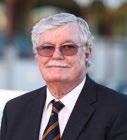
Mark Gray FAICD
Mr Gray was appointed as an Appointed Director to the Board in December 2014, reappointed in February 2019 and reappointed again in January 2022. He is a Company Director with extensive experience in the corporate, government and community sectors. He is a former Chief Executive Officer of Queensland Treasury, the Queensland Competition Authority and the Queensland Independent Commission of Audit and has also held senior executive roles with Macquarie Group and BDO. Mr Gray is Chairman of the Finance, Governance, Audit and Risk Committee. He holds an Honorary Doctorate from Griffith University, as well as a Bachelor of Economics (First Class Honours) from the University of Queensland.

John Salter
Mr Salter was elected as a Director to the Board in March 2017 and was reappointed in 2020 for a further three-year term. He is a Director of Accord HR, a specialised human resources and industrial relations consultancy. He is a Fellow of the Australian Human Resources Institute and has held senior management and advocacy roles within employer associations and private sector corporations. Mr Salter played grade cricket in Brisbane with the Eastern Suburbs club for 27 seasons, captaining its first-grade side in the 1980’s. He is also a former chair of the QC Grades Committee and was awarded Life Membership of the Easts/Redlands Cricket Club in 1989. A resident of the Gold Coast he is still active as a player in Veteran’s cricket and administrator, a local umpire and a junior coach. Mr Salter is a member of the Premier Grade Committee.
Ian Healy AO
Mr Healy was appointed as Director to the Board in July 2019 initially to cover a casual vacancy and was appointed as an Elected Director at the September 2019 AGM and reappointed again in September 2021. Ian has a storied career as a player, commentator, administrator and a successful businessman. He represented Queensland from 1986-1999, represented Australia from 1988 to 1999, Channel Nine Cricket commentator from 1999-2019. Held the position of Chair of the Australian Cricketer’s Association from 2001-2005 and Chairman of the Bulls Masters from 2010 onwards. Mr Healy is a founding shareholder of the Australian Premier League and Brisbane Premier League which is a new amateur competition providing 800 extra playing opportunities for players. He is Chairman of the Recruitment and Retention Committee of the Board and the honorary Chair of Brisbane Heat. Mr Healy was awarded Life Member of Queensland Cricket Association in 2015.

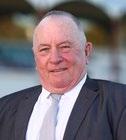
Jonathan Dooley FAICD
Mr Dooley was appointed as an Appointed Director to the Board in December 2019 following a long-standing association with cricket as a player, coach and President of Western Suburbs District Cricket Club. Between July 2013 and December 2019, Mr Dooley was an Independent Member of the Finance, Governance, Audit and Risk Committee. Mr Dooley is co-founder of Vincents, a Financial and Economic Advisory firm and is currently their Executive Chair. He is also Chair of QInsure Limited and a Director of Redkite (a National Children’s Cancer Charity).
Juanita Maiden GAICD (resigned 1 July 2023)
Ms Maiden was appointed as an Appointed Director to the Board in December 2019 and has a Bachelor of Laws and a Bachelor of Commerce from the University of Queensland. She is a graduate of the Australian Institute of Company Directors and is a Senior Associate in the sports law team at Mullins Lawyers. Ms Maiden is currently Chairperson of the AFL Queensland Tribunal and is a member of the South-East Queensland Rugby League Board. She has held previous positions as CEO of Cairns Taipans National Basketball League Club and as a Director at Events Cairns.
Darren Frakes (elected 13 September 2022)
Mr Frakes was elected a member of the QCA Board at the September 2022 AGM. Mr Frakes has been heavily involved in cricket as a player, coach and administrator for most of his life. He served as Treasurer of the Queensland Country Cricket Association from 2016 to 2022. Mr Frakes is the Owner Manager of the BOQ in Aitkenvale and has a long career in the Banking and Finance industry.
Chief Executive Officer
Mr Terry Svenson
Mr Svenson was appointed Acting Chief Executive Officer at Queensland Cricket in June 2019 and was confirmed as Chief Executive Officer by the Board in August 2019.


Company secretary
Mr Ian Mitchell was appointed to the role of Company Secretary in August 2019.
Directors' remuneration
The total amount paid to Directors for the year ended 30 June 2023 was nil (2022: nil).
Queensland nominee on the Cricket Australia Board
Mr Greg Rowell was nominated as the Queensland representative Independent Director in early 2021 and was appointed by CA in June 2021 for a three-year term. Greg attended both the QC AGM and OGM’s during the financial year.
Queensland Cricket Association Ltd Directors' report
Queensland Cricket Association Ltd
Directors' report
30 June 2023
The number of meetings of the Company's Board of Directors held during the year ended 30 June 2023, and the number of meetings attended by each Director were:
(a) Insurance of officers (continued)
The liabilities insured are legal costs that may be incurred in defending civil or criminal proceedings that may be brought against the officers in their capacity as officers of entities in the Group, and any other payments arising from liabilities incurred by the officers in connection with such proceedings. This does not include such liabilities that arise from conduct involving a willful breach of duty by the officers or the improper use by the officers of their position or of information to gain advantage for themselves or someone else or to cause detriment to the Group It is not possible to apportion the premium between amounts relating to the insurance against legal costs and those relating to other liabilities.
(b) Indemnity of auditors
Queensland Cricket Association Ltd has agreed to indemnify its auditor, PricewaterhouseCoopers to the extent permitted by law, against any claim by a third party arising from Queensland Cricket Association Ltd's breach of their agreement. The indemnity stipulates that Queensland Cricket Association Ltd will meet the full amount of any such liabilities including a reasonable amount of legal costs.
Proceedings on behalf of the Group
During the year ended 30 June 2023, the Board held 6 Board full meetings as well as the AGM on 13 September 22 and the OGM on 28 March 2023.
At the time of reporting the following Committees are operating under the auspices of the QC Board:
• Finance, Governance, Audit and Risk Committee;
• Recruitment and Retention Committee;
• Nominations Committee; and
• QC Foundation Committee.
During the year ended 30 June 2023, the following operational Committees have been in operation:
• Premier Cricket Committee;
• Conducts Committee;
• Appeals Tribunal; and
• First Nations Cricket Advisory Committee.
Contributions on winding up of the Company
No option to acquire shares in the Group has been granted to any person. No shares have been issued during the financial year or since the end thereof by virtue of the exercise of any options. There are no unissued shares under option at the date of this report.
In the event of the Queensland Cricket Association Ltd being wound up, ordinary members are required to contribute a maximum of $10 each.
Insurance of officers and indemnities
(a) Insurance of officers
During the financial year Queensland Cricket Association Ltd paid a premium of $15,287 to insure the Directors and Secretaries of the Group
No person has applied to the Court under section 237 of the Corporations Act 2001 for leave to bring proceedings on behalf of the Group, or to intervene in any proceedings to which the Group is a party, for the purpose of taking responsibility on behalf of the Group for all or part of those proceedings
No proceedings have been brought or intervened in on behalf of the Group with leave of the Court under section 237 of the Corporations Act 2001.
Auditor's independence declaration
A copy of the auditor's independence declaration as required under section 307C of the Corporations Act 2001 is set out on page 9.
Rounding of amounts
The Group is of a kind referred to in ASIC Legislative Instrument 2016/191, relating to the 'rounding off' of amounts in the directors' report Amounts in the directors' report have been rounded off in accordance with the instrument to the nearest dollar
This report is made in accordance with a resolution of the Directors.
C Simpson Chair Brisbane 10 August 2023
Queensland Cricket Association Ltd
Corporate governance statement
30 June 2023
Queensland Cricket Association Ltd is a public company limited by guarantee, incorporated under the Corporations Act 2001 The ultimate responsibility for the governance of the Company rests with the Board of Directors. This Governance Statement outlines how the Board meets that responsibility.
As lead auditor for the audit of Queensland Cricket Association Ltd for the year ended 30 June 2023, I declare that to the best of my knowledge and belief, there have been:
(a) no contraventions of the auditor independence requirements of the Corporations Act 2001 in relation to the audit; and
(b) no contraventions of any applicable code of professional conduct in relation to the audit.
This declaration is in respect of Queensland Cricket Association Ltd and the entities it controlled during the period.
The Members of the Association approved the new QCA Constitution at a Special Meeting of Members held on 13 September 2022. The new Constitution was prepared by a Constitution Working Group headed by Deputy Chair Kirsten Pike, Director John Salter, FGAR Committee Member and SRDCC Auditor John Keating and CQCI president Greg Michel with support from John Mullins of QC’s Legal Adviser Mullins Lawyers. The Constitution was modernised to reflect the requirements of the Corporation Act 2001, reviewed and updated the QCA Objects, allowed for the provision of one additional Appointed Director to allow for the additional skills, experience and diversity required for the Board in the lead up to the 2032 Olympics to be held in Brisbane.
During the year, the Board continued to access the Board Charter and Guidelines through the Board Manual via the Diligent Portal Resource Centre.
The Charter and Guidelines provides the Board, the governance framework for how the Board operates. It details the main corporate governance practices and key policies in place for the organisation and to which the Board collectively and the Directors individually are committed. It was updated to reflect the change in the QCA Constitution and approved by the Board at the December 2022 meeting.
The Charter and Guidelines are an important section of the Queensland Cricket Board Manual, and provides an important framework, governance and reference for the effective operations of the Board and the organisation as a whole. As a top-level process, the Charter:
• Defines the Board’s role and responsibilities, composition, structure and the overall governance principles and practices that apply to the Board and the organisation;
• Contains relevant operational details concerning the manner of how the Board operates, including meetings, establishment of committees and key policies which the Board are required to oversight for the effective and efficient operation of the Board and the Executive;
• Encourages the Board to focus on how they can continuously improve their governance processes for the benefit of the organisation;

• Provides a forum for discussing ‘hard-to-mention’ governance issues; and
• Serves as a team development vehicle for both the Board and the senior management team, helping to clarify roles and expectations.
Any new Directors are provided a Board Induction program and Directors have been encouraged to undertake the AICD Company Directors course for their individual development.
This financial report is the consolidated financial report of the consolidated entity consisting of Queensland Cricket Association Ltd and its subsidiary. A list of subsidiaries is included in note 20 The financial report is presented in the Australian dollar ($).
Queensland Cricket Association Ltd is a company limited by guarantee, incorporated and domiciled in Australia. Queensland Cricket Association Ltd's wholly owned entity, Brisbane Heat Pty Ltd, is an Australian proprietary company, limited by shares. The Group's registered office and principal place of business is:
1 Greg Chappell Street, Albion, Queensland, 4010.
A description of the nature of the consolidated entity's operations and its principal activities is included in the directors' report on page 1, which is not part of this financial report
The financial report was authorised for issue by the Directors on 10 August 2023 The Directors have the power to amend and reissue the financial report
The above consolidated statement of profit or loss and other comprehensive income should be read in conjunction with the accompanying notes.
This note provides a list of all significant accounting policies adopted in the preparation of this consolidated financial report These policies have been consistently applied to all the years presented, unless otherwise stated. The financial report is for the Group consisting of Queensland Cricket Association Ltd and its wholly owned subsidiary, Brisbane Heat Pty Ltd.
(a) Basis of preparation
This general purpose financial report has been prepared in accordance with Australian Accounting Standards and Interpretations issued by the Australian Accounting Standards Board and the Corporations Act 2001 Queensland Cricket Association Ltd is a not-for-profit entity for the purpose of preparing the financial report
(
) Compliance with Australian Accounting Standards - Simplified Disclosure Requirements
The consolidated financial report of the Group complies with Australian Accounting Standards - Simplified Disclosures as issued by the Australian Accounting Standards Board (AASB).
(ii) Historical cost convention
The financial report has been prepared on a historical cost basis.
(iii) Comparatives
Where necessary, comparative information has been reclassified and repositioned for consistency with current year disclosures.
(iv) New standards and interpretations not yet adopted
Certain new accounting standards, amendments to accounting standards and interpretations have been published that are not mandatory for 30 June 2023 reporting periods and have not been early adopted by the Group These standards, amendments or interpretations are not expected to have a material impact on the entity in the current or future reporting periods and on foreseeable future transactions.
(v) Critical accounting estimates
The preparation of the financial report requires the use of certain critical accounting estimates. It also requires management to exercise its judgement in the process of applying the Group's accounting policies.
(vi) Functional and presentation currency
Items included in the financial report are measured using the currency of the primary economic environment in which the entity operates ('the functional currency'). The consolidated financial report is presented in Australian dollars ($), which is Queensland Cricket Association Ltd's functional and presentation currency.
(b) Rounding of amounts
The Group is of a kind referred to in ASIC Legislative Instrument 2016/191, relating to the 'rounding off' of amounts in the financial report Amounts in the financial report have been rounded off in accordance with the instrument to the nearest thousand dollars, or in certain cases, the nearest dollar.
(c) Principles of consolidation and equity accounting
The consolidated financial report incorporates the assets and liabilities of the subsidiary of Queensland Cricket Association Ltd ('Company' or parent entity') as at 30 June 2023 and the results of the subsidiary for the year then ended. Queensland Cricket Association Ltd and its subsidiary, together, are referred to in this financial report as the Group or the consolidated entity.
(
) Subsidiaries
Subsidiaries are all entities (including structured entities) over which the Group has control. The Group controls an entity where the Group is exposed to, or has rights to, variable returns from its involvement with the entity and has the ability to affect those returns through its power to direct the activities of the entity. Subsidiaries are fully consolidated from the date on which control is transferred to the Group They are deconsolidated from the date that control ceases. 16
Queensland Cricket Association Ltd
Notes to the consolidated financial statements
30 June 2023
(continued)
Summary
(c) Principles of consolidation and equity accounting (continued)
( ) Subsidiaries (continued)
Intercompany transactions, balances and unrealised gains on transactions between group companies are eliminated. Unrealised losses are also eliminated unless the transaction provides evidence of an impairment of the transferred asset. Accounting policies of the subsidiary have been changed where necessary to ensure consistency with the policies adopted by the Group
(d) Revenue recognition
Revenue from contracts with customers is recognised by reference to each distinct performance obligation in the contract with the customer. Revenue from contracts with customers is measured at its transaction price, being the amount of consideration which the Group expects to be entitled in exchange for transferring promised goods or services to a customer, net of goods and service tax, returns, rebates and discounts. Transaction price is allocated to each performance obligation on the basis of the relative standalone selling prices of each distinct good or services promised in the contract. Depending on the substance of the contract, revenue is recognised when the performance obligation is satisfied, which may be at a point in time or over time.
The Group recognises other revenue when the amount of revenue can be reliably measured, it is probable that future economic benefits will flow to the entity and specific criteria have been met for each of the Group's activities. The Group bases its estimates on historical results, taking into consideration the type of customer, the type of transaction and the specifics of each arrangement.
In relation to the Big Bash Seasons (BBL 10 and BBL 11), an agreement specific to BBL 10 and BBL 11 was reached between the State Associations and Cricket Australia for the staging and delivery of the season in response to the COVID-19 situation in Australia. Regular season and the finals match involving the Brisbane Heat that were held in Queensland were treated in accordance with the accounting policy detailed in this policy note which did not change the accounting treatment from prior periods. Associated match costs were recognised in their respective expense categories.
Neutral matches, (not involving the Brisbane Heat) held in Queensland (all held at Metricon Stadium) were settled in accordance with the venue hire agreement with the venue operator on a net basis taking into consideration ticket sales and associated costs. The final net amounts paid to the venue operator during the season for neutral matches are presented in state cricket match expenses in the consolidated statement of profit or loss and other comprehensive income
The State Associations and Cricket Australia negotiated an equalisation arrangement where the BBL 10 season overall net financial results would be shared equally between the parties. For the year ended 30 June 2021 in Queensland Cricket’s case, this resulted in a net payment to other State Associations and Cricket Australia and is presented in state cricket match expenses in the consolidated statement of profit or loss and other comprehensive income For the year ended 30 June 2022 in Queensland Cricket’s case, this resulted in a net payment from other State Associations and Cricket Australia and is presented in state cricket match expenses in the consolidated statement of profit or loss and other comprehensive income
(e) Government grants
Where grant income arises from an agreement which is enforceable and contains sufficiently specific performance obligations then the revenue is recognised when control of each performance obligations is satisfied, in accordance with AASB15. The performance obligations are varied based on the agreement. Payment terms vary depending on the terms of the grant, cash is received upfront for some grants and on the achievement of certain payment milestones for others. Each performance obligation is considered to ensure that the revenue recognition reflects the transfer of control and within grant agreements there may be some performance obligations where control transfers at a point in time and others which have continuous transfer of control over the life of the contract. Where control is transferred over time, generally the input methods being either costs or time incurred are deemed to be the most appropriate methods to reflect the transfer of benefit.
Queensland Cricket Association Ltd
Notes to the consolidated financial statements
30 June 2023 (continued)
(e) Government grants (continued)
Assets arising from grants in the scope of AASB 1058 are recognised at the assets fair value when the asset is received or over the construction period. The Group considers whether there are any related liability or equity items associated with the asset which are recognised in accordance with the relevant accounting standard. Once the assets and liabilities have been recognised then income is recognised for any remaining asset value at the time that the asset is received.
(f) Income tax
The consolidated entity is exempt from the payment of income tax under the provisions of section 50-45 of the Income Tax Assessment Act 1997
(g) Leases
The Group leases various equipment and vehicles. Rental contracts are typically made for fixed periods of one year to 5 years, but may have extension options as described below. The Group leases the Allan Border Precinct at Albion, which is leased from the Brisbane City Council (BCC) for a 20 year term from 1 April 2017 with a 20 year option thereafter.
Contracts may contain both lease and non-lease components. The Group allocates the consideration in the contract to the lease and non-lease components based on their relative stand-alone prices. However, for leases of real estate for which the Group is a lessee, it has elected not to separate lease and non-lease components and instead accounts for these as a single lease component.
Lease terms are negotiated on an individual basis and contain a wide range of different terms and conditions. The lease agreements do not impose any covenants other than the security interests in the leased assets that are held by the lessor. Leased assets may not be used as security for borrowing purposes.
Leases are recognised as a right-of-use asset and a corresponding liability at the date at which the leased asset is available for use by the Group
Assets and liabilities arising from a lease are initially measured on a present value basis. Lease liabilities include the net present value of the following lease payments:
• fixed payments (including in-substance fixed payments), less any lease incentives receivable,
• variable lease payment that are based on an index or a rate, initially measured using the index or rate as at the commencement date,
• amounts expected to be payable by the Group under residual value guarantees,
• the exercise price of a purchase option if the Group is reasonably certain to exercise that option, and
• payments of penalties for terminating the lease, if the lease term reflects the Group exercising that option.
Lease payments to be made under reasonably certain extension options are also included in the measurement of the liability.
The lease payments are discounted using the interest rate implicit in the lease. If that rate cannot be readily determined, which is generally the case for leases in the Group, the lessee’s incremental borrowing rate is used, being the rate that the individual lessee would have to pay to borrow the funds necessary to obtain an asset of similar value to the right-of-use asset in a similar economic environment with similar terms, security and conditions.
To determine the incremental borrowing rate, the Group
• where possible, uses recent third-party financing received by the individual lessee as a starting point, adjusted to reflect changes in financing conditions since third-party financing was received,
• makes adjustments specific to the lease, eg term and security.
Queensland Cricket Association Ltd
Notes to the consolidated financial statements
30 June 2023
(continued)
(g) Leases (continued)
The Group is exposed to potential future increases in variable lease payments based on an index or rate, which are not included in the lease liability until they take effect. When adjustments to lease payments based on an index or rate take effect, the lease liability is reassessed and adjusted against the right-of-use asset.
Lease payments are allocated between principal and finance cost. The finance cost is charged to profit or loss over the lease period so as to produce a constant periodic rate of interest on the remaining balance of the liability for each period.
Right-of-use assets are measured at cost comprising the following:
• the amount of the initial measurement of lease liability,
• any lease payments made at or before the commencement date less any lease incentives received,
• any initial direct costs, and
• restoration costs.
Right-of-use assets are generally depreciated over the shorter of the asset's useful life and the lease term on a straight-line basis. If the Group is reasonably certain to exercise a purchase option, the right-of-use asset is depreciated over the underlying asset’s useful life.
Payments associated with short-term leases of equipment and vehicles and all leases of low-value assets are recognised on a straight-line basis as an expense in profit or loss. Short-term leases are leases with a lease term of 12 months or less.
Extension and termination options
Extension and termination options are included in a number of property and equipment leases across the Group These are used to maximise operational flexibility in terms of managing the assets used in the Group’s operations. The majority of extension and termination options held are exercisable only by the Group and not by the respective lessor.
(h)
For the purpose of presentation in the consolidated statement of cash flows, cash and cash equivalents includes cash on hand, deposits held at call with financial institutions, other short-term, highly liquid investments with original maturities of three months or less that are readily convertible to known amounts of cash and which are subject to an insignificant risk of changes in value.
Intangible assets are tested annually for impairment, or more frequently, if events or changes in circumstances indicate that they might be impaired. Other assets are tested for impairment whenever events or changes in circumstances indicate that the carrying amount may not be recoverable. An impairment loss is recognised for the amount by which the asset's carrying amount exceeds its recoverable amount. The recoverable amount is the higher of an asset's fair value less costs of disposal and value in use. For the purposes of assessing impairment, assets are grouped at the lowest levels for which there are separately identifiable cash inflows which are largely independent of the cash inflows from other assets or groups of assets (cash-generating units). Non-financial assets that suffered an impairment are reviewed for possible reversal of the impairment at the end of each reporting year
Queensland Cricket Association Ltd
Notes to the consolidated financial statements
30 June 2023 (continued)
(j) Trade receivables
Trade receivables are amounts due from customers for goods sold or services performed in the ordinary course of business. They are generally due for settlement within 30 days and are therefore all classified as current. Trade receivables are recognised initially at the amount of consideration that is unconditional unless they contain significant financing components, when they are recognised at fair value.
The Group holds the trade receivables with the objective of collecting the contractual cash flows and therefore measures them subsequently at amortised cost using the effective interest method. Due to the short-term nature of trade and other receivables, their carrying amount is considered to be the same as their fair value.
The Group applies the AASB 9 simplified approach to measuring expected credit losses which uses a lifetime expected loss allowance for all trade receivables.
Inventories held for distribution are measured at the lower of cost or net realisable value. The cost of inventories acquired at no cost, or for nominal consideration, is the current replacement cost as at the date of acquisition.
The Group classifies its financial assets in the following measurement categories:
• those to be measured subsequently at fair value (either through OCI or through profit or loss), and
• those to be measured at amortised cost.
The classification depends on the entity’s business model for managing the financial assets and the contractual terms of the cash flows.
For assets measured at fair value, gains and losses will either be recorded in profit or loss or OCI. For investments in equity instruments that are not held for trading, this will depend on whether the Group has made an irrevocable election at the time of initial recognition to account for the equity investment at fair value through other comprehensive income (FVOCI).
Debt instruments
Subsequent measurement of debt instruments depends on the Group’s business model for managing the asset and the cash flow characteristics of the asset. There are three measurement categories into which the Group classifies its debt instruments:
• Amortised cost: Assets that are held for collection of contractual cash flows where those cash flows represent solely payments of principal and interest are measured at amortised cost. Interest income from these financial assets is included in finance income using the effective interest rate method. Any gain or loss arising on derecognition is recognised directly in profit or loss and presented in other gains/(losses) together with foreign exchange gains and losses. Impairment losses are presented as separate line item in the consolidated statement of profit or loss and other comprehensive income
Queensland Cricket Association Ltd
Notes to the consolidated financial statements
30 June 2023 (continued)
(l) Investments and other financial assets (continued)
(ii) Measurement (continued)
Debt instruments (continued)
• FVOCI: Assets that are held for collection of contractual cash flows and for selling the financial assets, where the assets’ cash flows represent solely payments of principal and interest, are measured at FVOCI. Movements in the carrying amount are taken through OCI, except for the recognition of impairment gains or losses, interest income and foreign exchange gains and losses which are recognised in profit or loss. When the financial asset is derecognised, the cumulative gain or loss previously recognised in OCI is reclassified from equity to profit or loss and recognised in other gains/(losses). Interest income from these financial assets is included in finance income using the effective interest rate method. Foreign exchange gains and losses are presented in other gains/(losses) and impairment expenses are presented as separate line item in the consolidated statement of profit or loss and other comprehensive income
• FVPL: Assets that do not meet the criteria for amortised cost or FVOCI are measured at FVPL. A gain or loss on a debt investment that is subsequently measured at FVPL is recognised in profit or loss and presented net within other gains/(losses) in the period in which it arises.
Equity instruments
The Group subsequently measures all equity investments at fair value. Where the Group’s management has elected to present fair value gains and losses on equity investments in OCI, there is no subsequent reclassification of fair value gains and losses to profit or loss following the derecognition of the investment. Dividends from such investments continue to be recognised in profit or loss as other income when the Group’s right to receive payments is established.
Changes in the fair value of financial assets at FVPL are recognised in other gains/(losses) in the consolidated statement of profit or loss and other comprehensive income as applicable. Impairment losses (and reversal of impairment losses) on equity investments measured at FVOCI are not reported separately from other changes in fair value.
The Group assesses on a forward-looking basis the expected credit losses associated with its debt instruments carried at amortised cost and FVOCI. The impairment methodology applied depends on whether there has been a significant increase in credit risk.
For trade receivables, the Group applies the simplified approach permitted by AASB 9, which requires expected lifetime losses to be recognised from initial recognition of the receivables, see note 1(j) for further details.
Property, plant and equipment is stated at historical cost less depreciation. Historical cost includes expenditure that is directly attributable to the acquisition of the items.
Subsequent costs are included in the asset's carrying amount or recognised as a separate asset, as appropriate, only when it is probable that future economic benefits associated with the item will flow to the Group and the cost of the item can be measured reliably. The carrying amount of any component accounted for as a separate asset is derecognised when replaced. All other repairs and maintenance are charged to profit or loss during the reporting year in which they are incurred.
Depreciation is calculated using the straight-line and diminishing value methods to allocate their cost, net of their residual values, over their estimated useful lives or, in the case of leasehold improvements and certain leased plant and equipment, the shorter lease term as follows:
• Leasehold improvements
• Plant and equipment
4.3%
6.7% - 33%
• Motor vehicles 22.5% 21
Queensland Cricket Association Ltd
Notes to the consolidated financial statements
30 June 2023
(m) Property, plant and equipment (continued)
The assets' residual values and useful lives are reviewed, and adjusted if appropriate, at the end of each reporting year
An asset's carrying amount is written down immediately to its recoverable amount if the asset's carrying amount is greater than its estimated recoverable amount (note 1(i)).
Gains and losses on disposals are determined by comparing proceeds with carrying amount. These gains or losses are included in profit or loss.
(n) Intangible assets
Intangible assets are initially recognised at cost and subsequently measured at cost less amortisation and any impairment. The method and useful lives of finite life intangibles are reviewed annually. Changes in the expected pattern of consumption or useful life are accounted for prospectively by changing the amortisation method or period.
Right to access National Cricket Centre facilities
Under the conditions of a Queensland Government Grant, Queensland Cricket made a contribution to the National Cricket Centre construction costs of $5,000,000 and raised an Intangible Asset, representing its Right to Access the National Cricket Centre. This right facilitates Queensland Cricket’s use of the National Cricket Centre for a minimum of 2 days a week at commercial rates until the value of the Asset is extinguished. Accordingly, this Intangible Asset has a finite life. The National Cricket Centre opened on 12 November 2013.
The amortisation method used reflects the pattern in which the asset’s future economic benefits are expected to be consumed by the consolidated entity (i.e. the amortisation charge reflects the access and usage charges per year).
(o) Trade and other payables
These amounts represent liabilities for goods and services provided to the Group prior to the end of financial year which are unpaid. The amounts are unsecured and are usually paid within 30 days of recognition. Trade and other payables are presented as current liabilities unless payment is not due within 12 months from the reporting date. They are recognised initially at their fair value and subsequently measured at amortised cost using the effective interest method.
(p) Borrowings
Borrowings are initially recognised at fair value, net of transaction costs incurred. Borrowings are subsequently measured at amortised cost. Any difference between the proceeds (net of transaction costs) and the redemption amount is recognised in profit or loss over the year of the borrowings using the effective interest method. Fees paid on the establishment of loan facilities are recognised as transaction costs of the loan to the extent that it is probable that some or all of the facility will be drawn down. In this case, the fee is deferred until the draw-down occurs. To the extent there is no evidence that it is probable that some or all of the facility will be drawn down, the fee is capitalised as a prepayment for liquidity services and amortised over the year of the facility to which it relates.
Borrowings are classified as current liabilities unless the Group has an unconditional right to defer settlement of the liability for at least 12 months after the reporting year
(q) Provisions
Provisions are recognised when the Group has a present legal or constructive obligation as a result of past events, it is probable that an outflow of resources will be required to settle the obligation and the amount can be reliably estimated. Provisions are not recognised for future operating losses.
Provisions are measured at the present value of management's best estimate of the expenditure required to settle the present obligation at the end of the reporting year The discount rate used to determine the present value is a pre-tax rate that reflects current market assessments of the time value of money and the risks specific to the liability. The increase in the provision due to the passage of time is recognised as interest expense.
Queensland Cricket Association Ltd
Notes to the consolidated financial statements
30 June 2023
(continued)
(r) Employee benefits
( ) Short-term obligations
Liabilities for wages and salaries, including non-monetary benefits and accumulating sick leave that are expected to be settled wholly within 12 months after the end of the period in which the employees render the related service are recognised in respect of employees’ services up to the end of the reporting period and are measured at the amounts expected to be paid when the liabilities are settled. The liabilities for wages and salaries are presented as accruals in the consolidated balance sheet The liabilities for annual leave are presented as current employee benefit obligations in the consolidated balance sheet
(ii) Other long-term employee benefit obligations
The liabilities for long service leave and annual leave are not expected to be settled wholly within 12 months after the end of the period in which the employees render the related service. They are therefore measured as the present value of expected future payments to be made in respect of services provided by employees up to the end of the reporting period using the projected unit credit method. Consideration is given to expected future wage and salary levels, experience of employee departures and periods of service. Expected future payments are discounted using market yields at the end of the reporting period of corporate bonds with terms and currencies that match, as closely as possible, the estimated future cash outflows. Remeasurements as a result of experience adjustments and changes in actuarial assumptions are recognised in profit or loss.
The obligations are presented as current liabilities in the consolidated balance sheet if the entity does not have an unconditional right to defer settlement for at least twelve months after the reporting date, regardless of when the actual settlement is expected to occur.
(iii) Post-employment obligations
The Group pays contributions to publicly or privately administered defined contribution superannuation plans on a mandatory, contractual or voluntary basis. The Group has no further payment obligations once the contributions have been paid. The contributions are recognised as employee benefit expense when they are due. Prepaid contributions are recognised as an asset to the extent that a cash refund or a reduction in the future payments is available.
(iv) Termination benefits
Termination benefits are payable when employment is terminated before the normal retirement date, or when an employee accepts voluntary redundancy in exchange for these benefits. The Group recognises termination benefits at the earlier of the following dates: (a) when the Group can no longer withdraw the offer of those benefits; and (b) when the entity recognises costs for a restructuring that is within the scope of AASB 137 and involves the payment of terminations benefits. In the case of an offer made to encourage voluntary redundancy, the termination benefits are measured based on the number of employees expected to accept the offer. Benefits falling due more than 12 months after the end of the reporting period are discounted to present value.
(s) Reserves
Reserves are created from retained earnings and are set aside for specific purposes. Two current reserves exist, being for the future maintenance of the Allan Border Precinct and the National Cricket Campus Masterplan. The movement in reserves each year represents either amounts set aside or money expended. Reserves are held in cash at bank (note 5) but the use of this cash is restricted and can only be expended on approval from the Board.
(t) Goods and Services Tax (GST)
Revenues, expenses and assets are recognised net of the amount of associated GST, unless the GST incurred is not recoverable from the taxation authority. In this case, it is recognised as part of the cost of acquisition of the asset or as part of the expense.
Receivables and payables are stated inclusive of the amount of GST receivable or payable. The net amount of GST recoverable from, or payable to, the taxation authority is included with other receivables or payables in the consolidated balance sheet 23
Queensland Cricket Association Ltd
Notes to the consolidated financial statements 30 June 2023 (continued)
(t) Goods and Services Tax (GST) (continued)
Cash flows are presented on a gross basis. The GST components of cash flows arising from investing or financing activities which are recoverable from, or payable to the taxation authority, are presented as operating cash flows.
(u) Parent entity financial information
The financial information for the parent entity, Queensland Cricket Association Ltd, disclosed in note 25 has been prepared on the same basis as the consolidated financial report, except as set out below.
( ) Investments in subsidiaries
Investments in subsidiaries are accounted for at cost in the financial report of Queensland Cricket Association Ltd
The Group derives revenue from the transfer of services over time as follows:
The cash and cash equivalents balances include amounts which are held as restricted reserves. These deposits are subject to restrictions and are, therefore, not available for general use by the Group, as follows:
8 Financial assets at fair value through profit or loss (continued)
(a) Amounts recognised in profit or loss
During the year, the following gains/(losses) were recognised in profit or loss:
Fair value gains/(losses) on investments at FVPL recognised in other gains/(losses)
10
(a) Amounts recognised in the balance sheet
The consolidated balance sheet shows the following amounts relating to leases:
Future lease payments in relation to lease liabilities as at year end are as follows:
Additions to the right-of-use assets during the 2023 financial year were $71,603.
(b) Amounts recognised in the statement of profit or loss
The consolidated statement of profit or loss and other comprehensive income shows the following amounts relating to leases:
Depreciation charge of right-of-use assets
11
Queensland Cricket (QC) received a Queensland Government grant of $5,000,000 for the construction of Cricket Australia's National Cricket Centre in a previous reporting period. The National Cricket Centre opened on 12 November 2013. A condition of the grant is that QC has a right to access the National Cricket Centre facilities until the $5,000,000 has been fully extinguished. As at 30 June 2023 QC had used $2,152,244 (2022: $1,775,296) of the grant.
12 Trade and other payables
(a) Deferred income
Deferred income includes sponsorships and grant funding received where the performance obligations contained within the contracts have not been met at reporting date.
13 Provisions
movements in provisions have been recognised in the consolidated statement of profit or loss and other comprehensive income
14 Employee benefit obligations
The leave obligations cover the Group’s liabilities for long service leave and annual leave which are classified as either other long-term benefits or short-term benefits, as explained in note 1(r)
15 Reserves and retained earnings
( ) Nature and purpose of other reserves
National Cricket Campus Masterplan Reserve
This reserve was created in November 2016. This reserve is Queensland Cricket's contribution to the $18 million National Cricket Campus Masterplan. Queensland Cricket allocated National Cricket Campus Masterplan Reserve funds were drawn down during the year ended 30 June 2022, when the project commenced.
Allan Border Asset Maintenance Reserve
This reserve was established in June 2016 for funding future maintenance of the Allan Border Precinct.
Notes
(b) Retained earnings
Movements in retained earnings were as follows:
During the year the following fees were paid or payable for services provided by the auditor and its related practices:
Queensland Cricket Association Ltd
Notes to the consolidated financial statements
30 June 2023
Contingent rentals relate to a facilities usage charge to Cricket Australia for its use of Allan Border Precinct. Only the base rental is disclosed in the commitments receivable, as the facilities usage charge cannot be reliably estimated and, consequently, has been disclosed as contingent rental.
Future minimum payments in respect of contracted lease revenues according to the time they elapse and the expected date of receipt, receivable:
(a) Subsidiaries
Interests in subsidiaries are set out in note 20
(b) Key management personnel compensation
(a) Contingent liabilities
The Group had contingent liabilities at 30 June 2023 in respect of contributions to the player payment pool.
The Group, along with the other State Associations, is responsible for Australian Cricket Revenue (ACR) reporting to Cricket Australia (CA) whereby revenue earned by the Group over and above the agreed year ended 30 June 2023 budget baseline figure during the five-year period to 30 June 2024 will attract a 27.5% surcharge payable to the Player Payment Pool held by CA. The surcharge, if any, is the difference between Actual ACR and Baseline ACR over the five-year period to 30 June 2024
Any surcharge payable is likely to be due to CA after 30 June 2024 As at the date of this report, a draft ACR for the year ended 30 June 2023 has been submitted to CA which concludes that ACR contingent liability has not been triggered for the year ended 30 June 2023
(b) Contingent assets
The Group had no contingent assets at 30 June 2023 (2022: nil)
The Directors of Queensland Cricket were reimbursed $39,408 (2022: $38,097) for general expenses and this amount is included in the above.
(c) Transactions with other related parties
The following transactions occurred with related parties:
* In accordance with Queensland Cricket's By Laws, payments are made to members to assist with their costs. The level of distributions made to members reflect funding of activities undertaken by members in delivering cricket in Queensland. Queensland Cricket undertook transactions with each of the members during the year in the normal course of business.
Notes
19
(d) Outstanding balances arising from distributions
The following balances are outstanding at the end of the reporting year in relation to transactions with related parties:
(a) Summary financial information
Notes
The individual financial report for the parent entity, Queensland Cricket Association Ltd, shows the following aggregate amounts:
20 Interests in other entities
The consolidated financial report incorporates the assets, liabilities and results of the following principal subsidiary in accordance with the accounting policy described in note 1(c): Name
21 Members liability
The Company is limited by guarantee. The Constitution of the Company limits the liability of members to the sum of $10 in the event of the Company being wound up.
22 Arthur Dibdin Memorial Fund
The Arthur Dibdin Memorial Fund is included in the balance of Members Funds but is not available to be used for the benefit of members. The fund had a balance of $500 as at 30 June 2023 (2022: $500)
23 Economic dependency
The Group is economically dependent upon Cricket Australia in respect to grants received.
24 Events occurring after the reporting period
No matter or circumstance has occurred subsequent to year end that has significantly affected, or may significantly affect, the operations of the Group the results of those operations or the state of affairs of the Group or economic entity in subsequent financial years.
(continued)
Queensland Cricket Association Ltd Directors' declaration

30 June 2023
In the Directors' opinion:
(a) The financial report and notes set outon pages 11 to 34 are in accordance with the Corporations Act 2001, including:
(i) complying with Accounting Standards - General PurposeFinancial Statements - Simplified Disclosures, the Corporations Regulations 2001 and other mandatory professional reporting requirements, and
(ii) Giving a true and fair view of the consolidated entity'sfinancial position asat30 June 2023andof its performance forthe financial year ended on that date, and
(b) There are reasonable grounds to believe that the Group will be able to pay its debts asand when they become dueand payable
This declaration is made in accordance with a resolution of the Directors.
10 August 2023
C Simpson Chair BrisbaneTo the members of Queensland Cricket Association Ltd
Our opinion
In our opinion:
The accompanying financial report of Queensland Cricket Association Ltd (the Company) and its controlled entities (together the Group) is in accordance with the Corporations Act 2001, including:
(a) giving a true and fair view of the Group's financial position as at 30 June 2023 and of its financial performance for the year then ended
(b) complying with Australian Accounting Standards - Simplified Disclosures and the Corporations Regulations 2001
What we have audited
The Group financial report comprises:
● the consolidated balance sheet as at 30 June 2023
● the consolidated statement of changes in equity for the year then ended
● the consolidated statement of cash flows for the year then ended
● the consolidated statement of profit or loss and other comprehensive income for the year then ended
● the notes to the consolidated financial statements, which include significant accounting policies and other explanatory information
● the directors’ declaration.
Basis for opinion
We conducted our audit in accordance with Australian Auditing Standards. Our responsibilities under those standards are further described in the Auditor’s responsibilities for the audit of the financial report section of our report.
We believe that the audit evidence we have obtained is sufficient and appropriate to provide a basis for our opinion.
Independence
We are independent of the Group in accordance with the auditor independence requirements of the Corporations Act 2001 and the ethical requirements of the Accounting Professional & Ethical Standards Board’s APES 110 Code of Ethics for Professional Accountants (including Independence Standards) (the Code) that are relevant to our audit of the financial report in Australia. We have also fulfilled our other ethical responsibilities in accordance with the Code.
Other information
The directors are responsible for the other information. The other information comprises the information included in the annual report for the year ended 30 June 2023, but does not include the financial report and our auditor’s report thereon.
Our opinion on the financial report does not cover the other information and accordingly we do not express any form of assurance conclusion thereon through our opinion on the financial report.
In connection with our audit of the financial report, our responsibility is to read the other information and, in doing so, consider whether the other information is materially inconsistent with the financial report or our knowledge obtained in the audit, or otherwise appears to be materially misstated.
If, based on the work we have performed on the other information that we obtained prior to the date of this auditor’s report, we conclude that there is a material misstatement of this other information, we are required to report that fact. We have nothing to report in this regard.
The directors of the Company are responsible for the preparation of the financial report that gives a true and fair view in accordance with Australian Accounting Standards - Simplified Disclosures and the Corporations Act 2001 and for such internal control as the directors determine is necessary to enable the preparation of the financial report that gives a true and fair view and is free from material misstatement, whether due to fraud or error.
In preparing the financial report, the directors are responsible for assessing the ability of the Group to continue as a going concern, disclosing, as applicable, matters related to going concern and using the going concern basis of accounting unless the directors either intend to liquidate the Group or to cease operations, or have no realistic alternative but to do so.
Our objectives are to obtain reasonable assurance about whether the financial report as a whole is free from material misstatement, whether due to fraud or error, and to issue an auditor’s report that includes our opinion. Reasonable assurance is a high level of assurance, but is not a guarantee that an audit conducted in accordance with the Australian Auditing Standards will always detect a material misstatement when it exists. Misstatements can arise from fraud or error and are considered material if, individually or in the aggregate, they could reasonably be expected to influence the economic decisions of users taken on the basis of the financial report.
A further description of our responsibilities for the audit of the financial report is located at the Auditing and Assurance Standards Board website at: http://www.auasb.gov.au/auditors_responsibilities/ar3.pdf. This description forms part of our auditor's report.
PricewaterhouseCoopers

